Rickubis Bird Page #2b: Eagles page 1! Page 2
, Page 3
This
page was born 03/30/2019 (split from a page born born 09/17/2006.). Rickubis designed
it. (such as it
is.) Last update: 07/24/2023
Images
and contents on this page copyright ©2002-2023 Richard M.
Dashnau
Go back to my home page,
Welcome
to rickubis.com
Go
back to the RICKUBISCAM page.
----------------------------------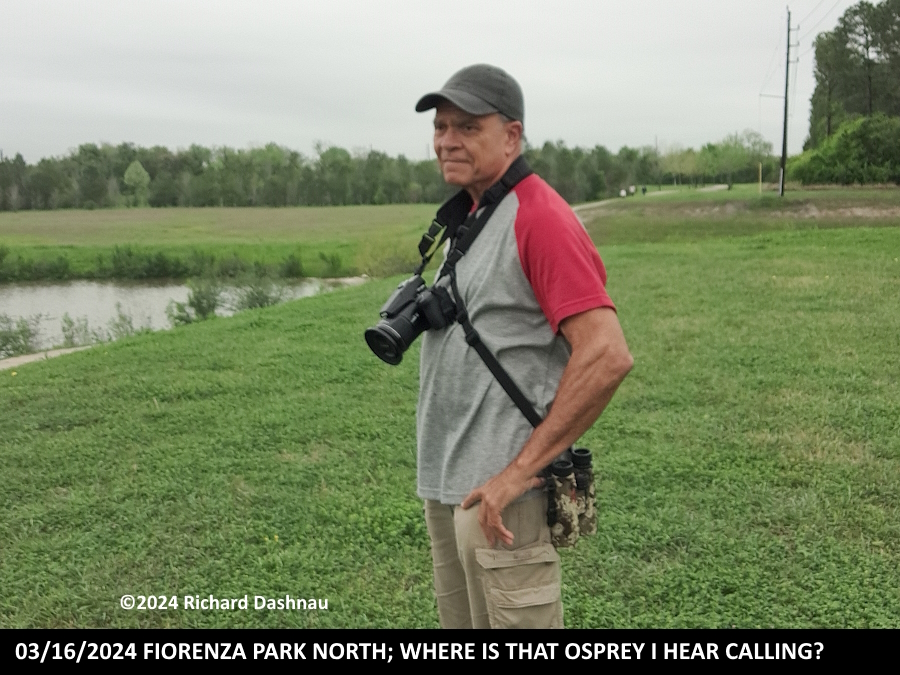
Welcome
to Brazos Bend State Park. That's me on the trail at Fiorenza Park
watching an Eagle 6/3/2023. I was just a child when the number of Eagle
nests in the U.S. was only 417...in the lower 48 states.
I never expected to see
Bald Eagles at all where I live and play, but here they
are! I'm sharing
many of my pictures and videos of Eagles on my Eagle pages.
I was at
Fiorenza Park on the morning of 12/24/2021.
I got there at about 8am, and I had just gotten out of the car when
I
noticed a white speck in the field a few hundred yards Northwest of me.
It was a Bald Eagle! I took pictures from so far.
I'd
turned to check something, and found that the Eagle
had taken off.
Through the camera, I could see that the Eagle was being chased by a
couple smaller birds, maybe crows. The images below are a mixture of
photos and frames
from the video. The video clip can be seen at
this link.
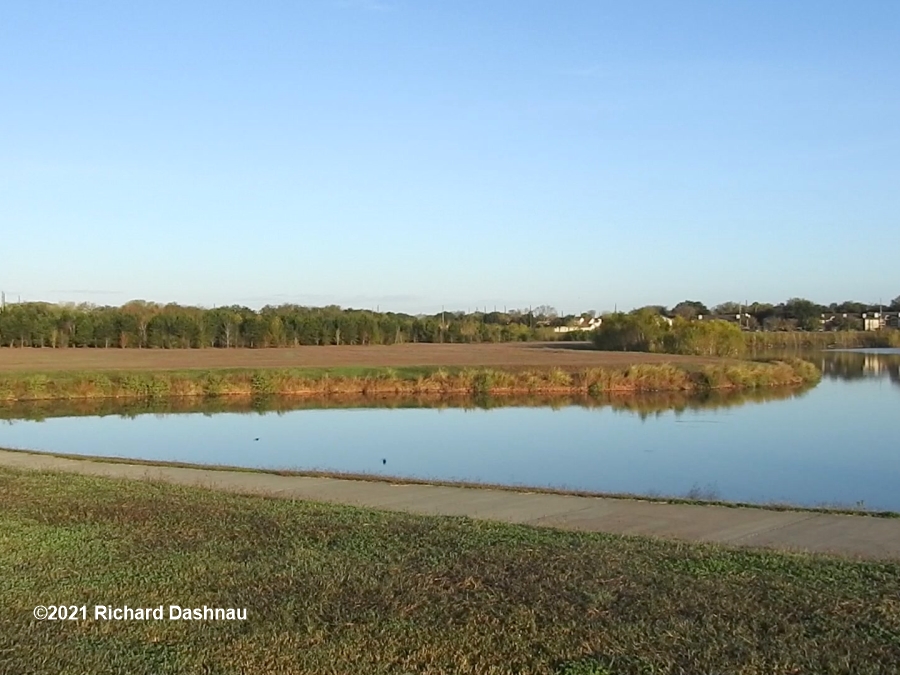
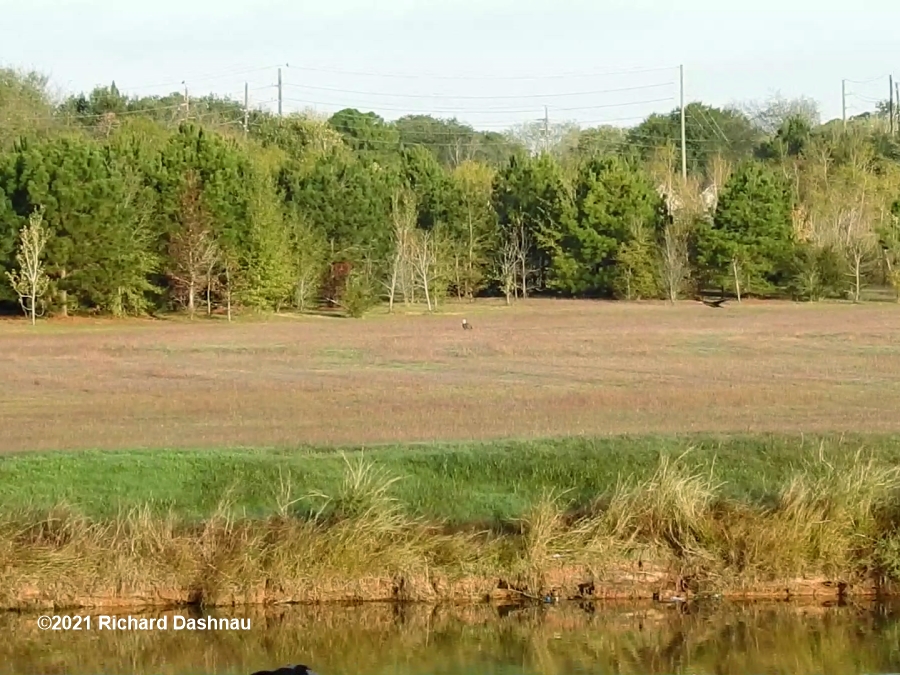
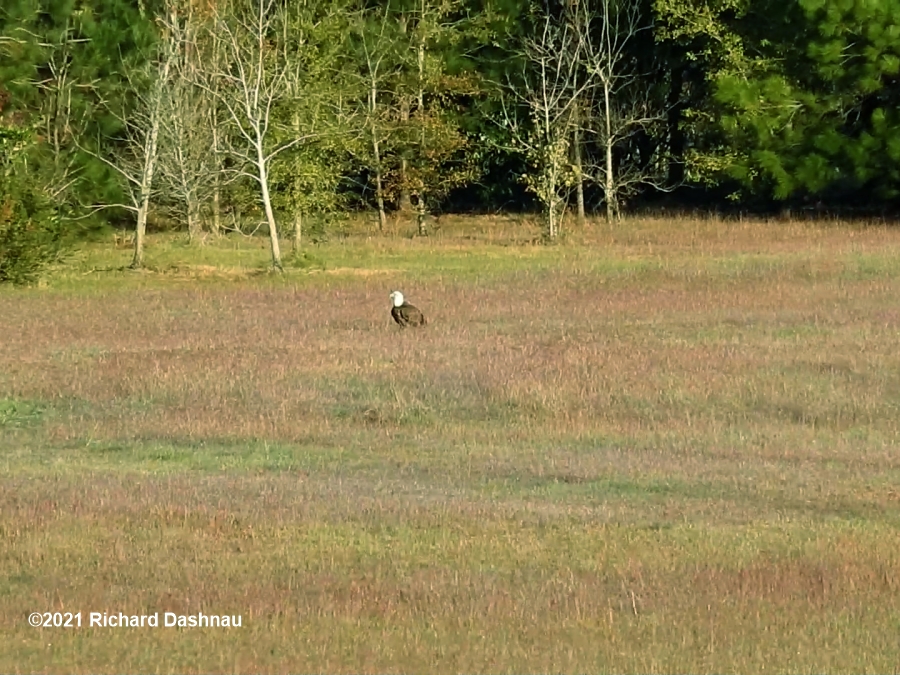
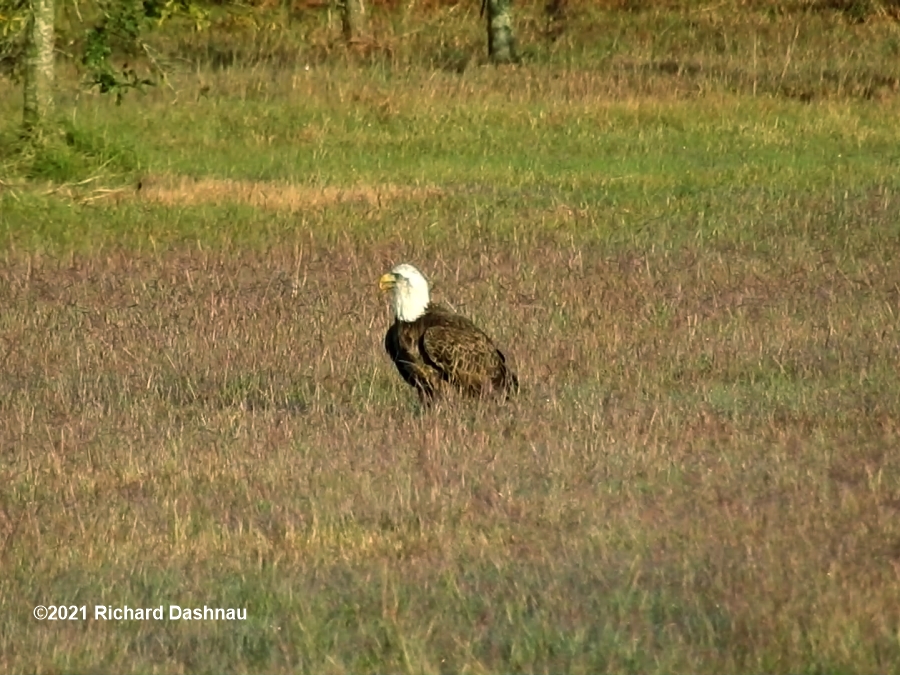
Beautiful morning! Out in the field--
--white dot on a
brown dot.
There
it is.
Eagle in the morning sun.
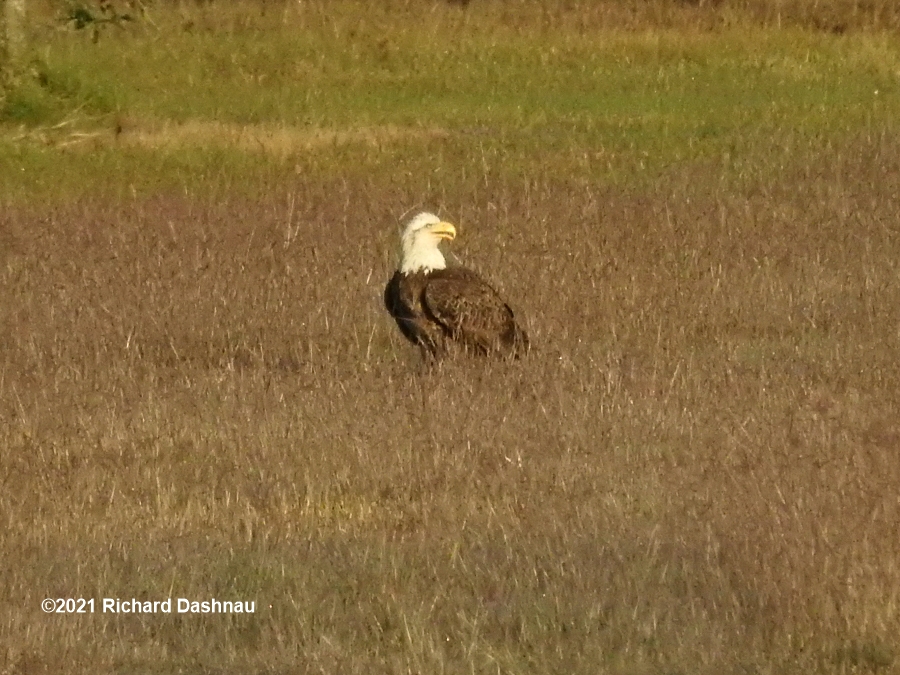
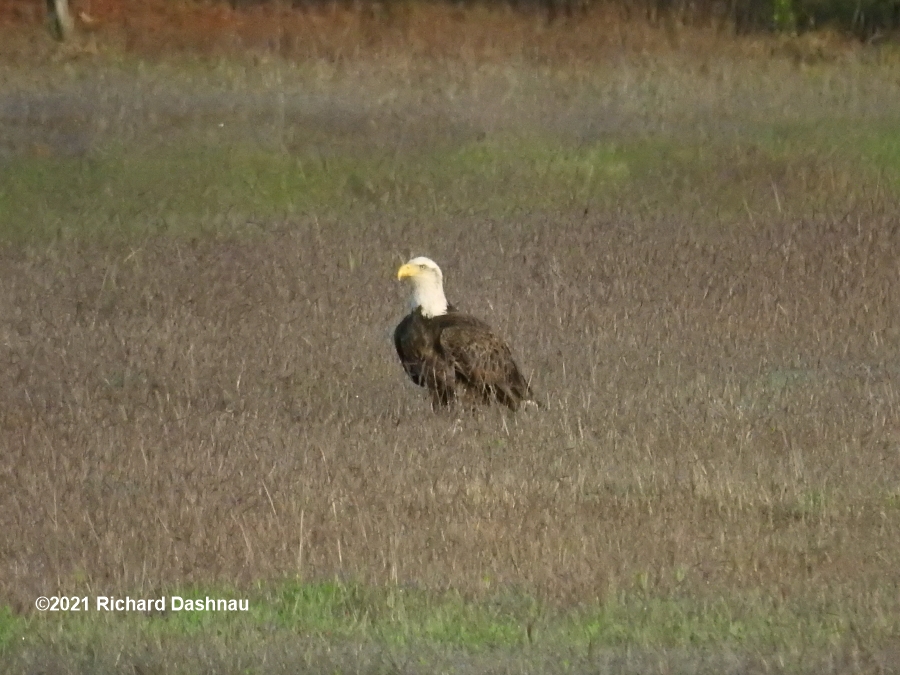
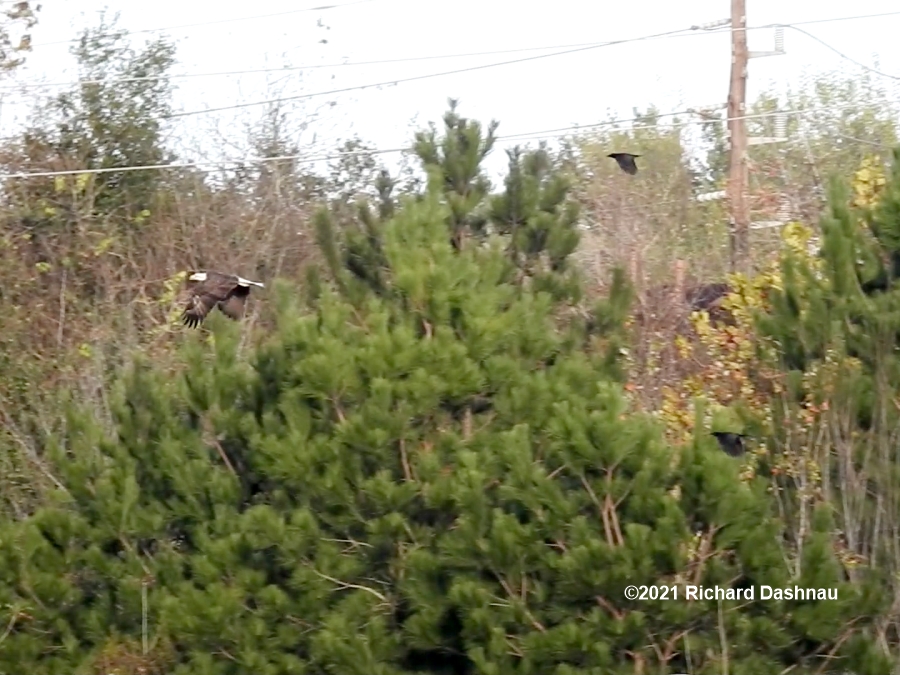
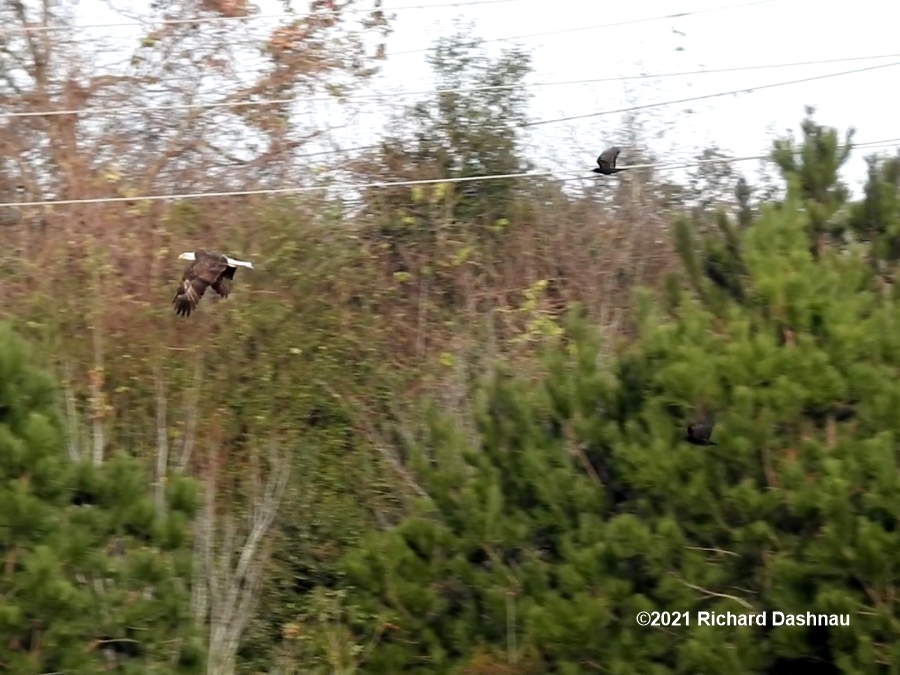
Eagle being chased by two
birds.
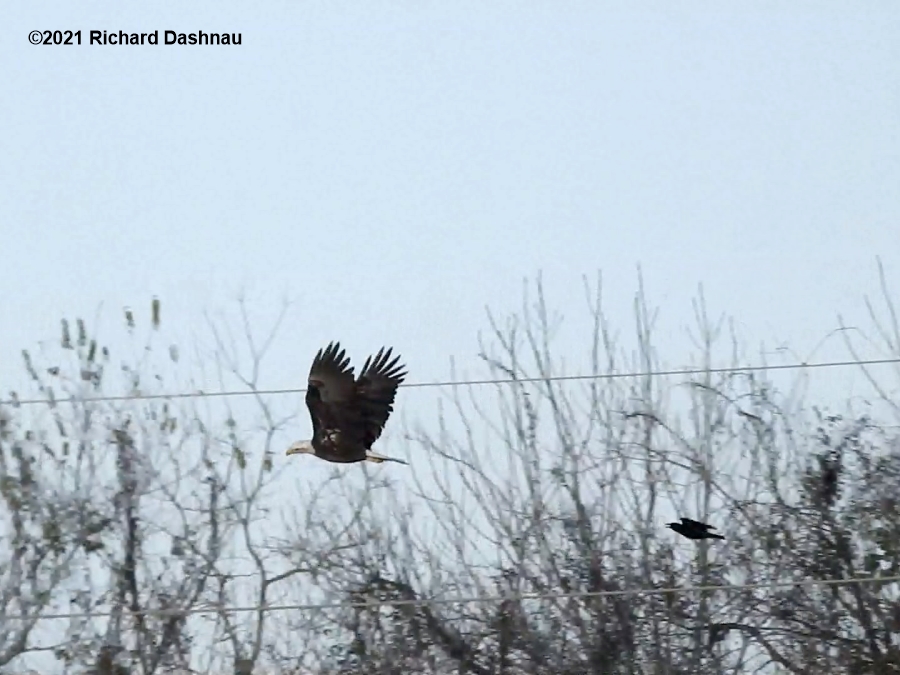
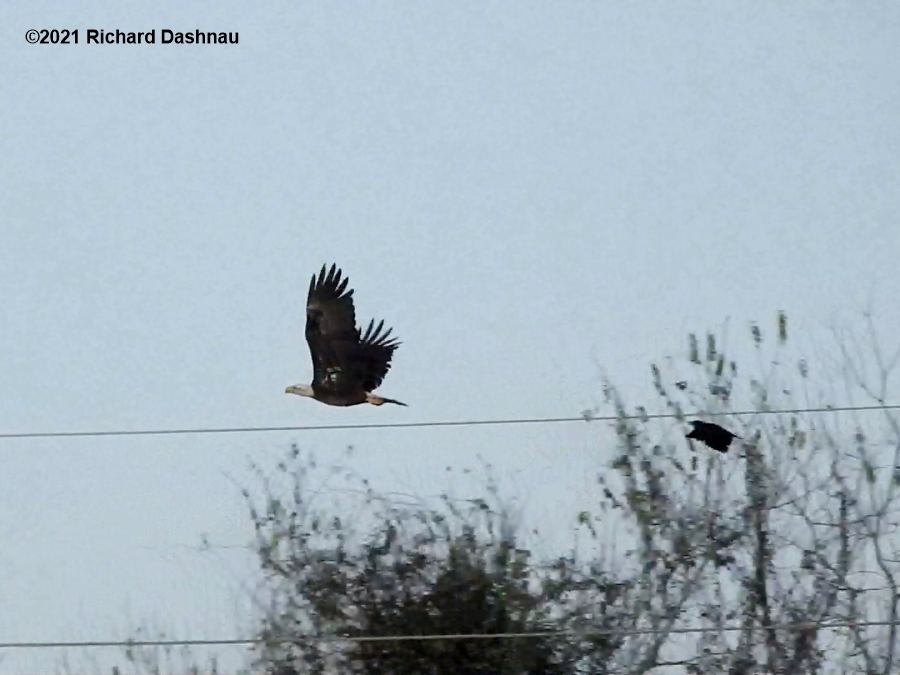
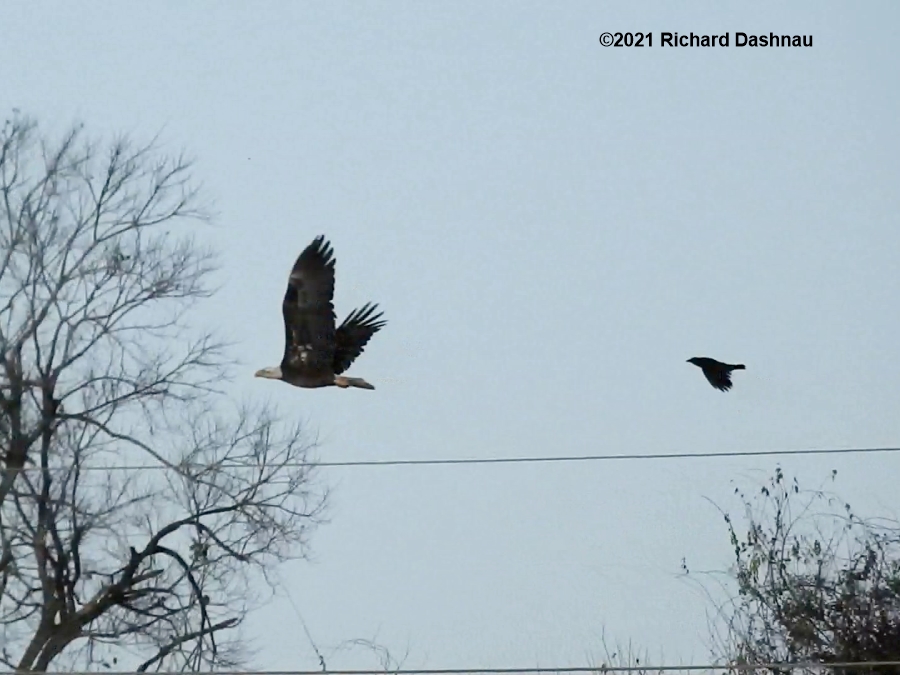
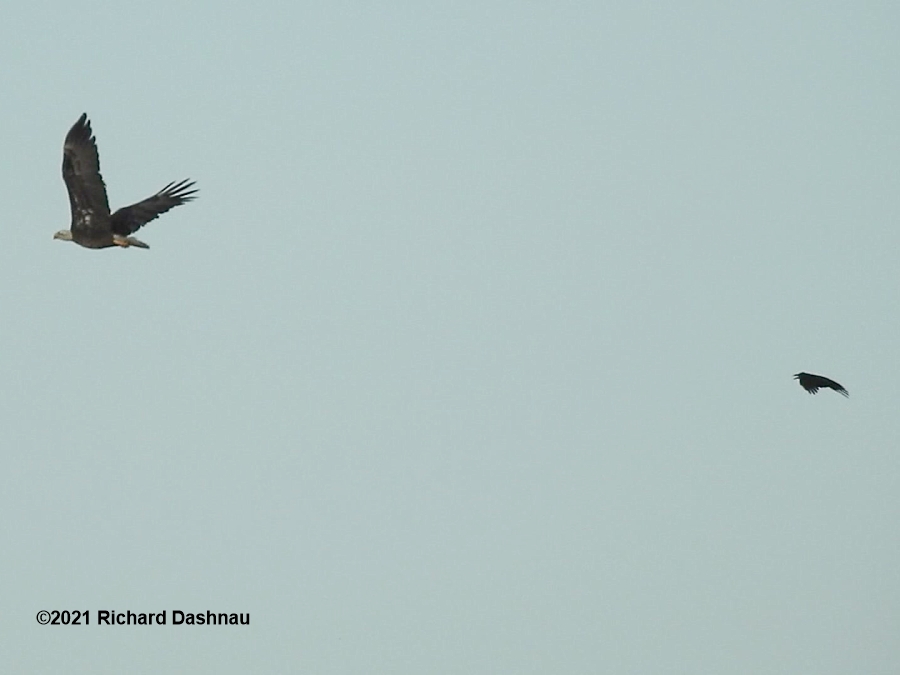
One bird following, but not gaining.
The Eagle flew off to the West, alone.
On 12/21/2021;
I was at Fiorenza park North. I could see two Bald Eagles on
the power line tower to the south. Then more
stuff happened!
If you don't want to read the story, then it is summarized in the edited video here (4 min,
mp4); which, of course, also shows the clips I filmed.
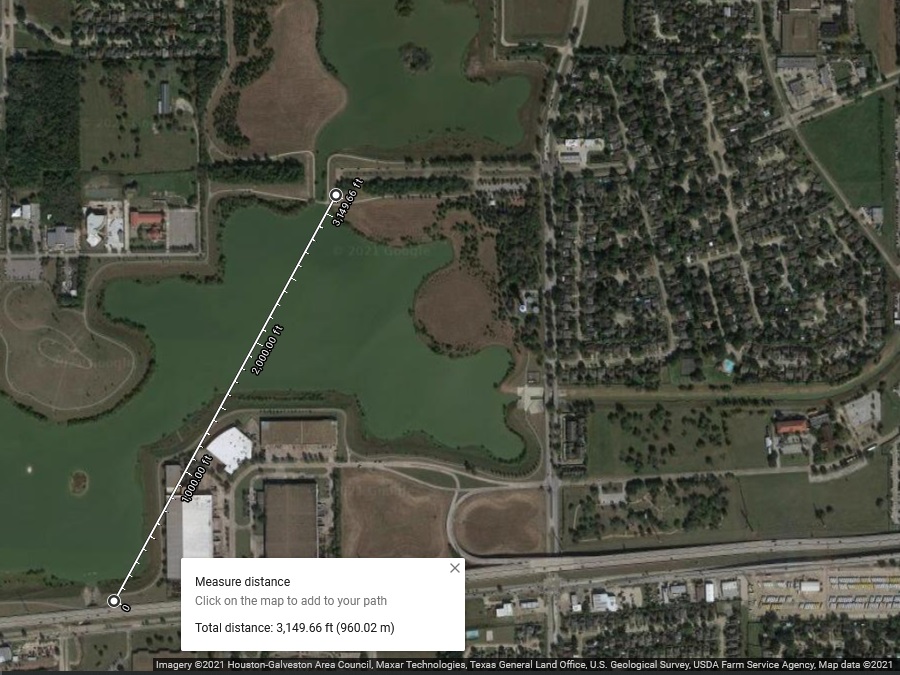
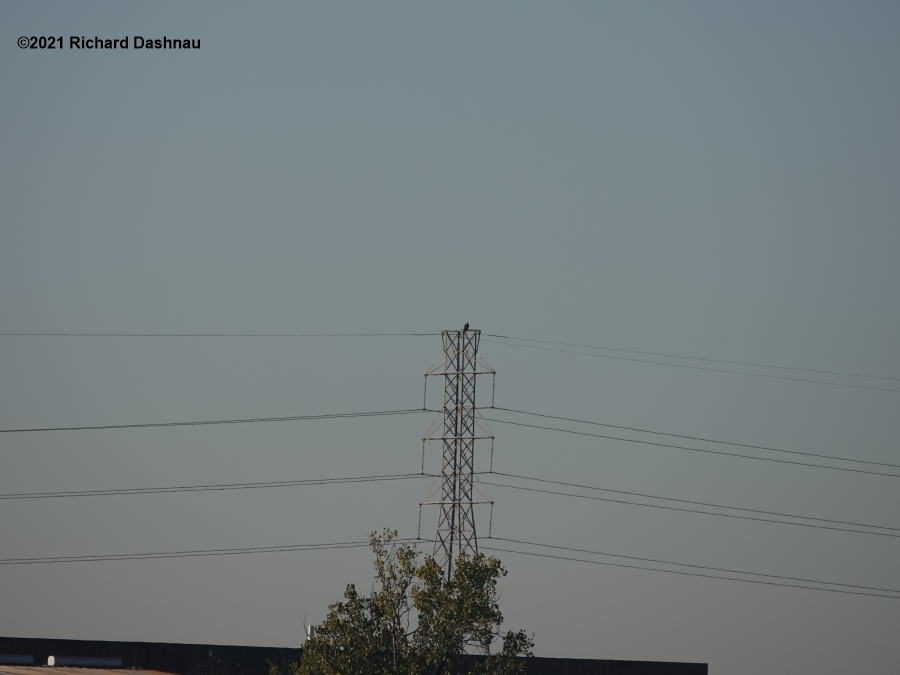
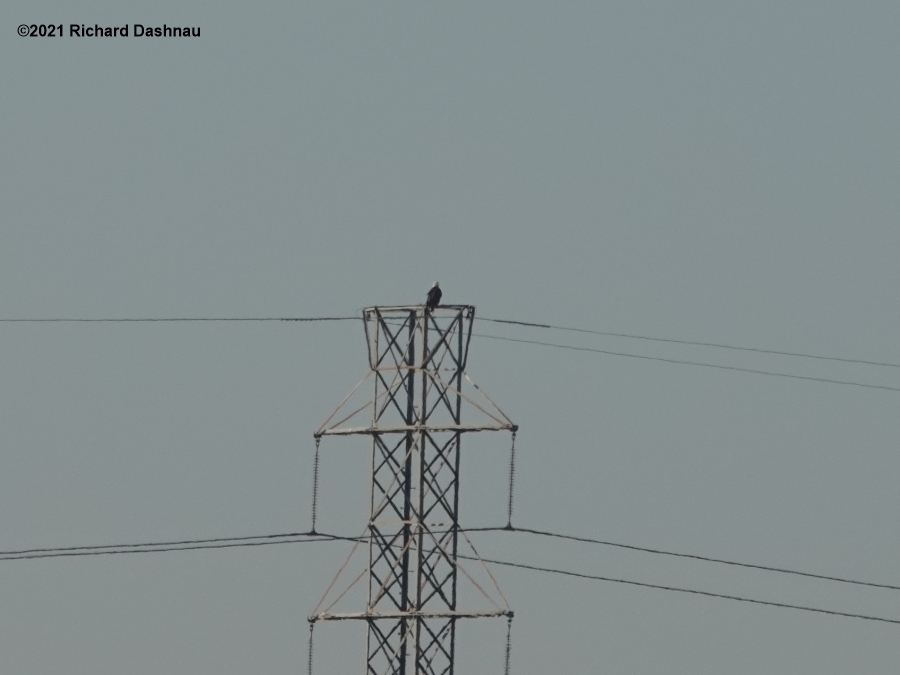
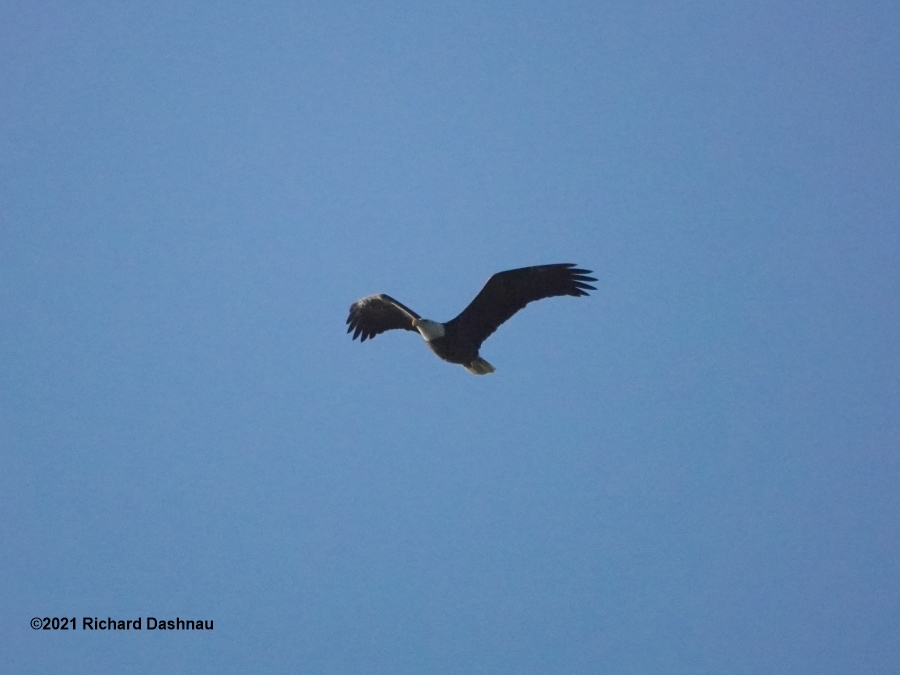
For
some weeks, one or two eagles were visible on top of an electrical
tower about 1050 yards (about 1/2 mile) South of the short, low
footbridge at Fiorenza Park. At 8:45 I'd looked
North, then turned back to
see an Eagle flying over the water, directly towards me. I was
able to catch some pictures before it flew past the sun. (map image
�Google maps)
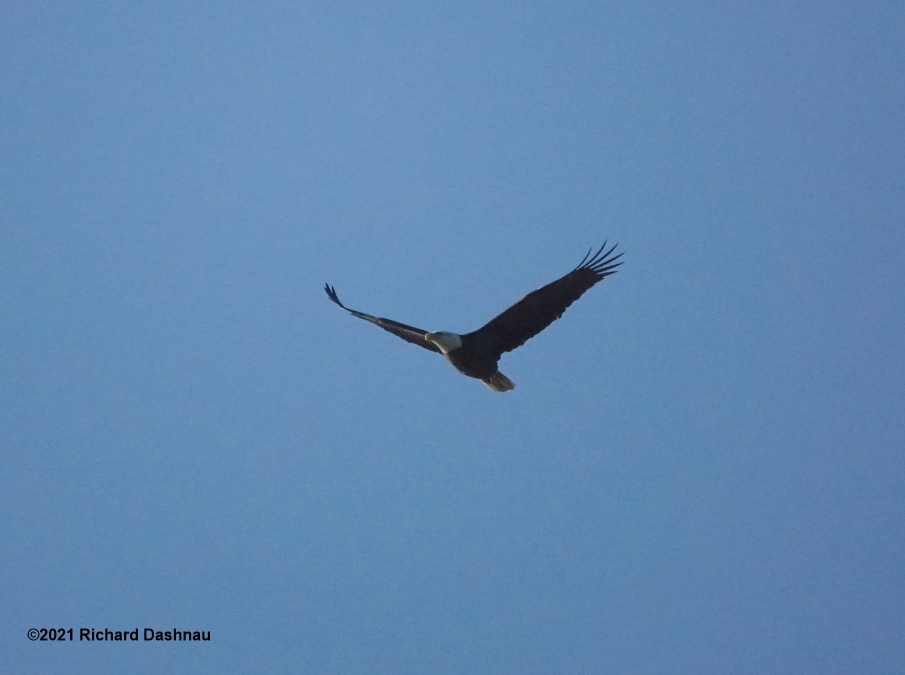
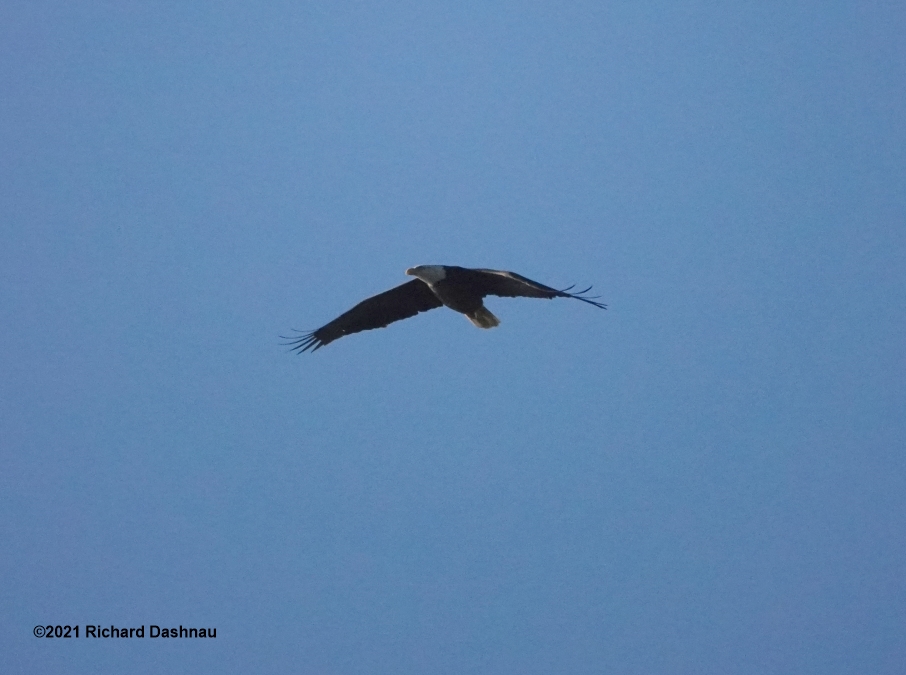
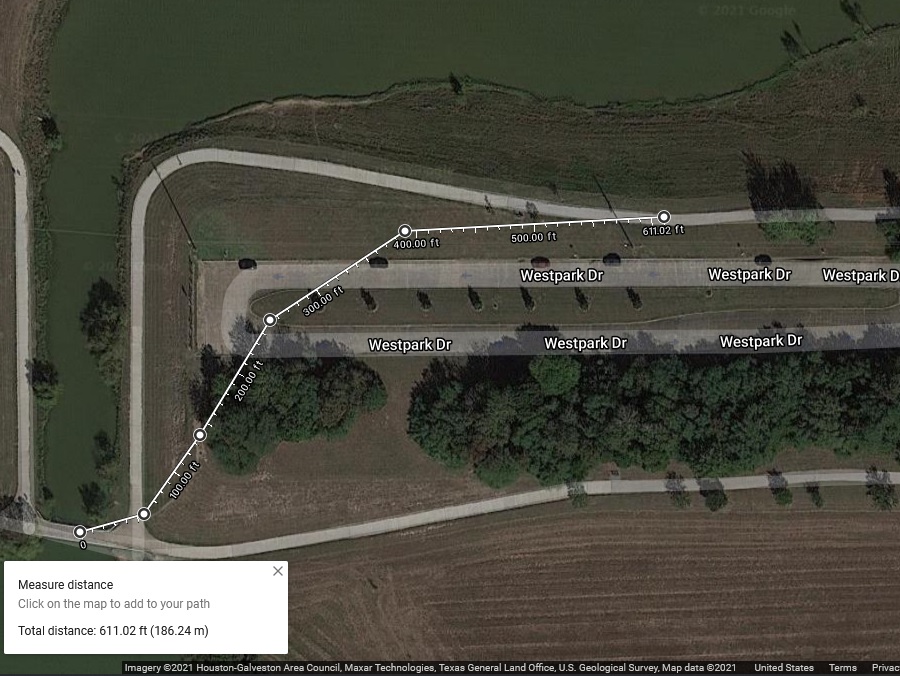
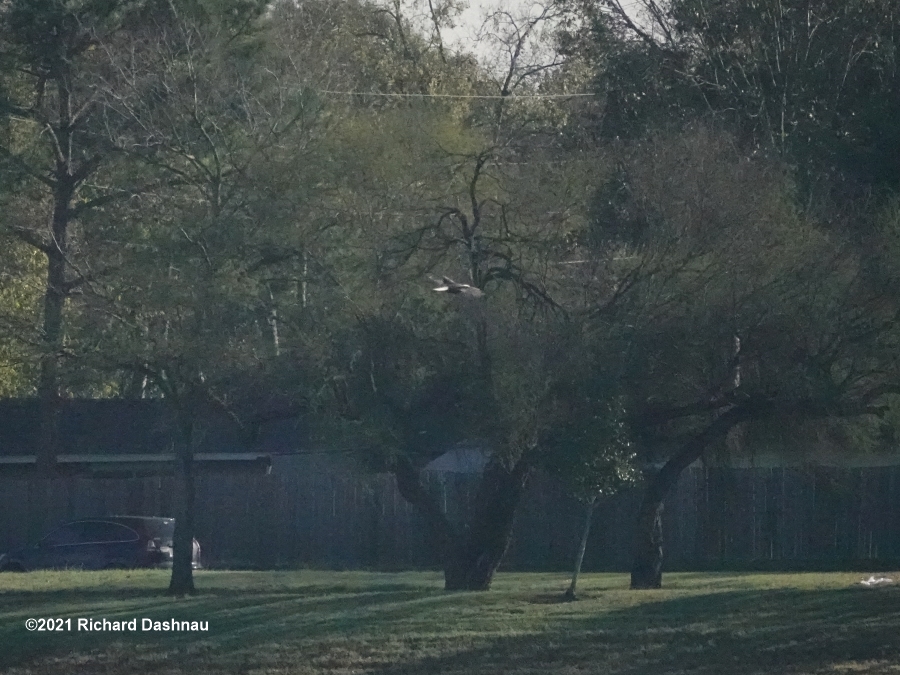
The
Eagle passed over me, and continued North, over that section of the
lake. I hurried up the hill, and across the Westpark loop (about 200
yards) to look for the eagle. This was
not as easy as one
might imagine, since there were many large birds in the air around the
islands (Cormorants, Great Blue Herons, various Ducks, etc.). But, I
found the Eagle!
(map image
�Google maps)
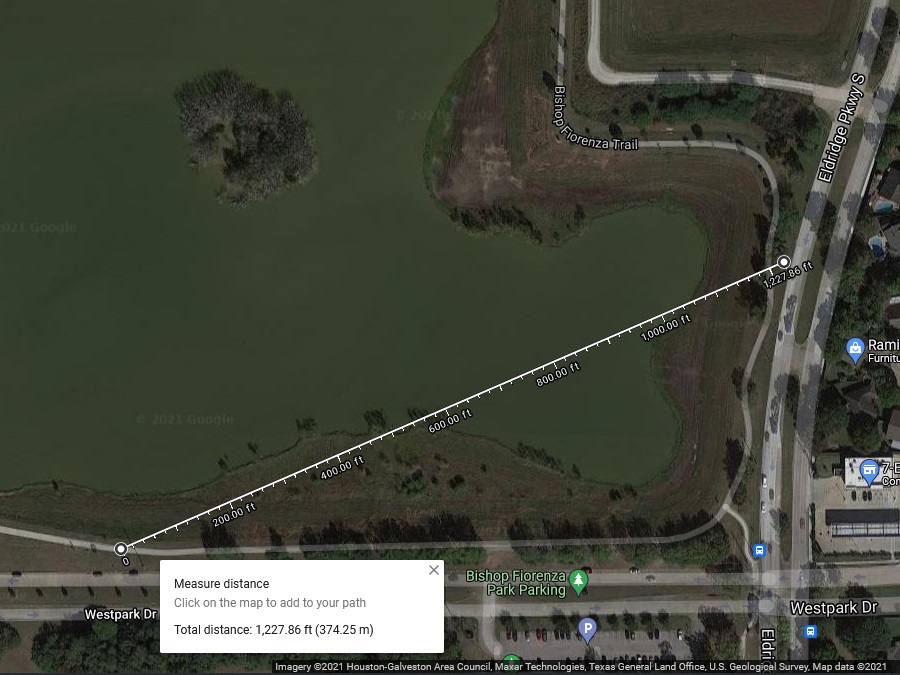
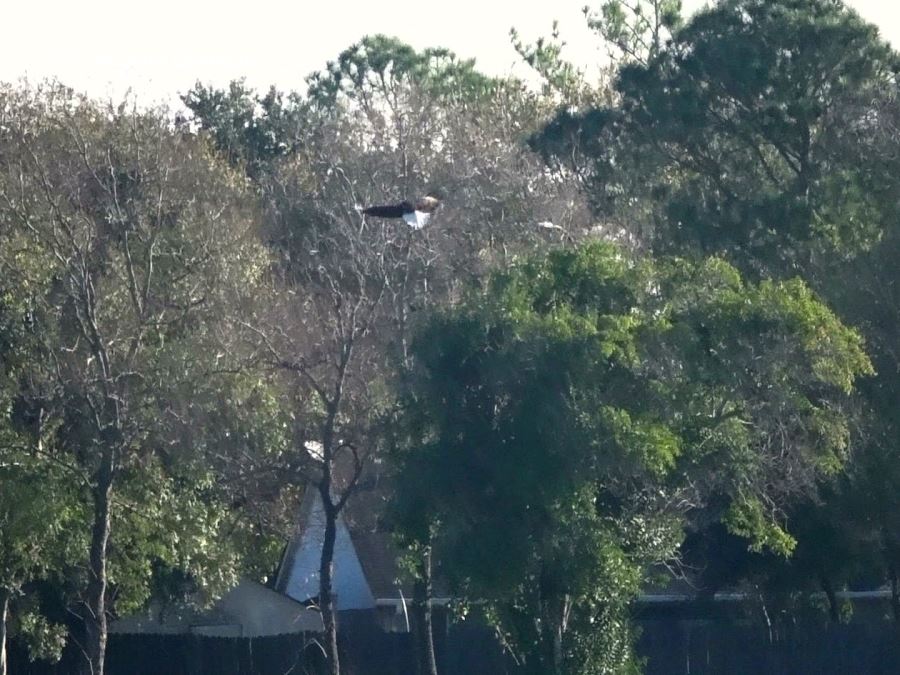
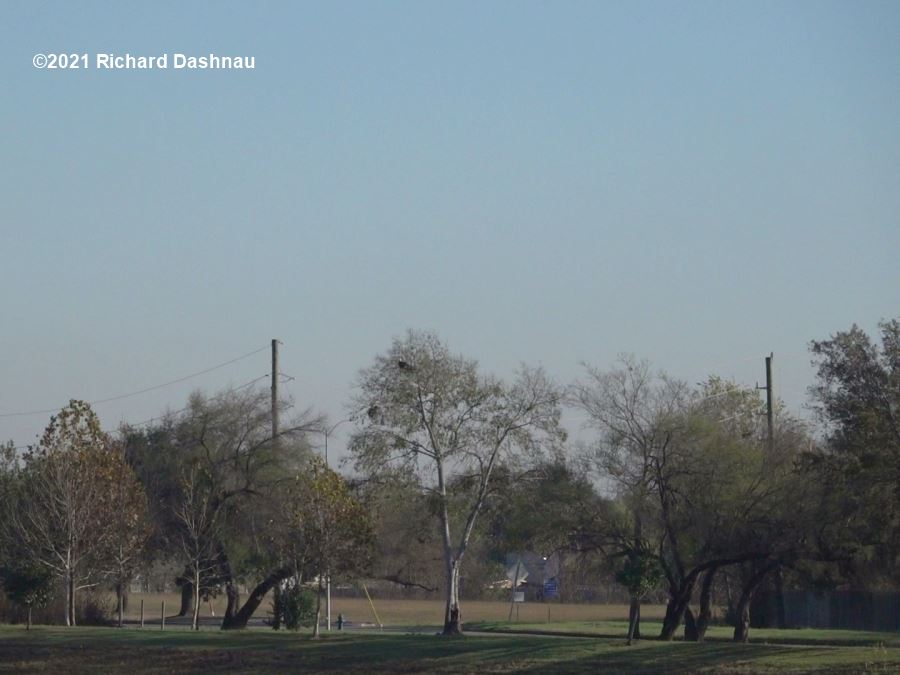
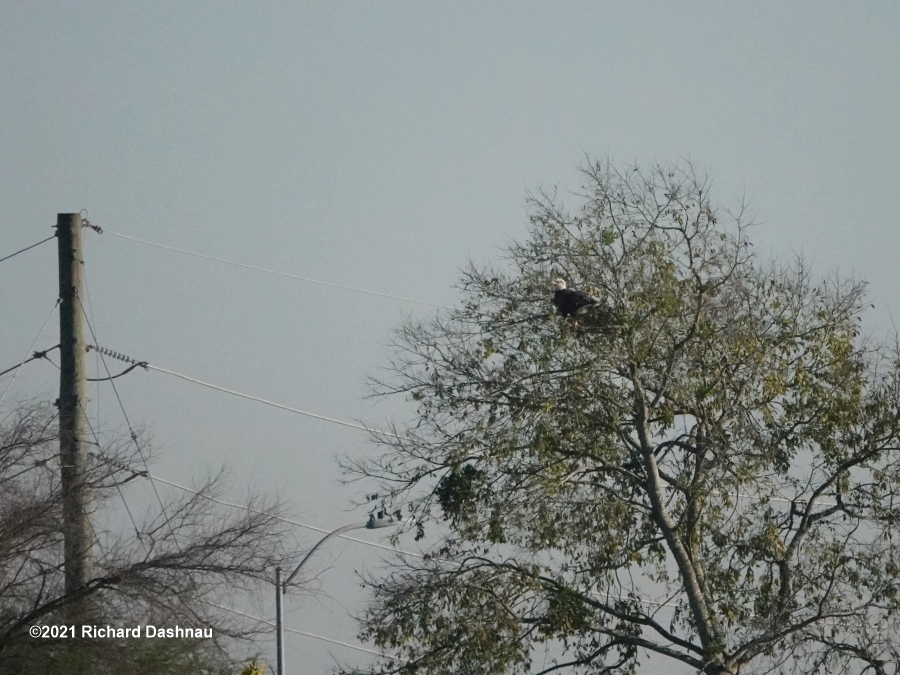
The
Eagle flew East, and landed in a tree next to Eldridge Parkway--about
400 yards away from me. I walked towards it, pausing sometimes to shoot
a picture or video clip. While I
moved, the Eagle changed trees, maybe twice. (map image
�Google maps)
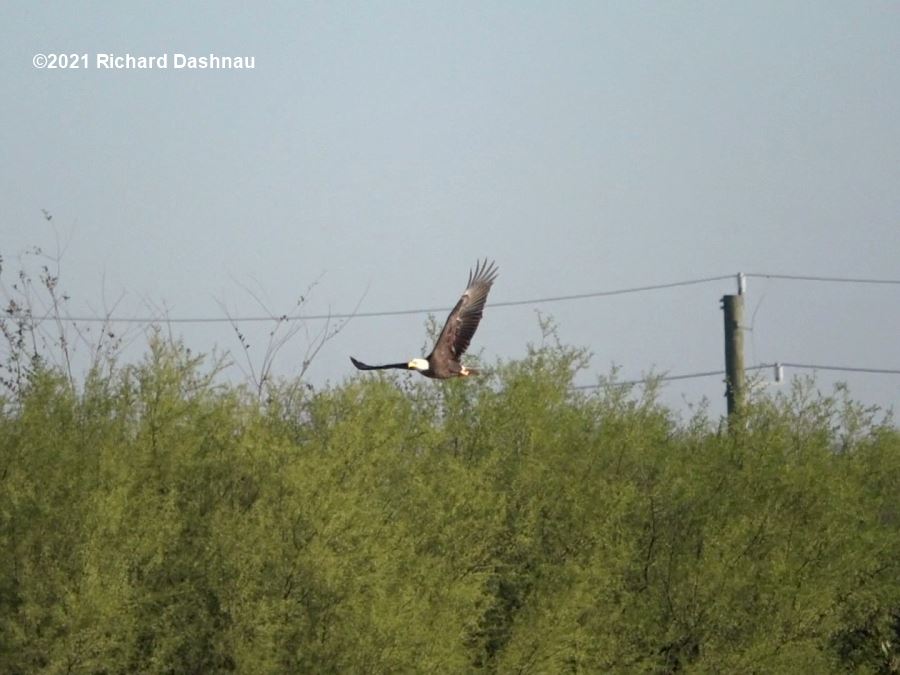
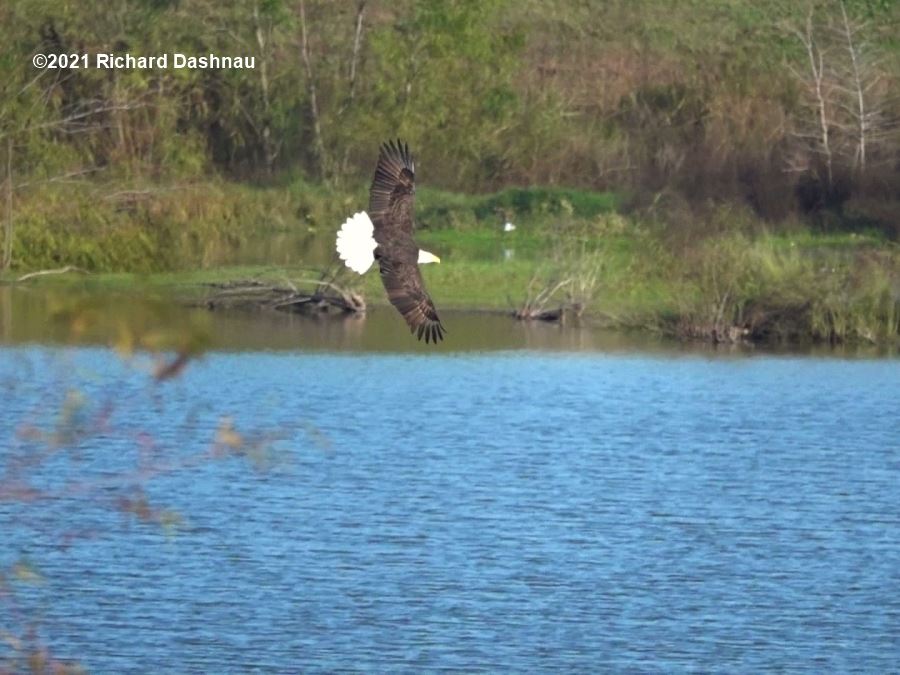
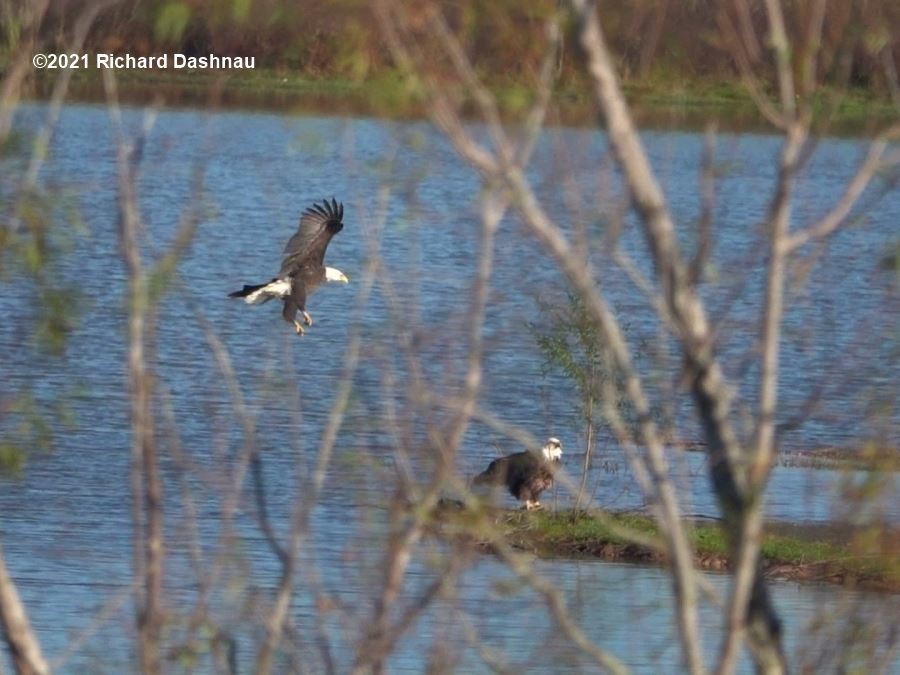
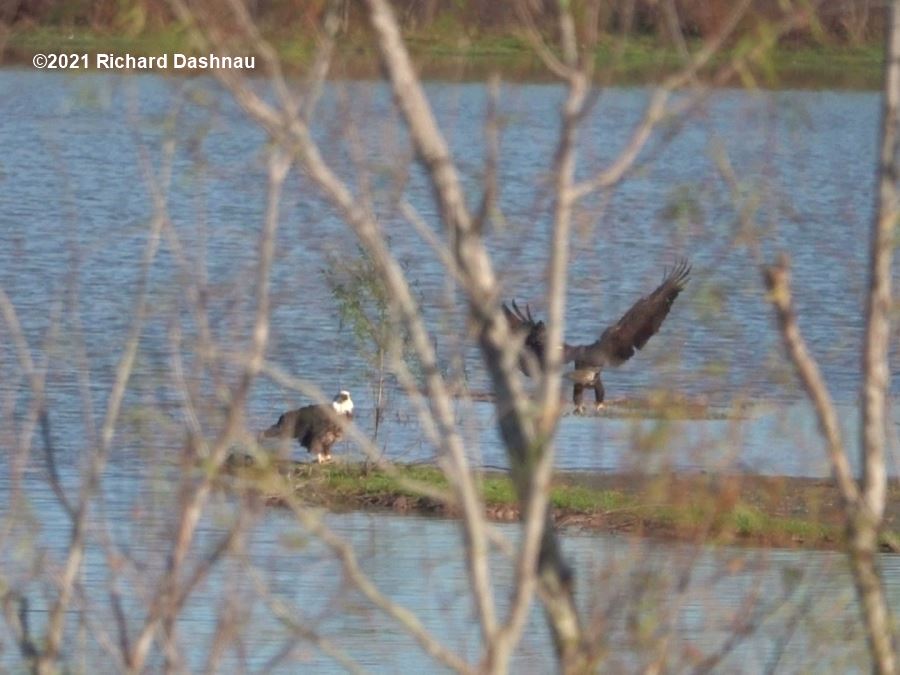
I
stopped walking and filmed the Eagle, still from some yards away. I
joyfully watched it fly past me (though still some distance away).
It banked away from me, then turned back
and began to land. I was watching through the limited angle
of my camera view--so was surprised when the Eagle landed....NEXT
TO ANOTHER EAGLE. All my attention had
been focused on the eagle I'd been following, so I had no idea that the
other one had been there.
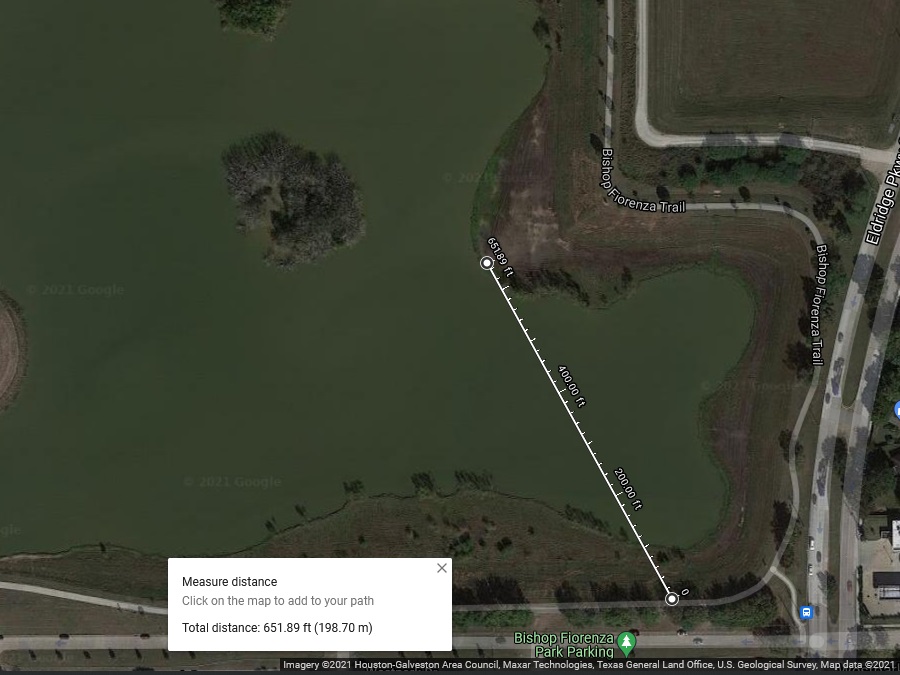
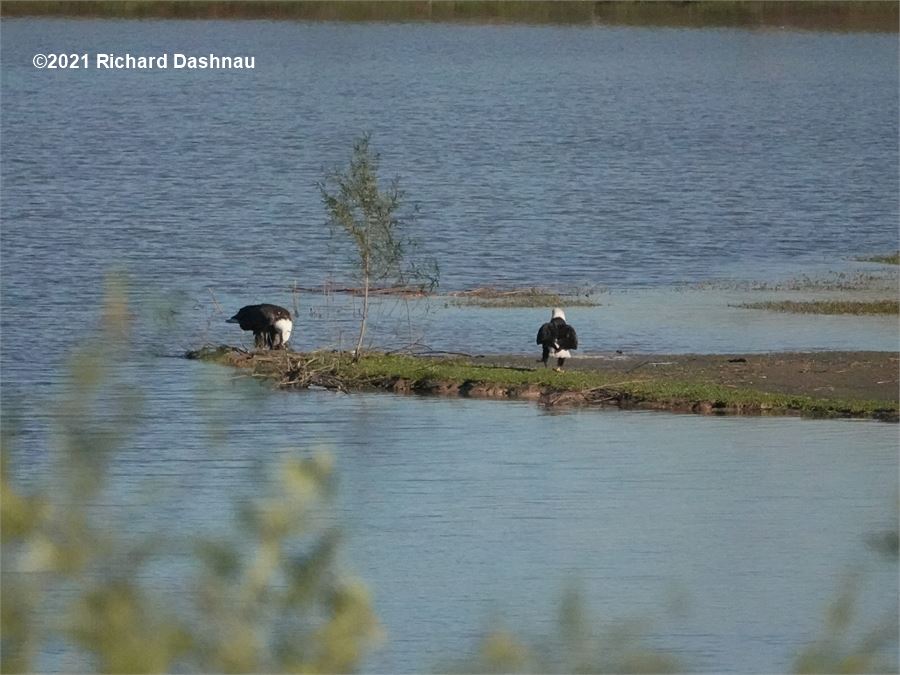
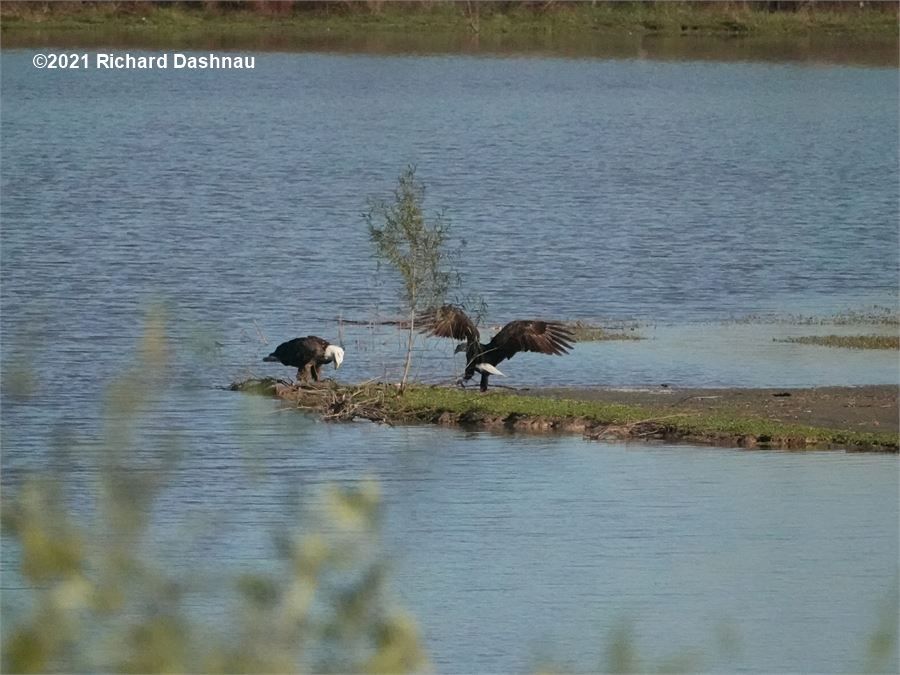
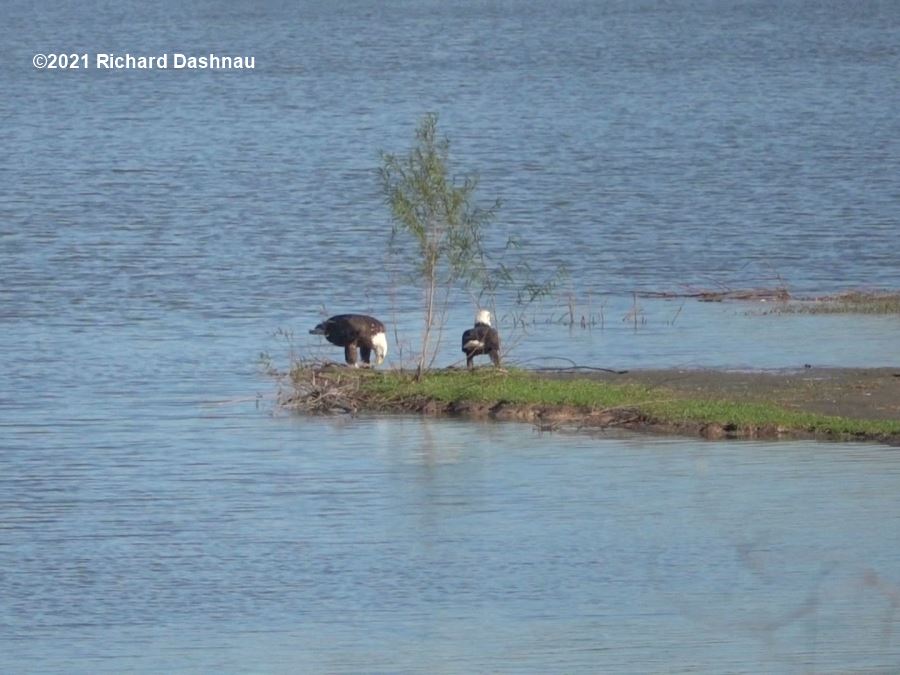
I
moved a bit further to clear the trees, and paused to film the Eagles.
Images taken from far away are better than none at all--and I had no
way of knowing when or if the Eagles would
fly off. I was about 200 yards away from the Eagles at that
time (map image
�Google maps) Then I continued trying to get closer to
them. The trail loops above and away from that
position.
Although maybe tempted to walk straight towards the Eagles, I decided
that staying on the trail (and therefore taking the longer path) was a
better idea. I figured that people
had been using the trail all
morning--and the Eagles were still there. So, the trail and humans on
it was a benign background to them.
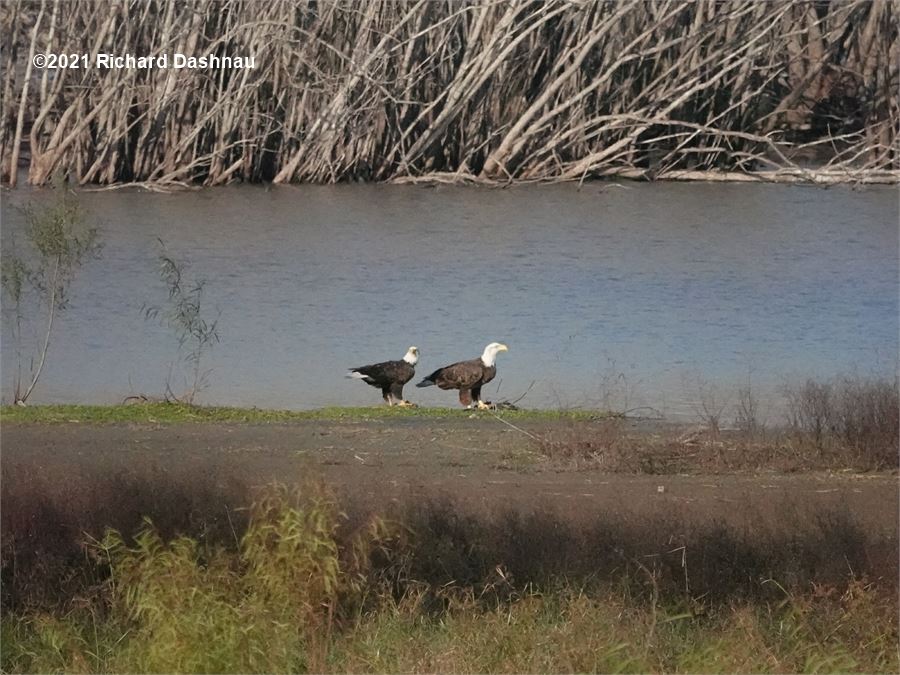
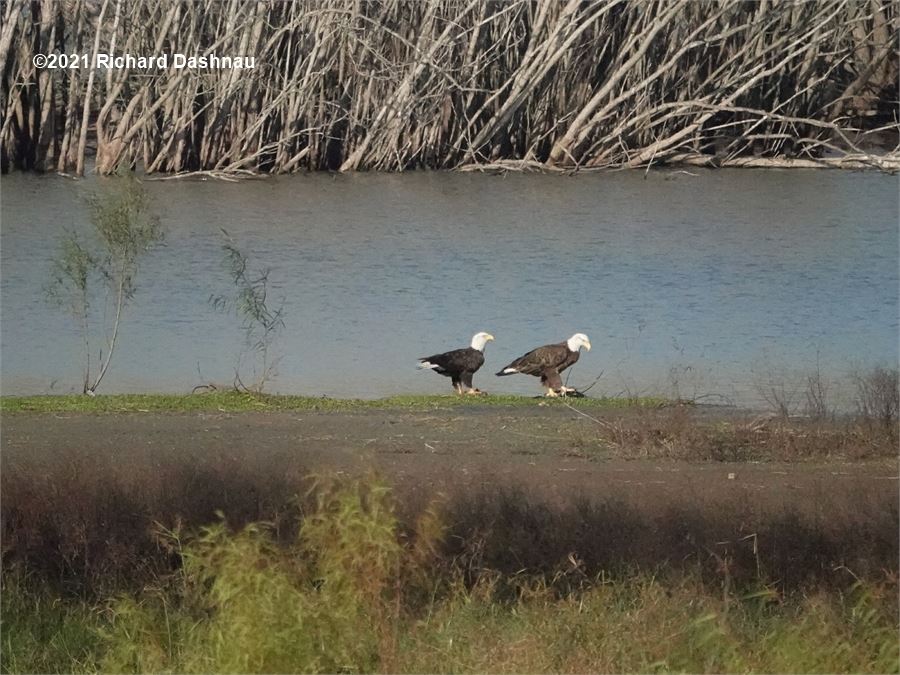
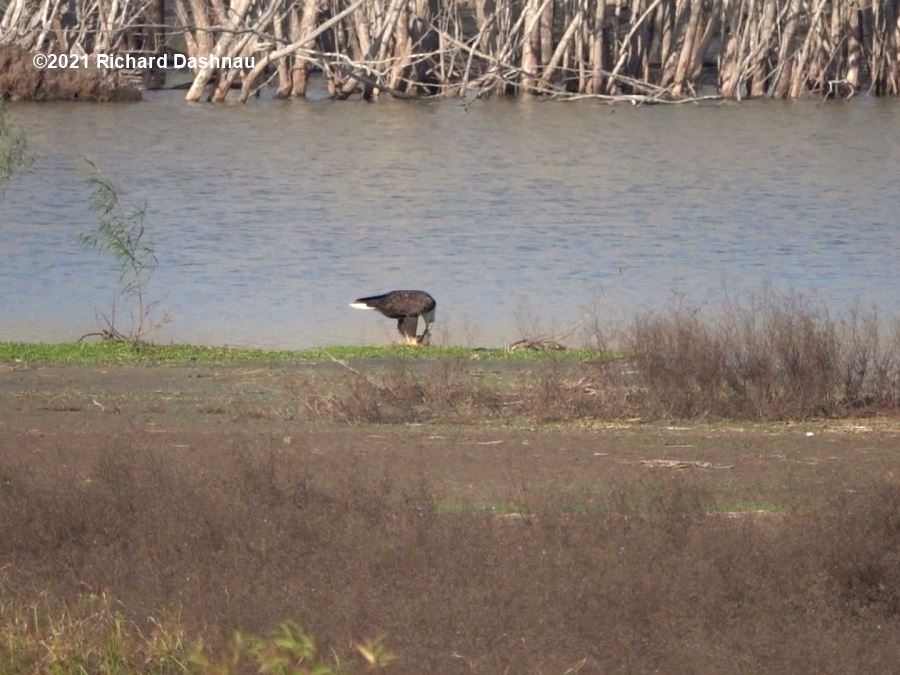
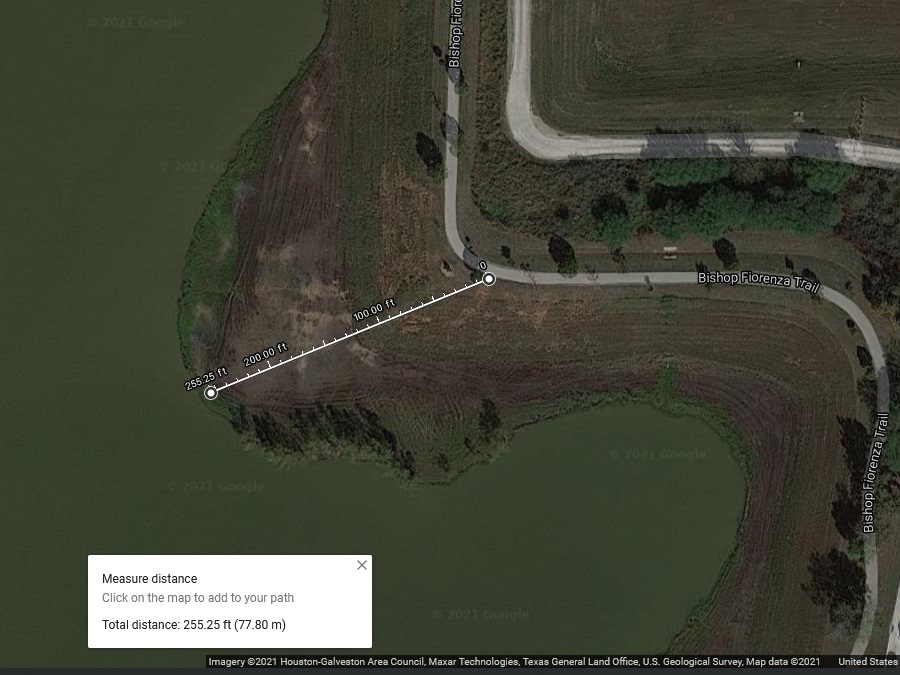
Finally,
I got to the last bend of the trail what would put me allow me to get
closer. As I rounded the bend, two people had stopped at the
bend
by the Eagles and had seen the birds.
They had cellphones out, and I
hoped thatt they would try to go down further. But, they didn't, and
the people moved off as I got closer. I stopped about 10 yards back
from the hanging
bench and took a few pictures. One of the Eagles
flew off, but one remained with the carcass it had been eating.
I
was about 85 yards from the Eagles. (map image
�Google maps)
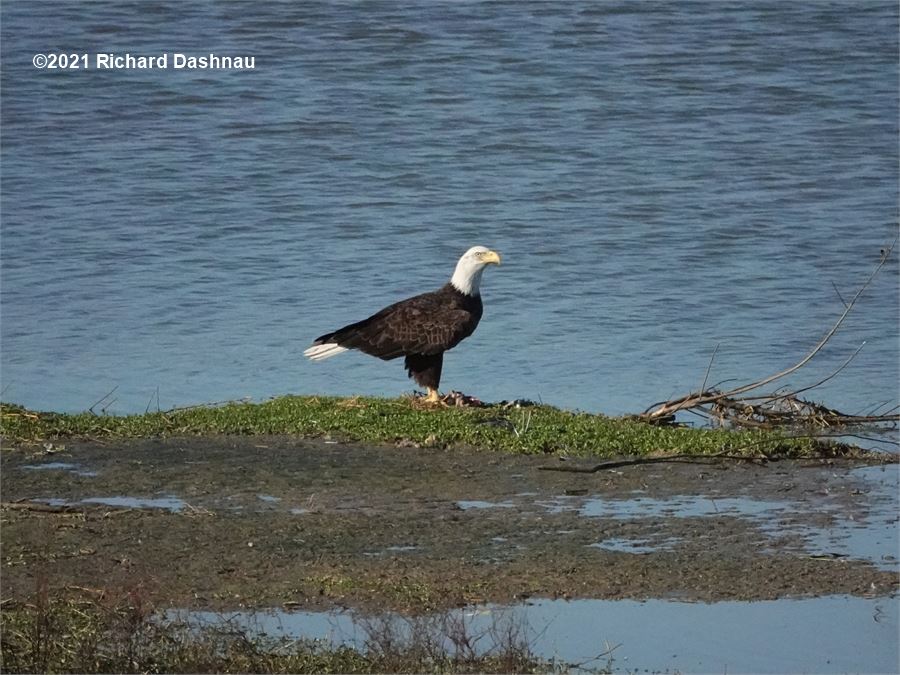
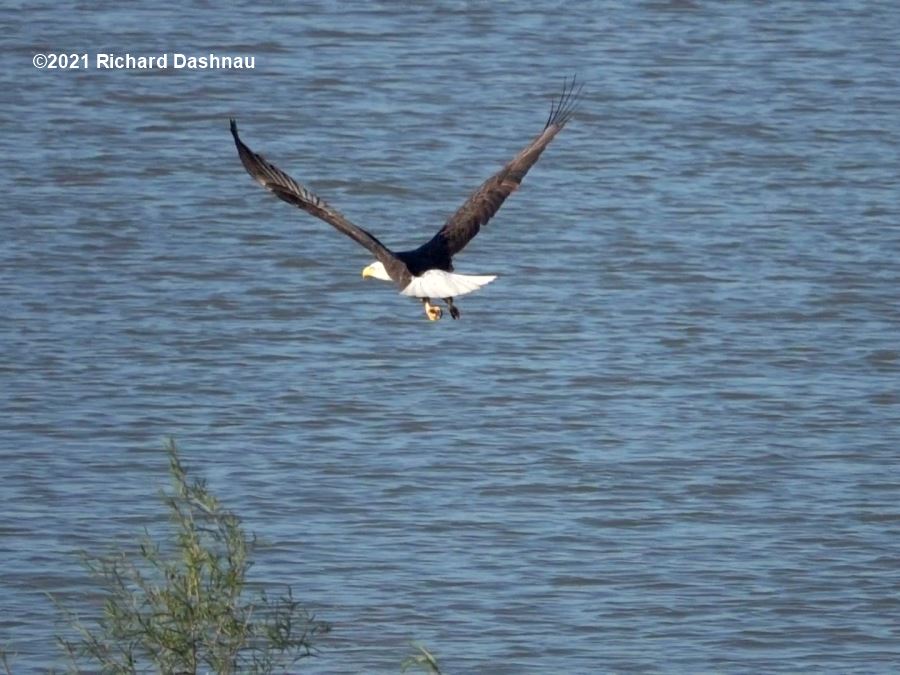
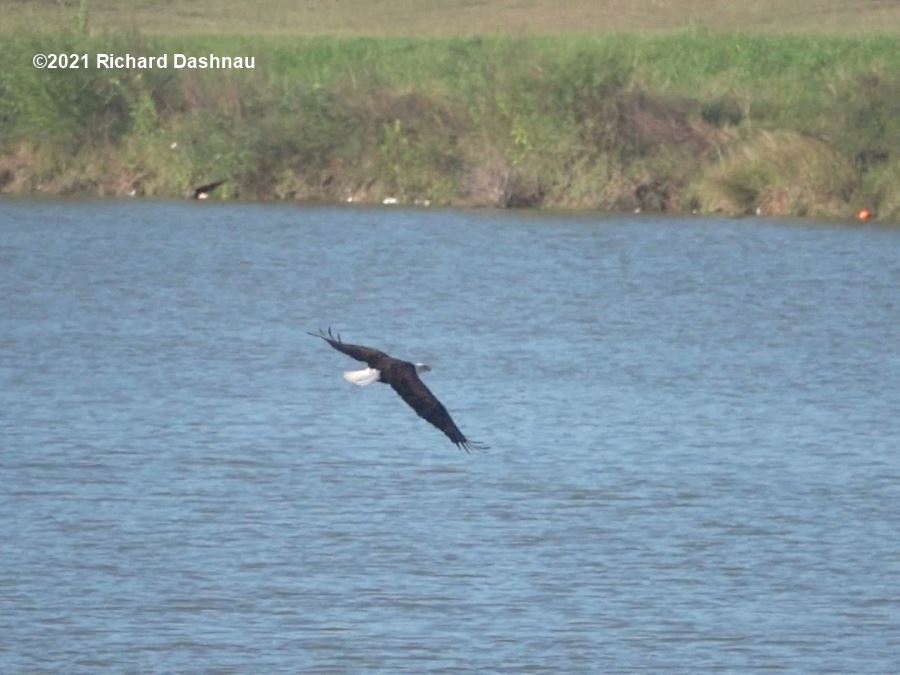
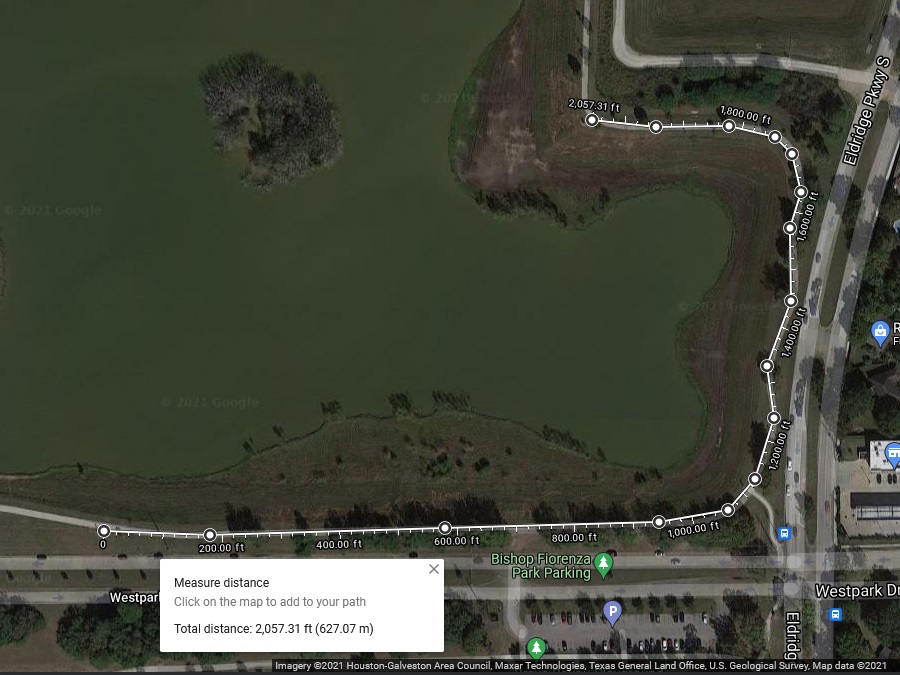
It
picked at the carcass a bit more (I never did find out what it had
been), and then flew off. I watched it curve and go behind the trees on
one of the islands. I backtracked to the spot
where I'd first seen the Eagle land in the trees (about 685 yards
around the trail from the hanging bench). (map image
�Google maps)
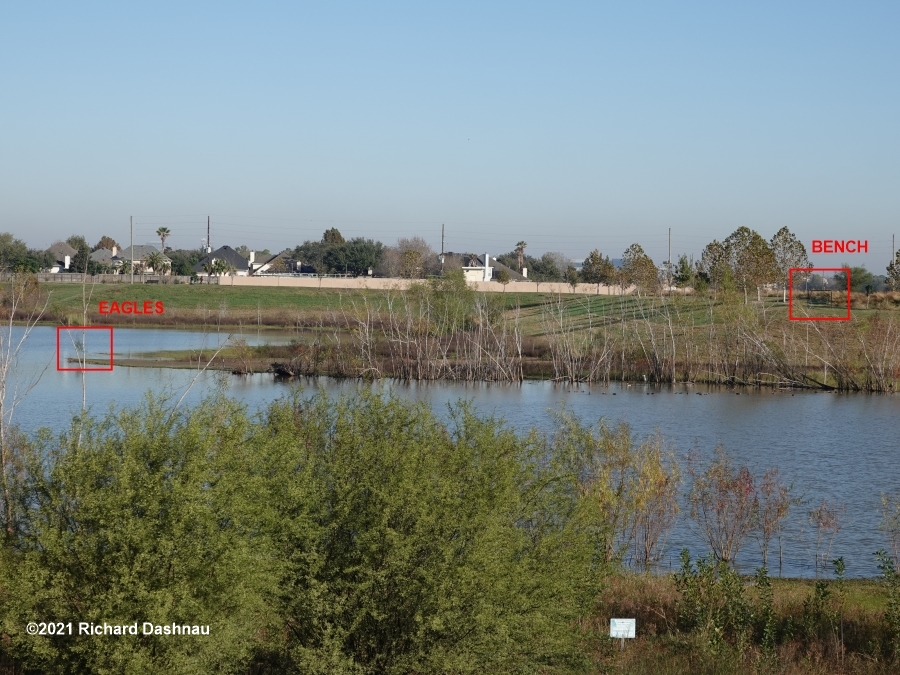
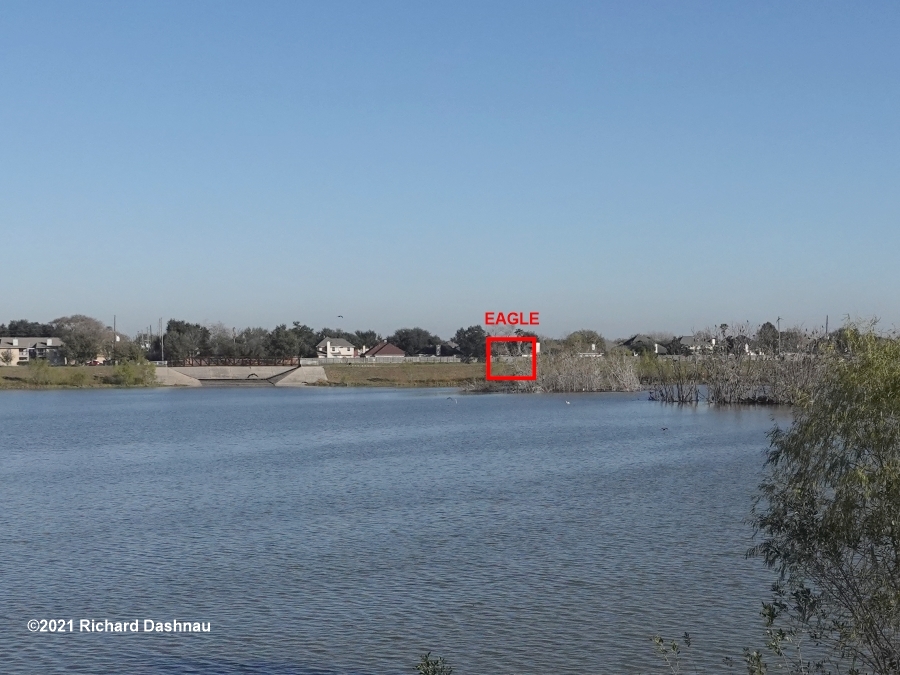
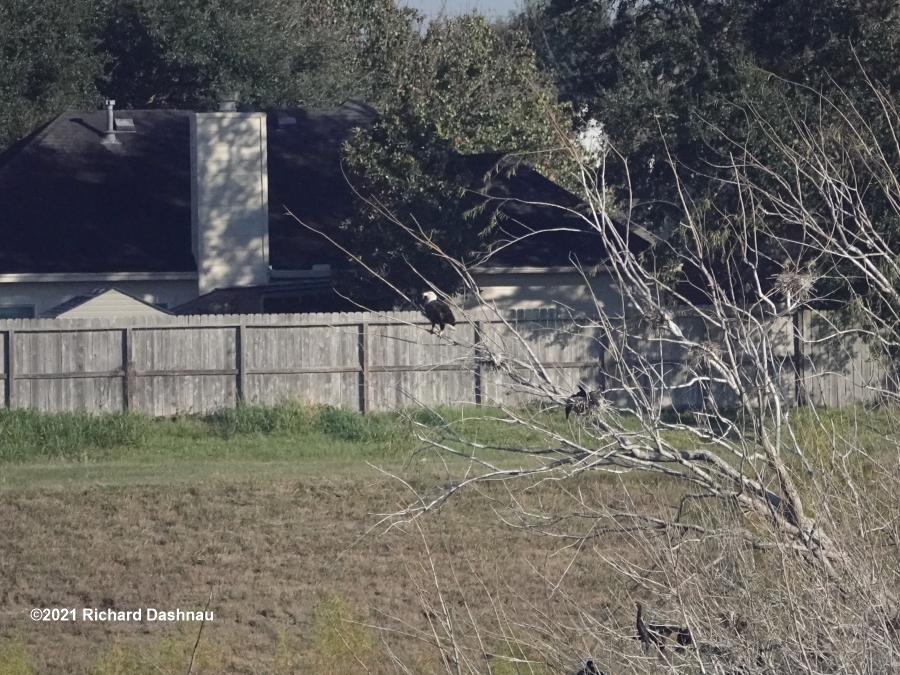
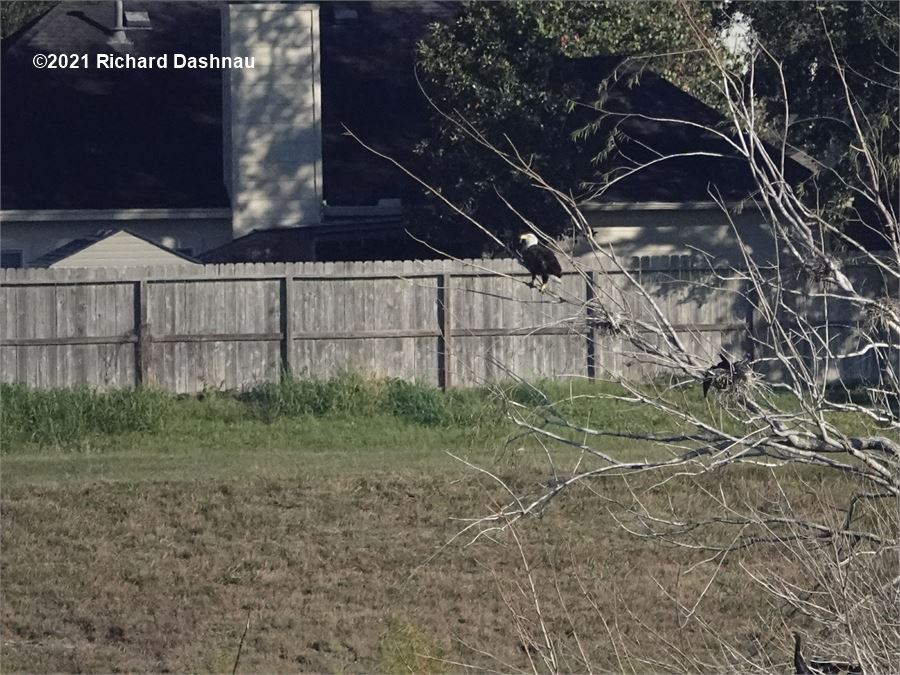
The
first photo shows how far the bench was from where the Eagles were
eating. When I got back to my original spot, I saw that one
of
the Eagles had landed on the farther island!
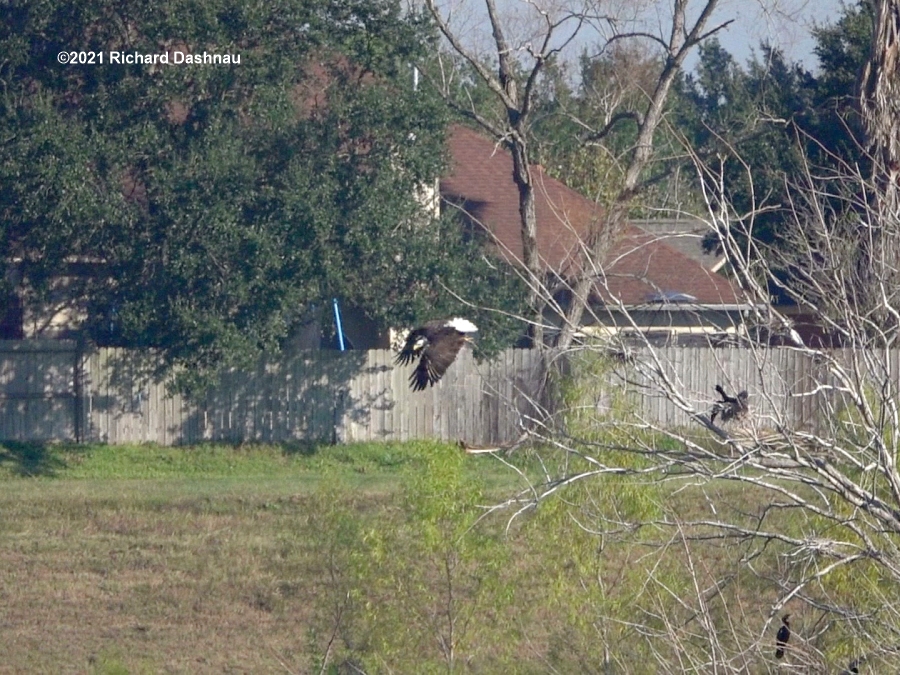
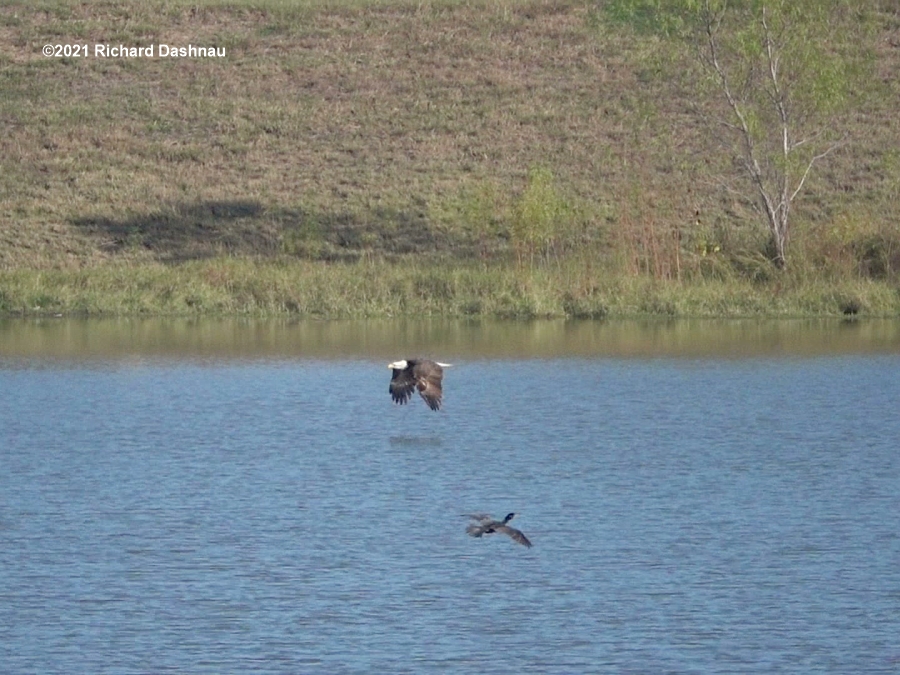
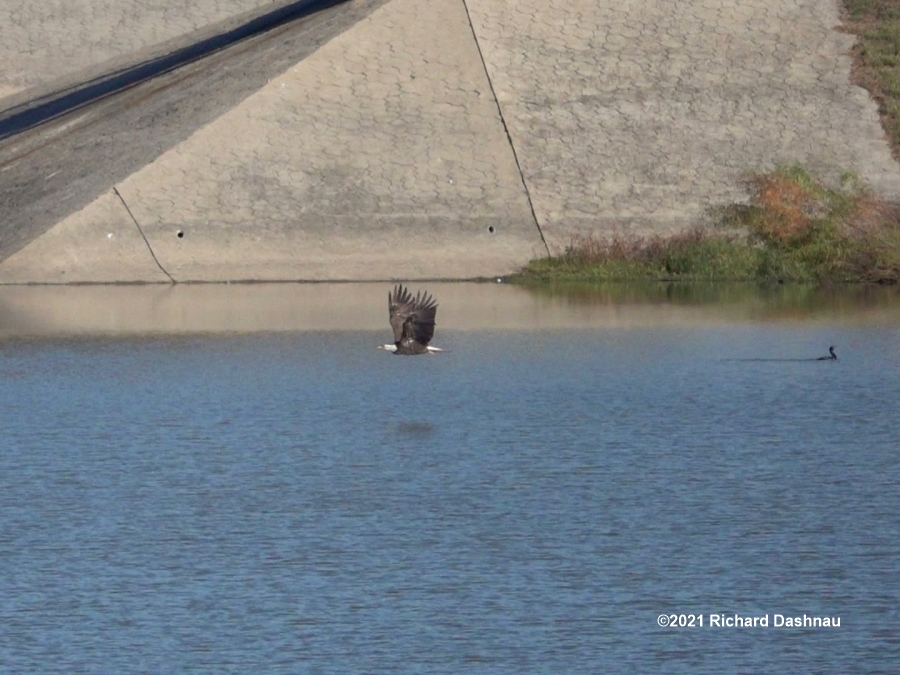
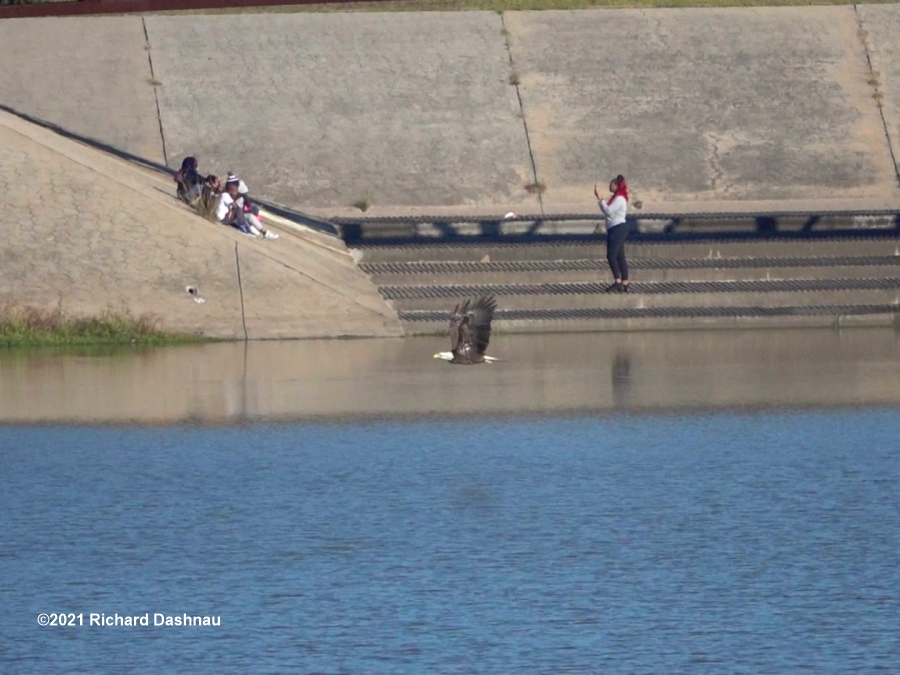
I
was lucky again, and filmed the Eagle as it took off and flew West over
the water, and across my view. It passed the Spillway.
It
passed folks taking a group picture on the
spillway.
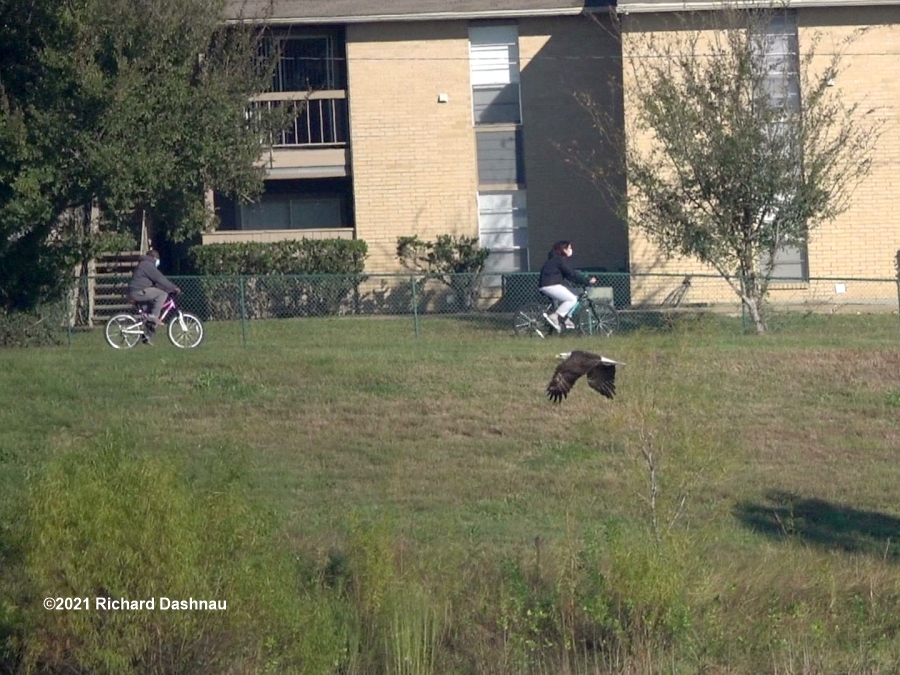
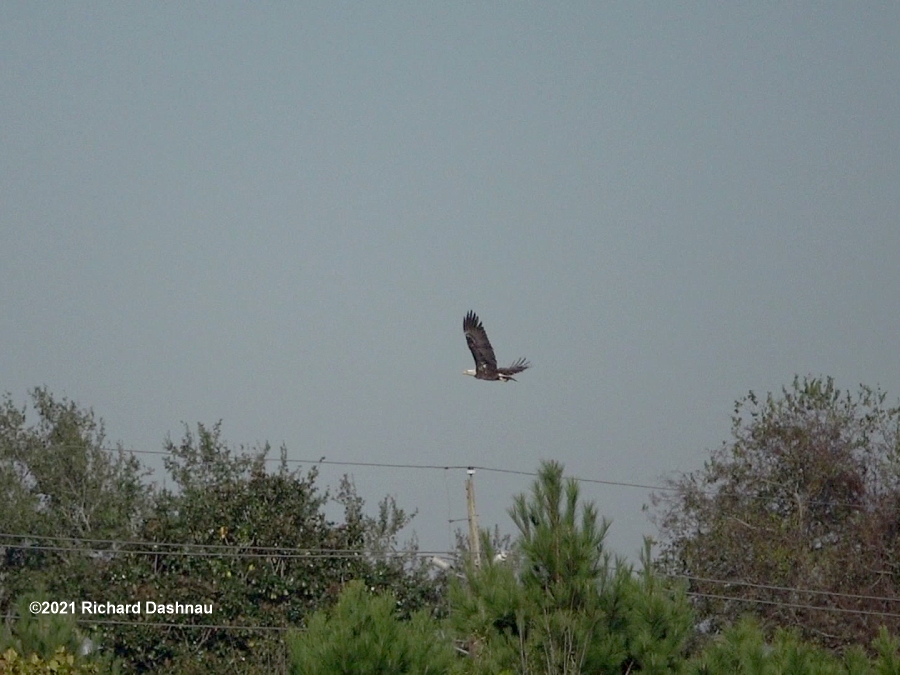
The
Eagle passed people riding bikes on the trail. I smiled, as I
wondered if any of those people had noticed the magnificent predator
flying past them. The Eagle went off to the West.
And that was about 45 minutes of my morning at Fiorenza Park. Again, this
is summarized in the edited video here (4 min,
mp4; which, of course, also shows the clips I filmed.
Update 12/13/2021- 11/29/2021,
I went to Fiorenza Park North (which I often do). While I was there, a
friend pointed out two Bald Eagles on top of a power line tower off to
the South.
My
camera could capture their image, even at the
highest zoom. I was happy to see Eagles, but a bit
disappointed by them being so far away. But then there was commotion
behind me
(North).
I turned around, and saw an immature Bald Eagle.
It was flying above all the birds that were gathered between the island
and the spillway. It circled around, swooped towards
the
birds (which the cormorants didn't like), and eventually flew off to
the East. I shot video, which appears in this clip that collects all of them with the
previous one.
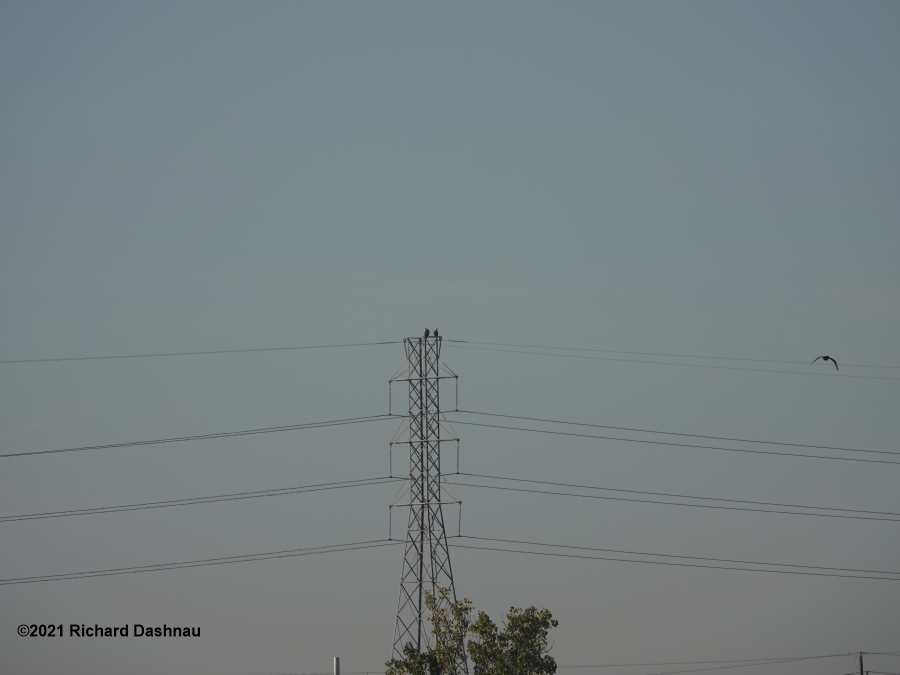
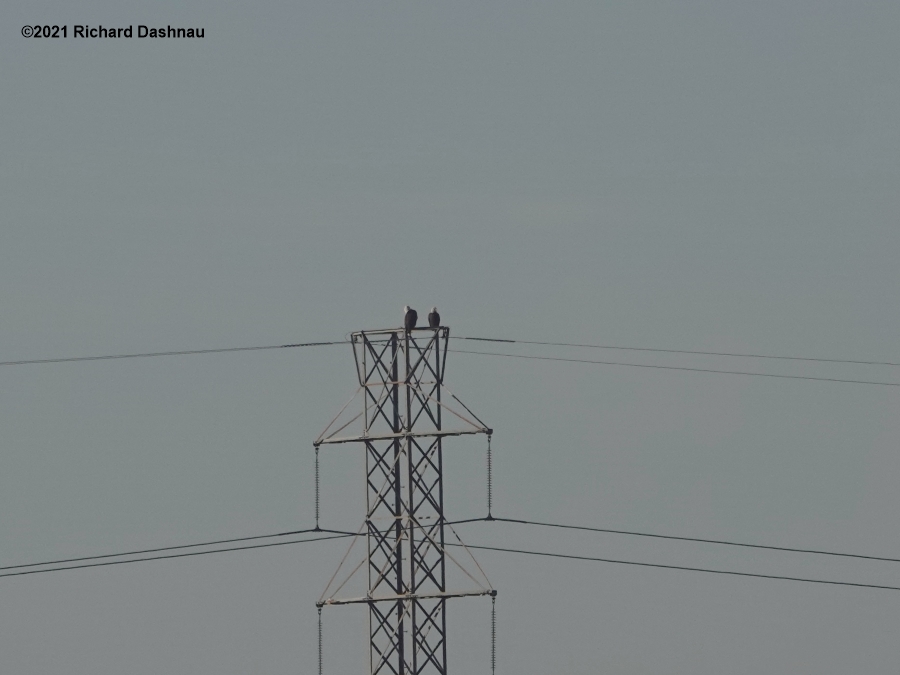
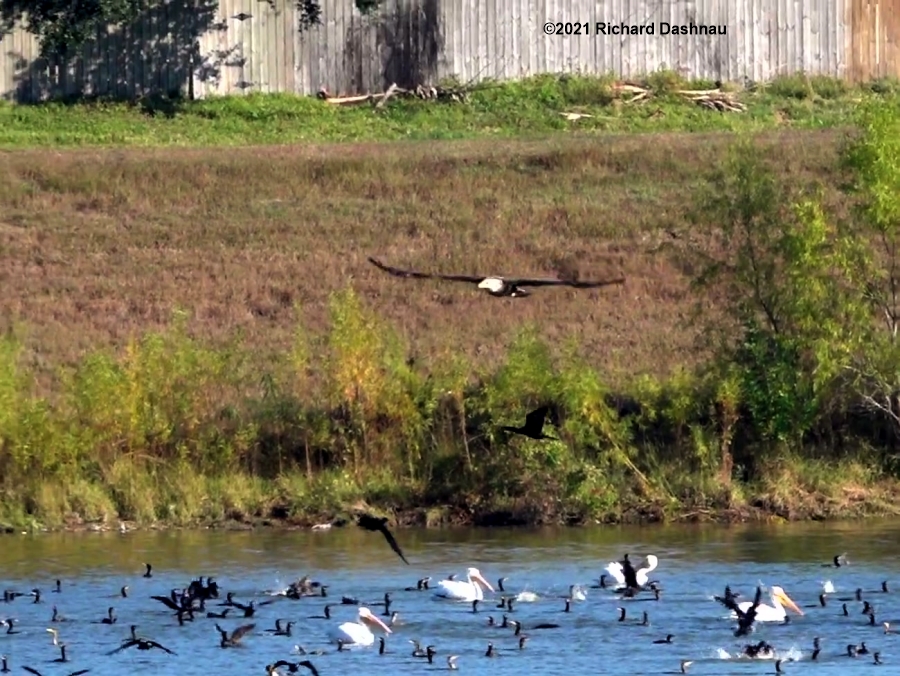
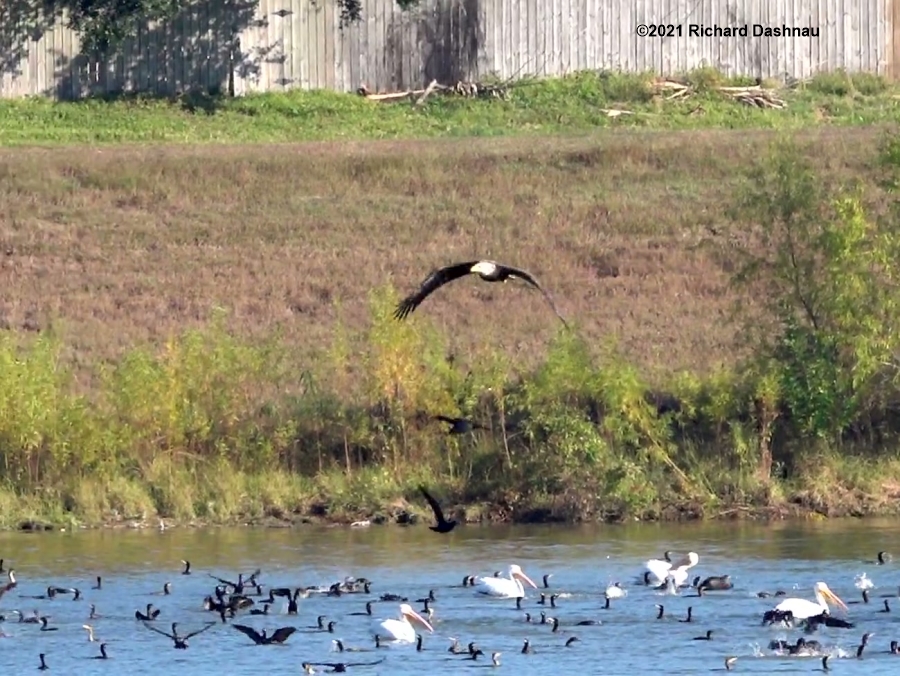
On
12/01/21, 2 days later , I went back to Fiorenza Park North again, and
this time I brought a camera with greater range. The two Eagles were on
top of the power line pylon again. The six images below show
how
far away they were. Even with better zoom, images of the
eagles were hard to capture.
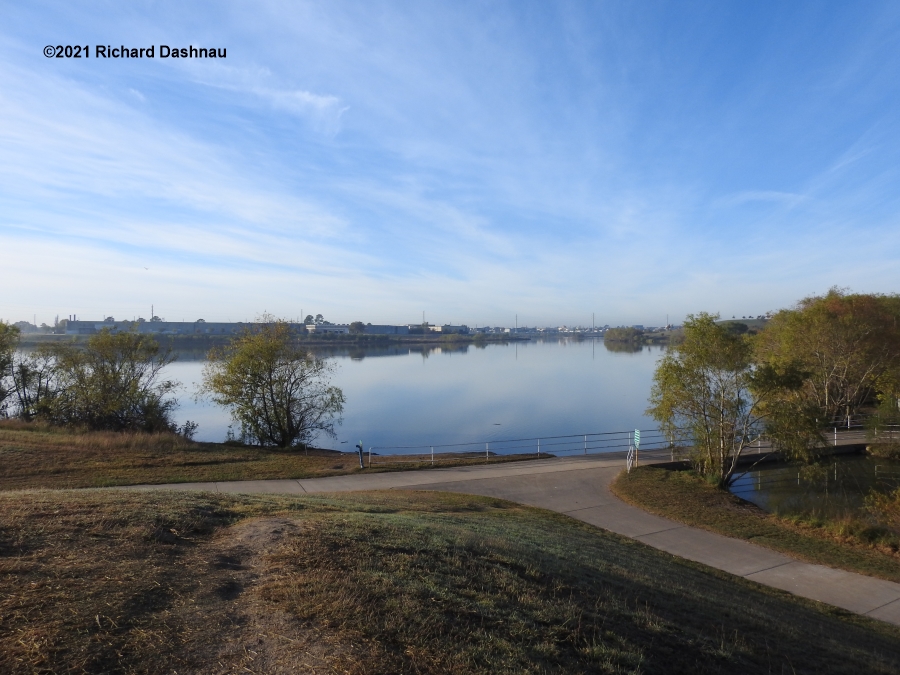
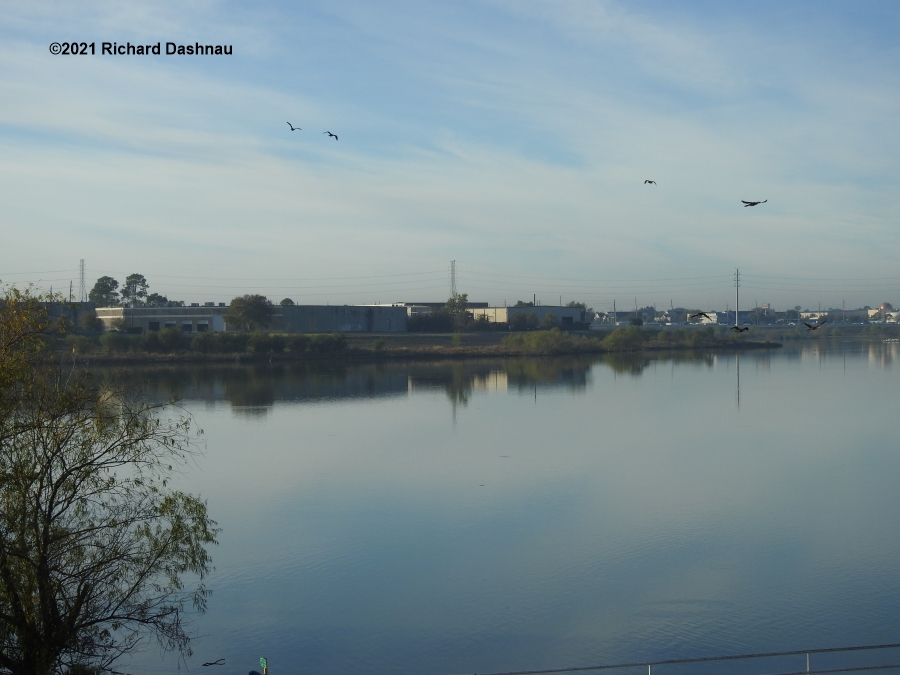
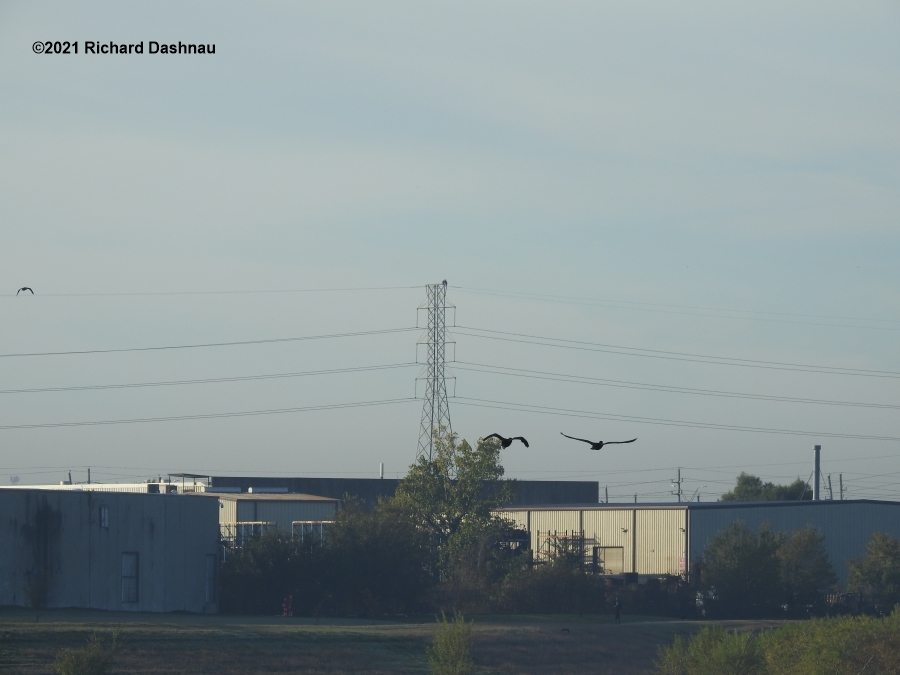
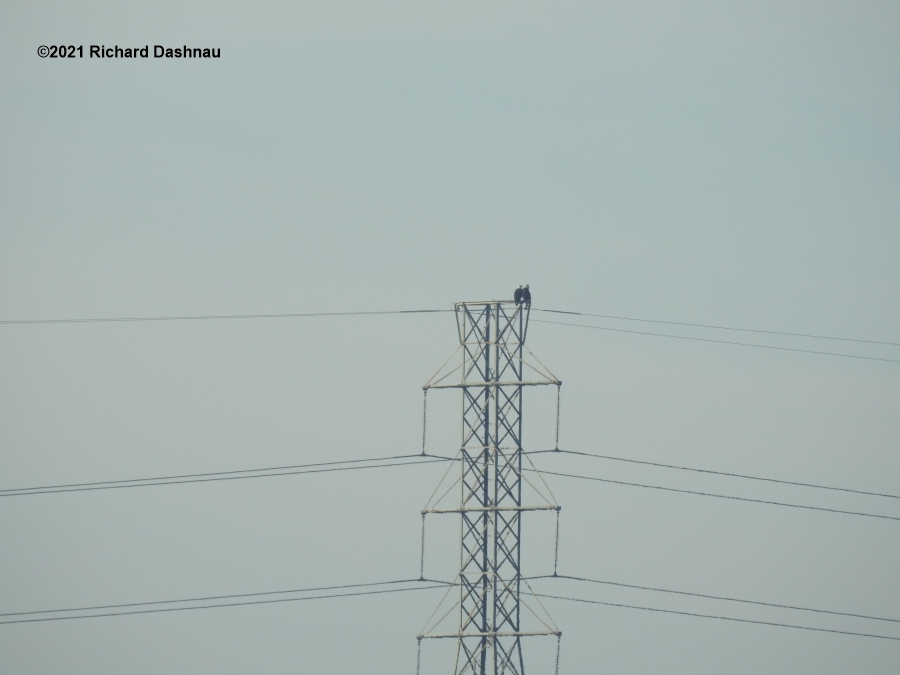
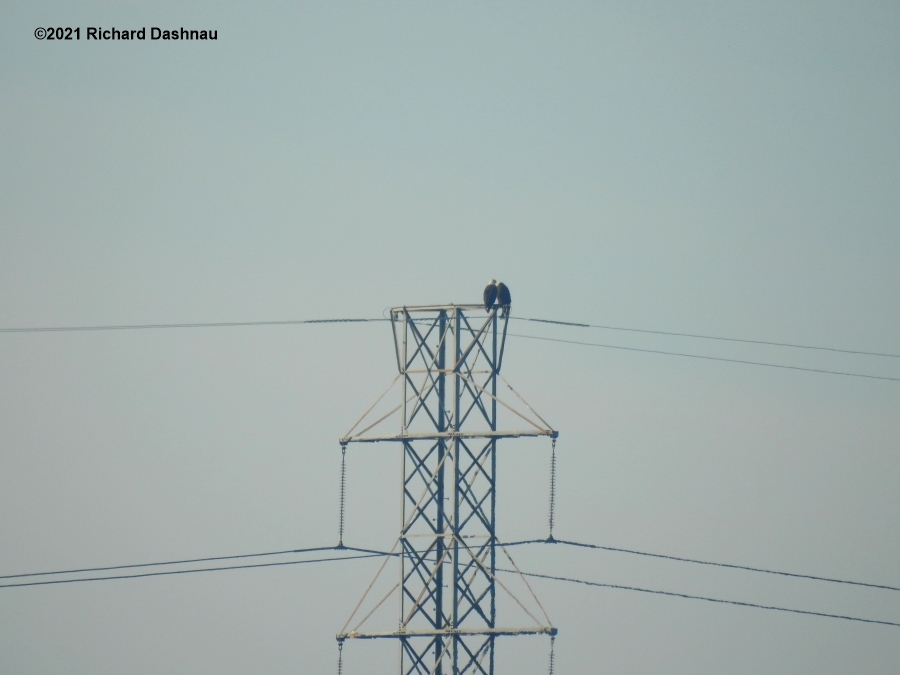
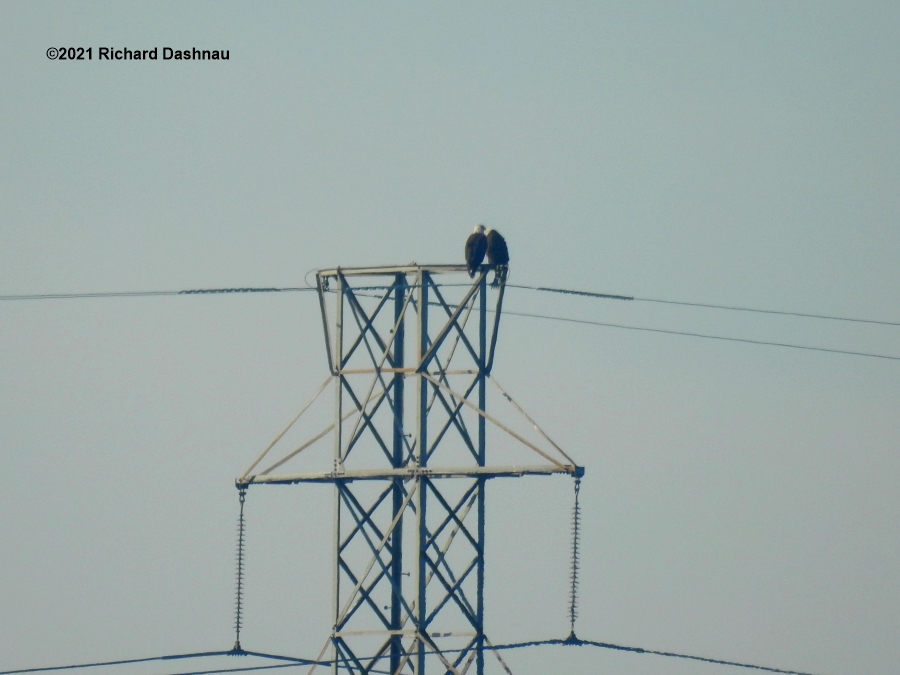
But
roads go by the power line tower. So I drove over and tried
to
get closer. I found a spot where I could stop and
pull off
the road, so I did, for just a few minutes.
I shot a few quick
pictures, and then a short video clip to get frames from later.
Here are the images and frame grabs. So, for a few days, I
got to watch 4 different
eagles pretty close to where I live--visit regularly. How cool is that?
All birds are wonderful. Look closely at any species, and you will
discover a list of amazing
attributes. Some of them are shared with other bird species, but some
are unique to that
one. But even
the other birds pay attention when an Eagle is around.
Note
that I didn't say the other birds always give way, or show respect.
I've seen an Eagle being mobbed by a murder of Crows, or even being
harassed by a single crow.
But the all the birds pay attention. I've been very lucky to encounter
Eagles at all--let alone multiple times.
And again, this is the clip that collects all the video I got for
this.
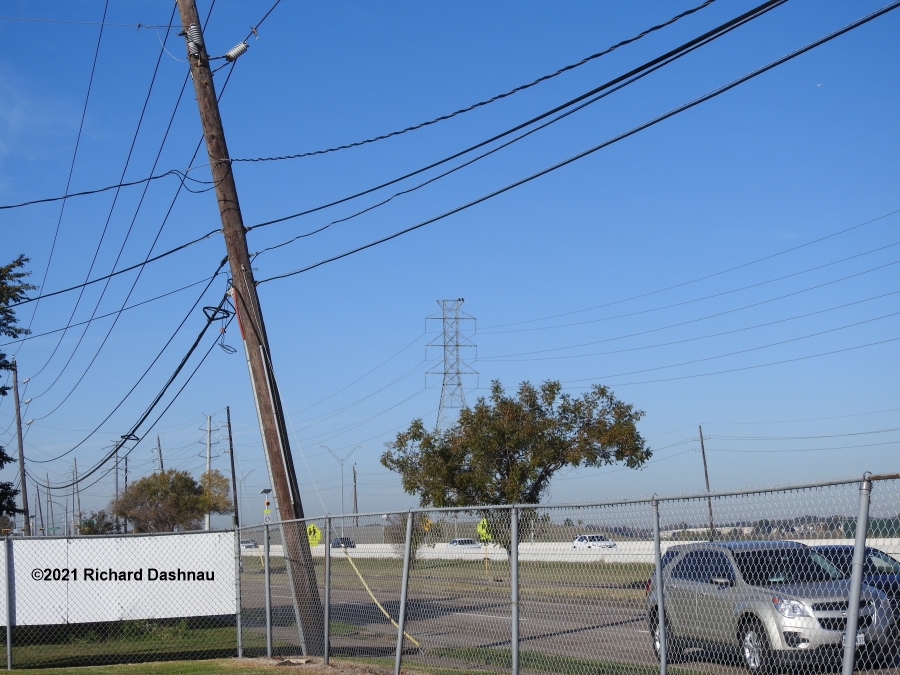
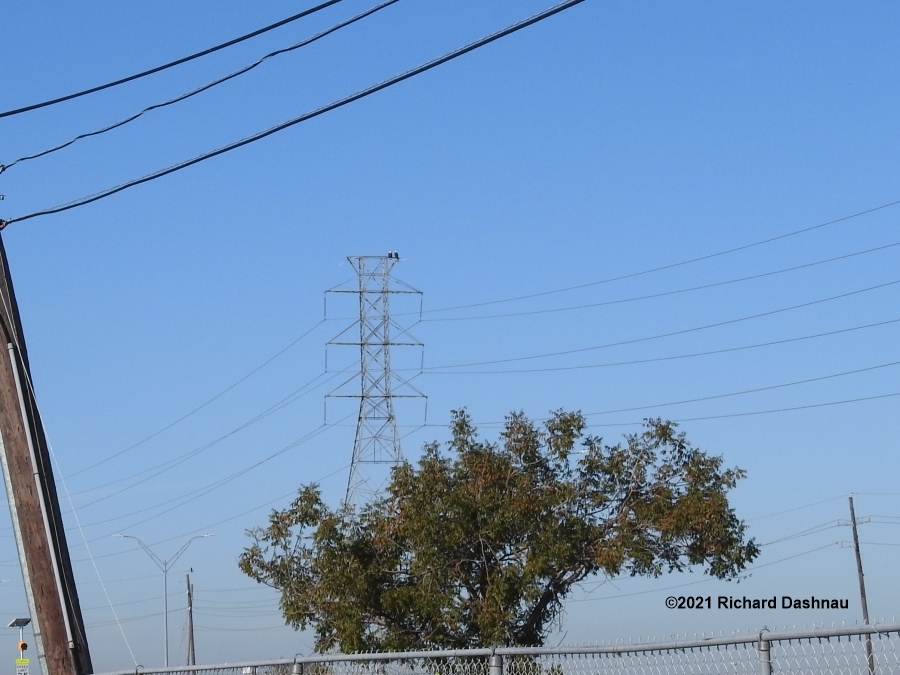
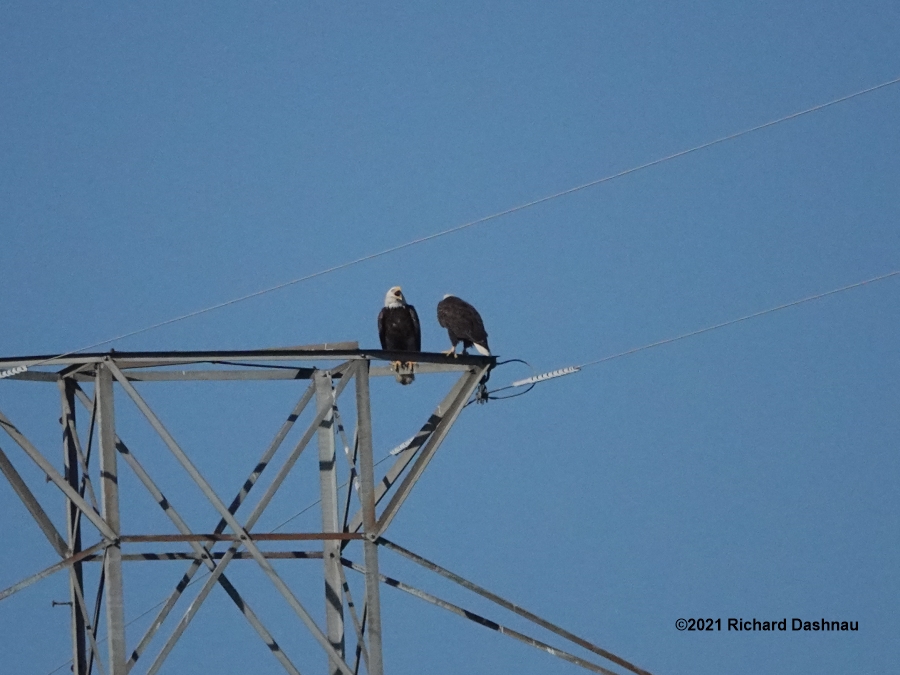
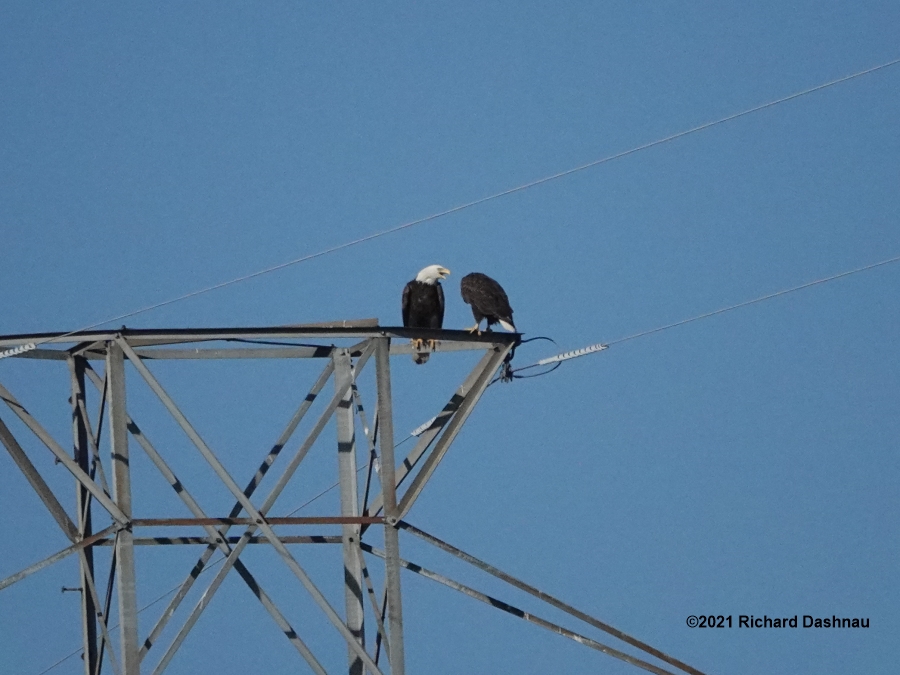
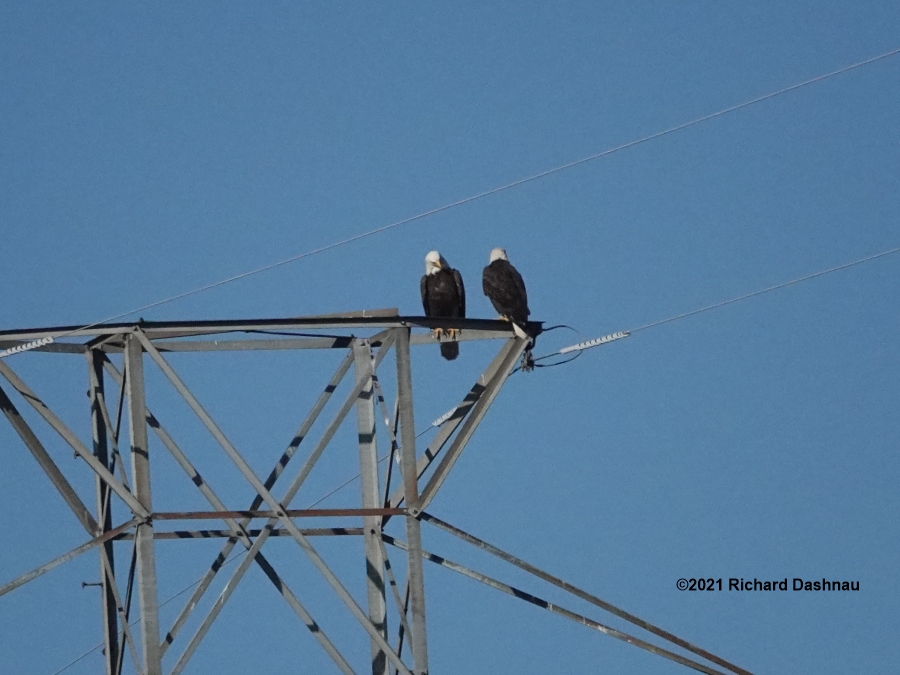
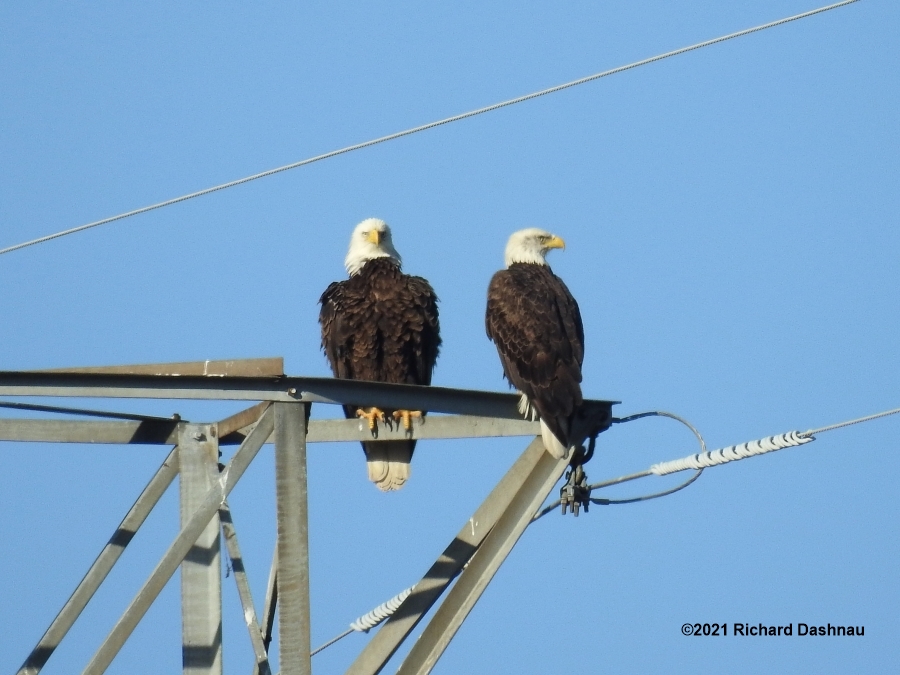
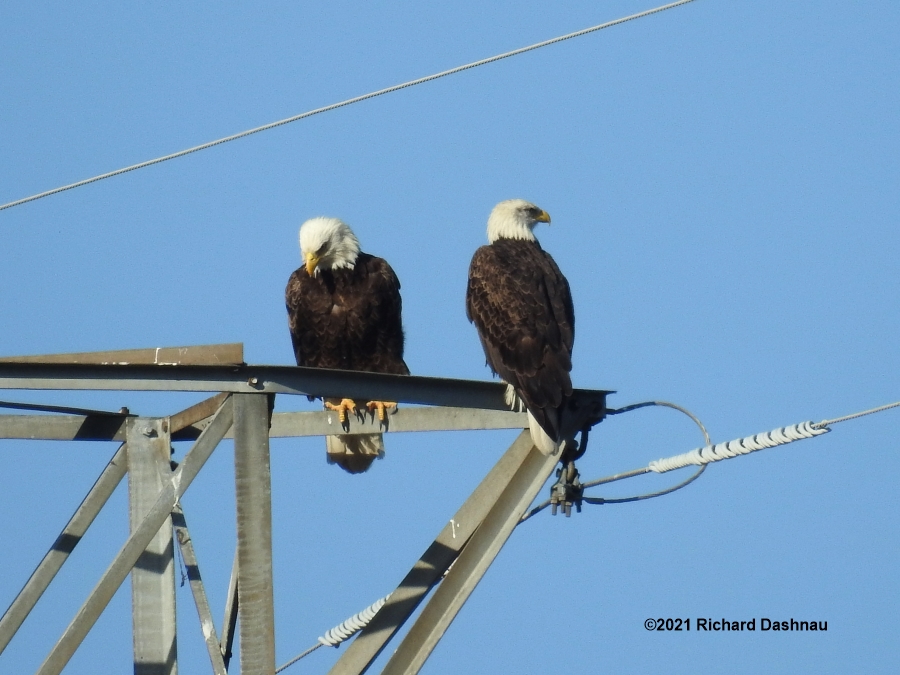

11/28/2021;
I arrived at BBSP, and a lot happened (described in various other
places). I was near a pod of baby alligators and their mother. I
was talking to a couple of first-time visitors about alligators,
then
expanded to the wonderful variation of wildlife at BBSP, and mentioned
that Bald Eagles sometimes hunt here, through fall and winter. I looked
North, across Pilant Lake and all the birds there...and there
was a Bald
Eagle flying over the lake.
I was able to shoot some short video, but kept talking to the
visitors. It was an great! I went home soon after this. The images
below are frames from the video clip.
I got a few photos, but they only
show the Eagle's backside. (The video clip is here.)
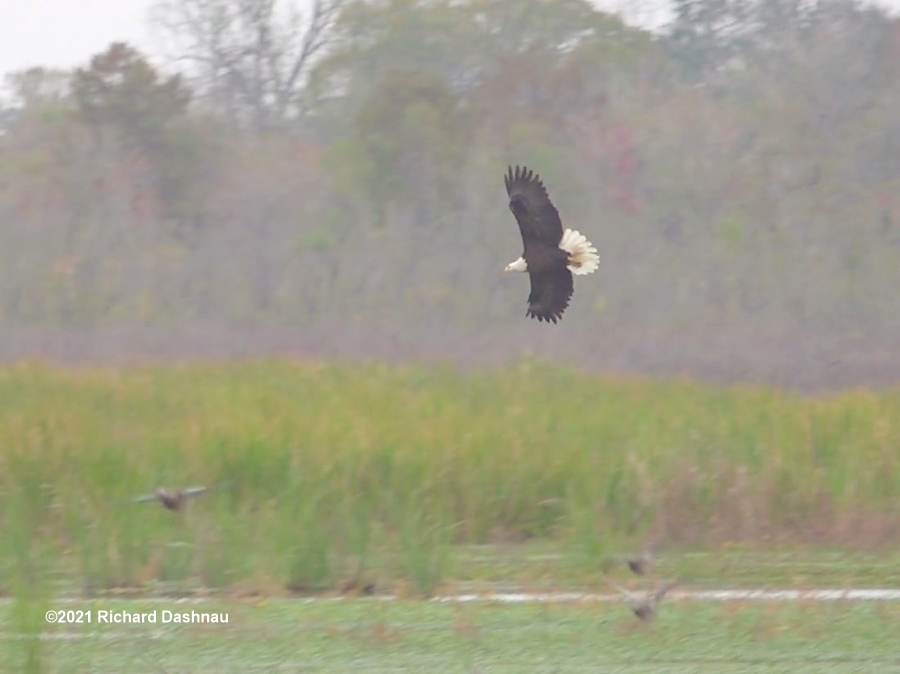
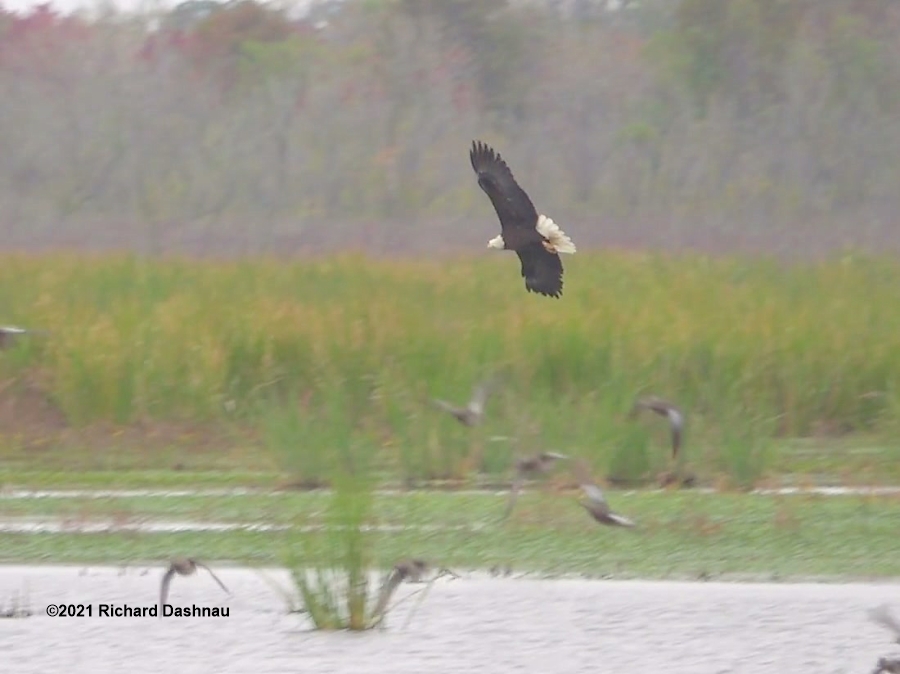
06/05/2021 (posted
6/13/21) I
visit Fiorenza Park frequently . It's pretty close to home, it covers
362 acres, it has about 6 miles of trails and a wonderful collection of
wildlife.
I've known it was connected with Brays Bayou as a
flood-prevention measure for some time. I explored for a
while. When I came back, saw someone focusing their camera at the
stand
of trees across from me. When I looked...there was a Bald
Eagle! It stayed on the branch for about 30 minutes
while I
took photos and a a few video clips. It flew off to the
West. Here's the edited video (mp4).




STAND OF TREES TO THE WEST
THE
EAGLE IS THERE!
CAN YOU SEE THE EAGLE YET?
THERE'S
THE EAGLE!




03/18/2021
I
was at Fiorenza Park North, and it was chilly and very windy. Nothing
much was happening, so I decided I'd leave. I had packed up my camera,
taken off my extra
layers
and was getting into my car when I looked
North. A Bald Eagle was flying at my eye level! I ran back to my trunk,
got out the camera, and...got a few pictures as the Eagle flew
off
to the West. Way off in the distance, I saw a smaller bird (probably a
Crow) fly towards the Eagle. Then they were gone. This was
about
9:15 am (from timestamps on images).




Inspired
by this, I stayed a while longer. I thought that maybe this was a sign
that other birds (such as the White Pelicans, Cormorants, etc.) would
start foraging and moving
around. But that wind did not let up, and after about 45
minutes, I again decided to leave. But, this time,
I stopped and looked around after every step towards repacking.
I'm
not really sure why I did this--it just seems that something
interesting has often happened after I've put my camera away. (Many of
you who take pictures of animals in the wild may
have experienced the same phenomenon).
You can probably guess what happened next. I had just closed my trunk
when a Bald Eagle appeared from the Southwest. Instead of
flying by this time, it landed in the stand of
trees
just West of the Westpark loop. I grabbed my camera and moved
near the traffic barrier and telephone pole there--trying for a little
cover. And, for about 15 minutes, I
got
to watch a Bald Eagle
in the tree as it was being mobbed by Crows. I tried shooting some
photos first, but couldn't get a good shot through the moving branches.
The first four
images
below show the Eagle as it was protesting against the Crows.
It turned its face up, and cried out.




After
shooting a few more bursts of photos such as below, I decided that
video would be more useful, since at the very least it could give me
many more images.




I
was facing directly into the wind. Shooting video requires stabilizing
the camera much more to get a steady product. At times, I could barely
stabilize myself, let alone the camera!
Also, I realized that the
audio would be useless, as it would be overpowered by wind noise. I
filmed video anyway, because I didn't know how long the Eagle would
remain. If I shot
bursts of full-sized photos, I'd lose a second or
more each time I stopped as the photos were written to storage. The
remaining images below are frames from the various video clips.
The four images below show Crows passing near the Eagle while they mob
it. I spent HOURS editing the clips into this
6-minute video that turned out ok.




The
Eagle finally had enough of the harassment, and decided to leave. But,
the Crows weren't done with the Eagle, and they chased it above the
field to the West. Then one picked up
the Eagle again, and I saw
them as two dots moving off in the distance. The frames below are also
from the video. Here's a link to this
6-minute video again.




02/07/2021
Out
at Fiorenza Park North again, It's not too far from
home. I got there
about 9:45am. In about 10 minutes, I noticed a hawk in a
tree just across from my car. I think it's
a
Cooper's hawk, but I've been wrong before. Going by the chest, and the
yellow eyes, it would be a young hawk. I didn't get much
closer before it flew away. The two pictures below are
actually
two cropped versions of the same photo. I walked back to the
sidewalk near my car and looked around.


Cooper's Hawk watching me.
Closer view.
Ten minutes
later, a Bald Eagle flew over me, and around the park! I
hadn't even
walked 20 yards, and found two raptors in 20 minutes. It was
great!
The Eagle cruised over the North
portion of the lake, and then
flew off to the South. I shot video of most of its flight, along with a
few snapshots during the capture. The three images below are from the
photos.
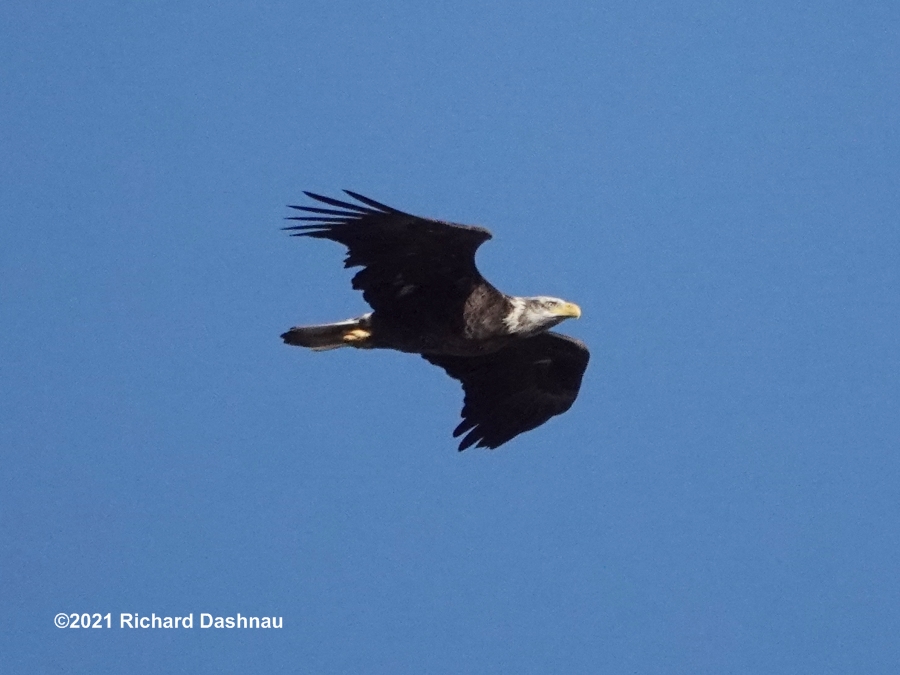
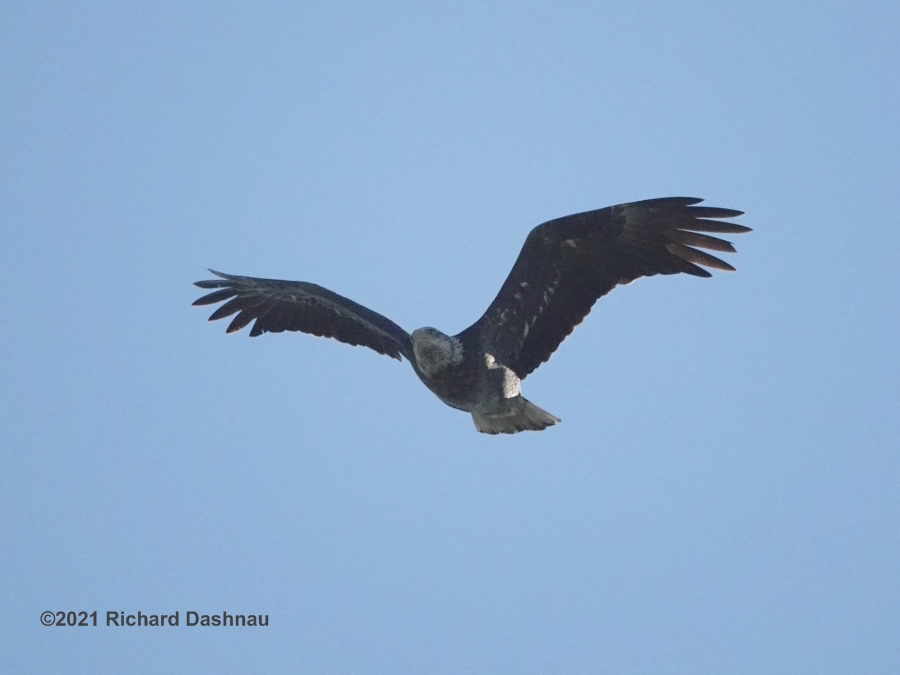
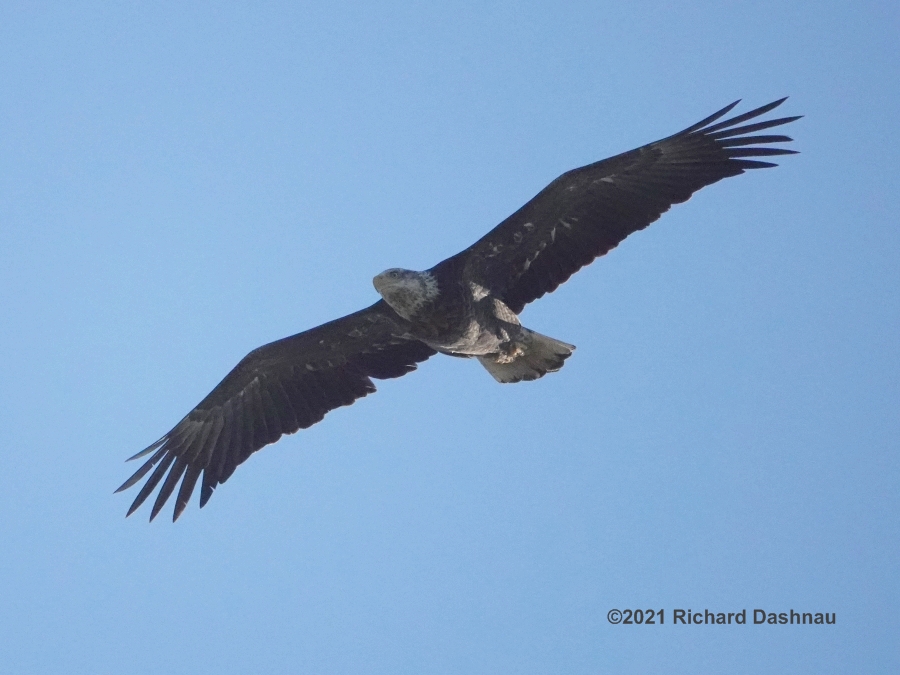
Bald
Eagle flying by
Bald Eagle flying toward me
Bald Eagle partially shaded
While
I reviewed my images, I wondered if I could figure out how old the
Eagle was. I knew it wasn't an adult because its head and
tail
were not bright white, although the body and
wings
were mostly dark, without many lighter feathers or markings.
I
found three interesting sources for identification online. They all
agree--and one of them is source material for
the first one. 1) Avian
Report webpage. 2) Article(pdf)--"
Molting sequence and aging of Bald Eagles." by McCollough, M.
A. (1989) 3) Article(pdf)--"Aging
Bald Eagles" by William S. Clark.
Going
from what I saw in
the first one, this Eagle is about 3 years old, generally an "immature"
Eagle. I've uploaded the video, and you can see it by following this link (mp4).
The series of
images
below show one wing beat cycle--as good as I could get.
The
camera moved a lot while I was trying to follow the flying Eagle--so
the video will be a bit shaky(although I did slow it digitally 4X).
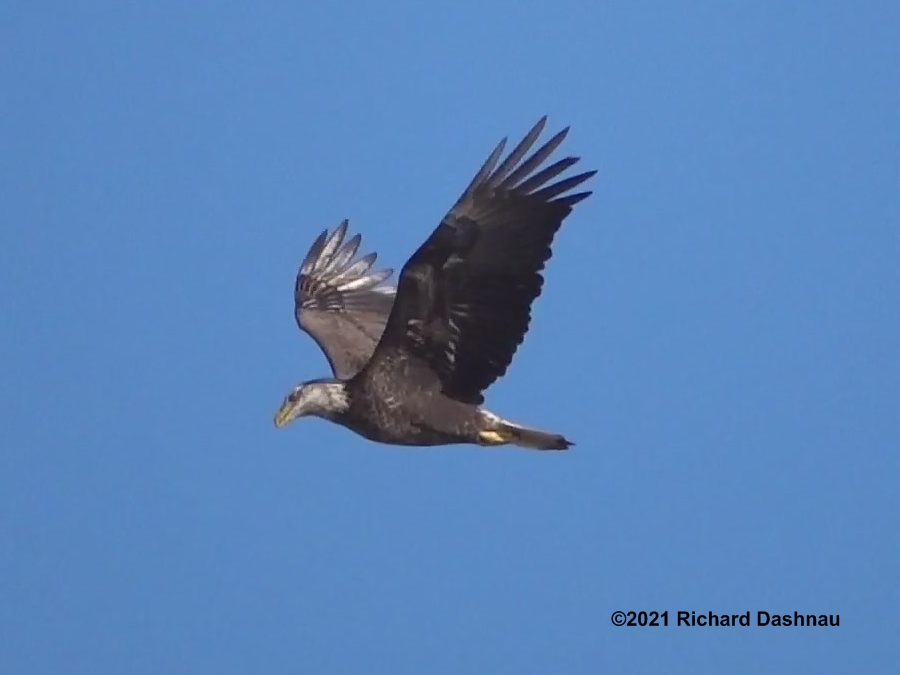
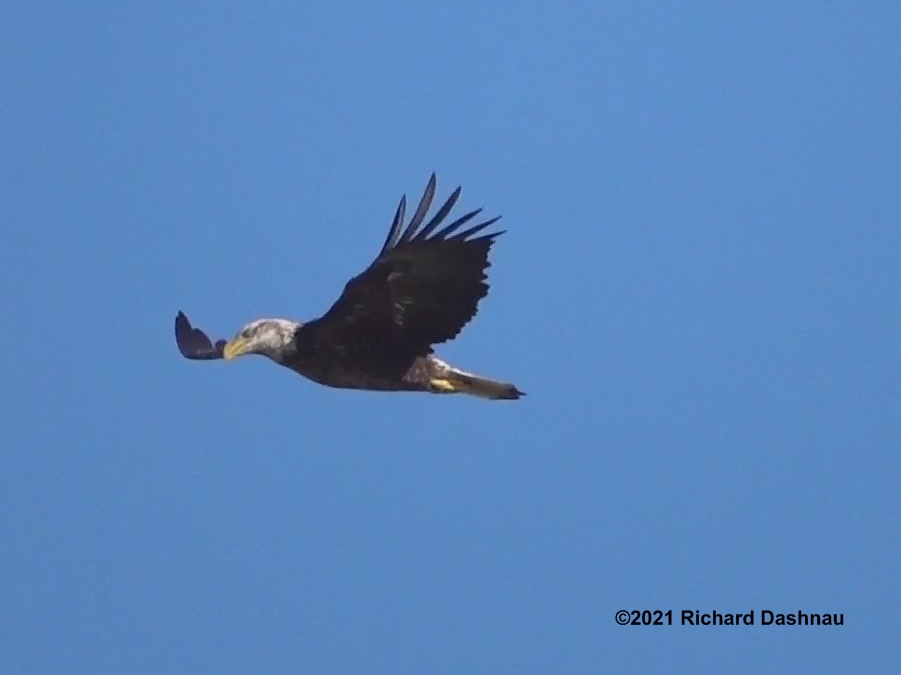
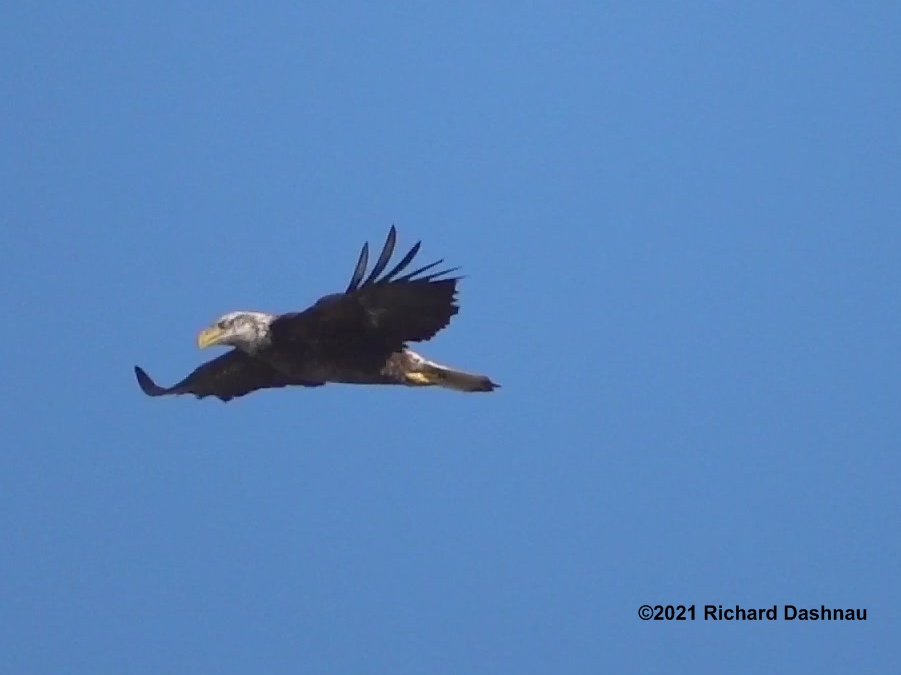
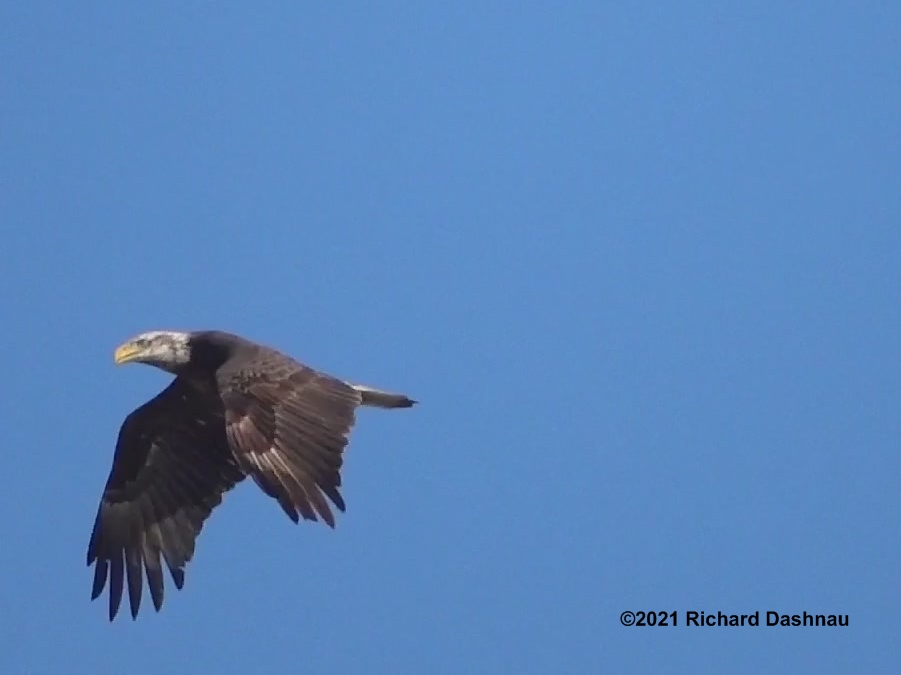
Down stroke 1
Down stroke 2
Down stroke 3
Down stroke 4
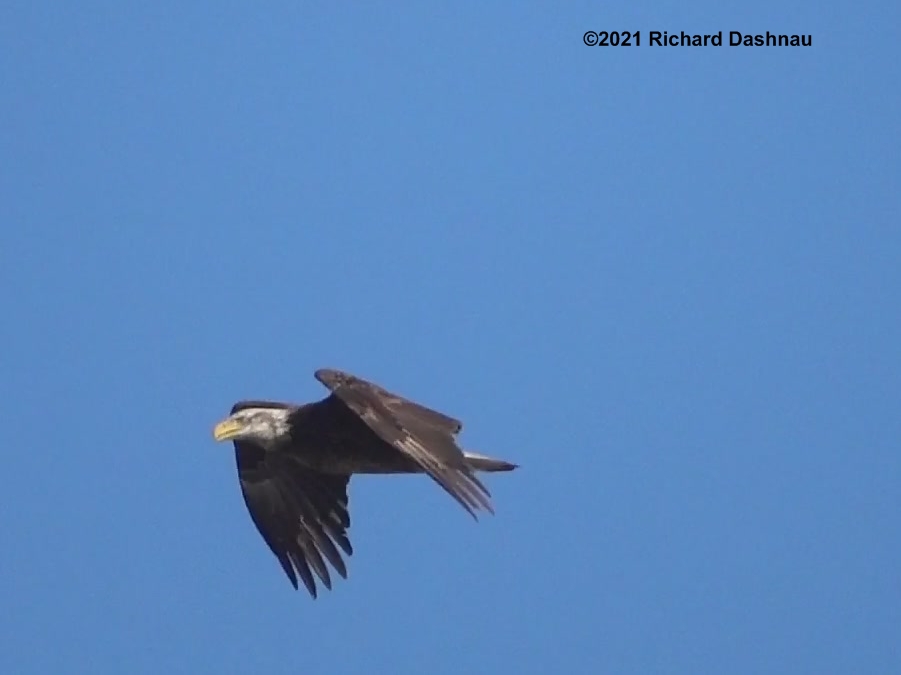
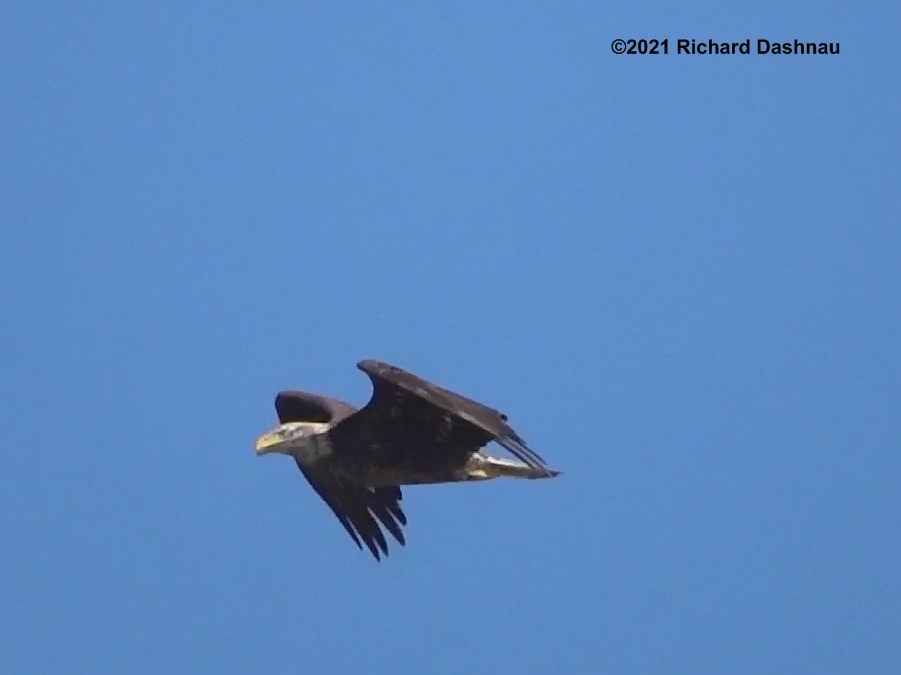
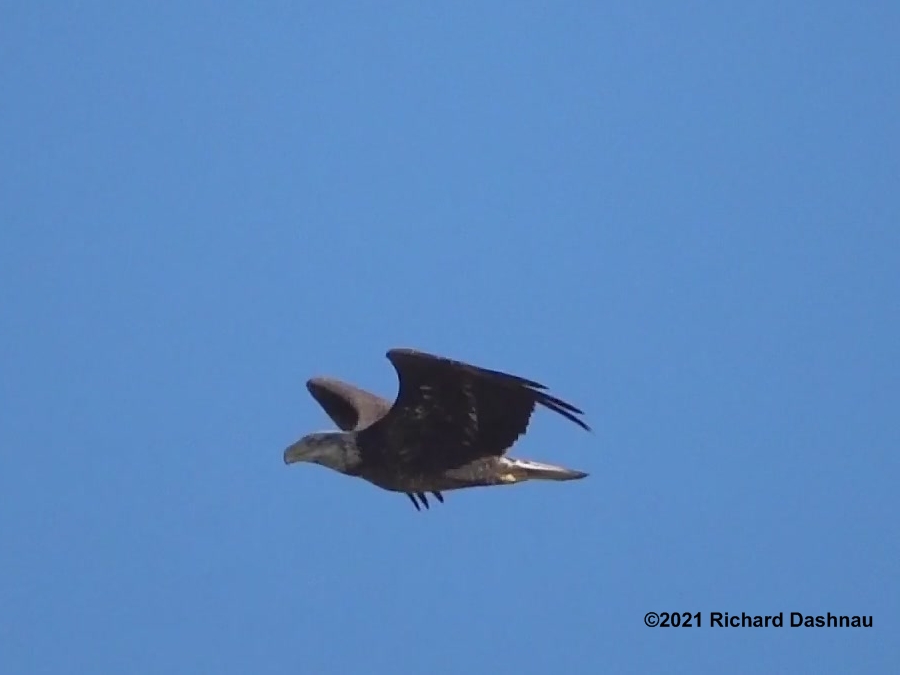
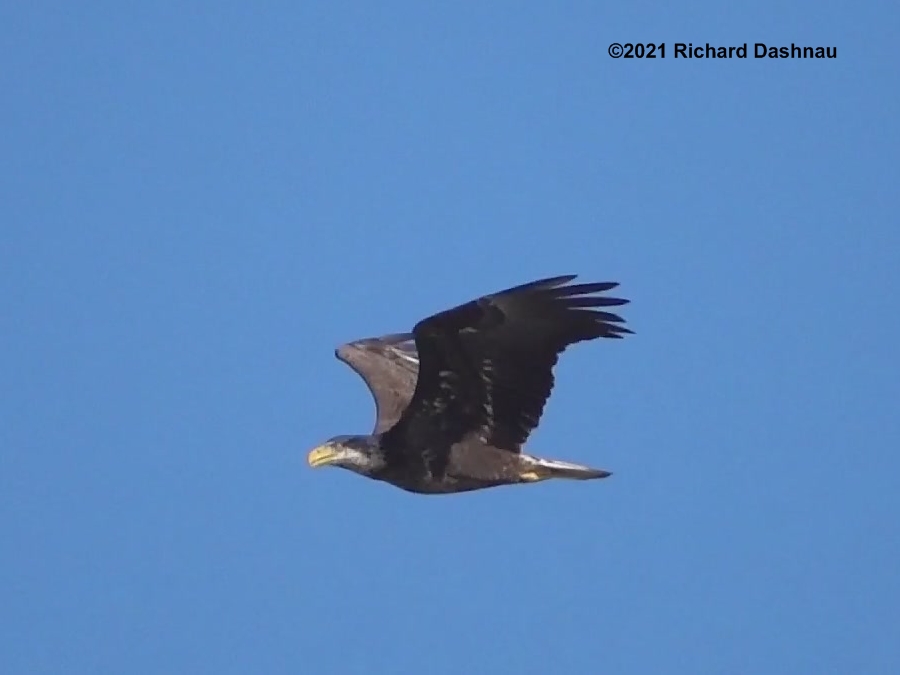
Up
stroke 1 (wings also fold)
Up stroke 2
Up stroke 3
Up stroke 4
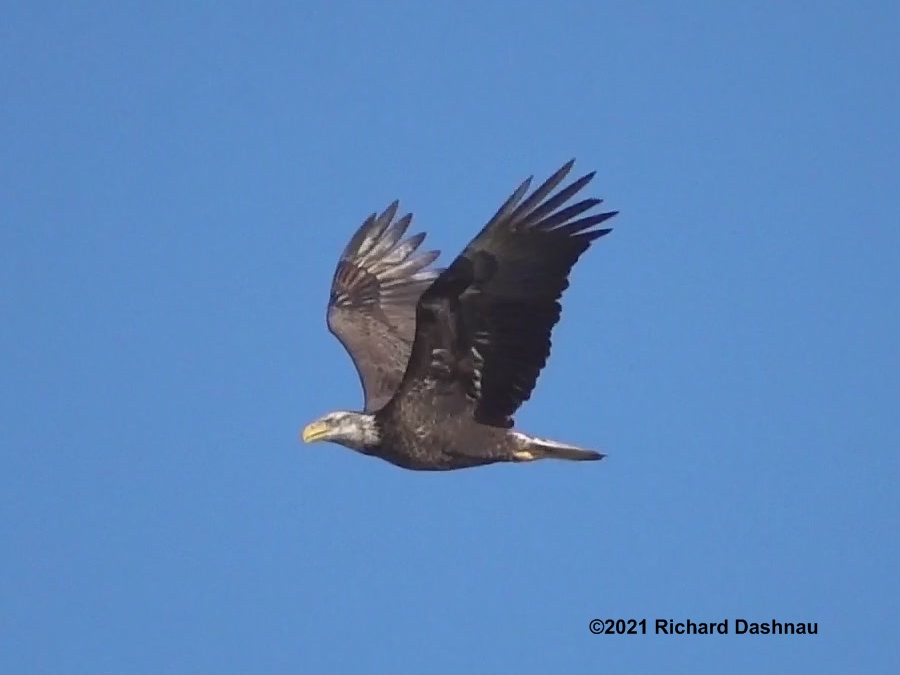
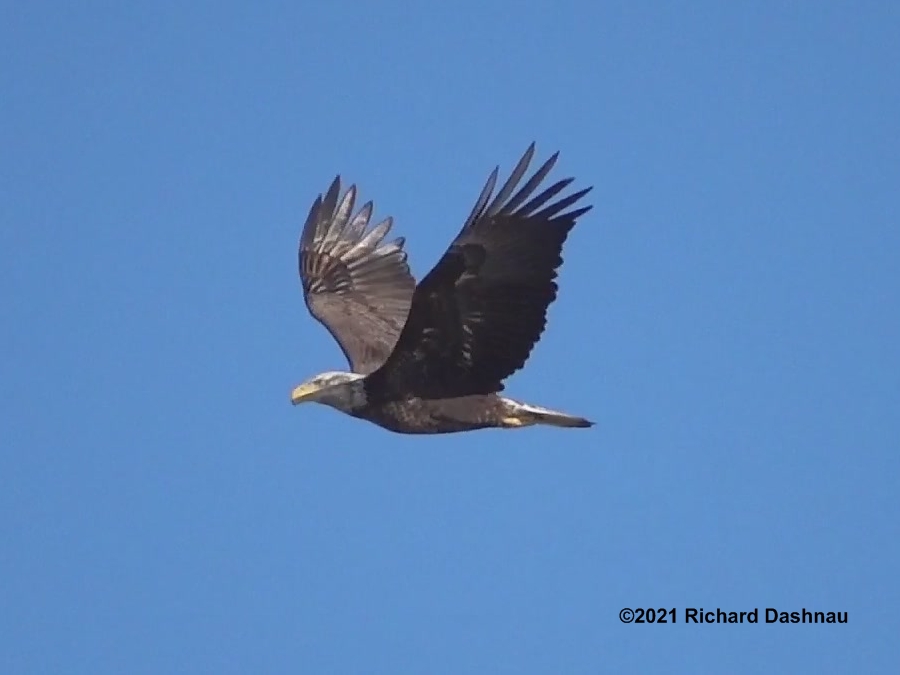
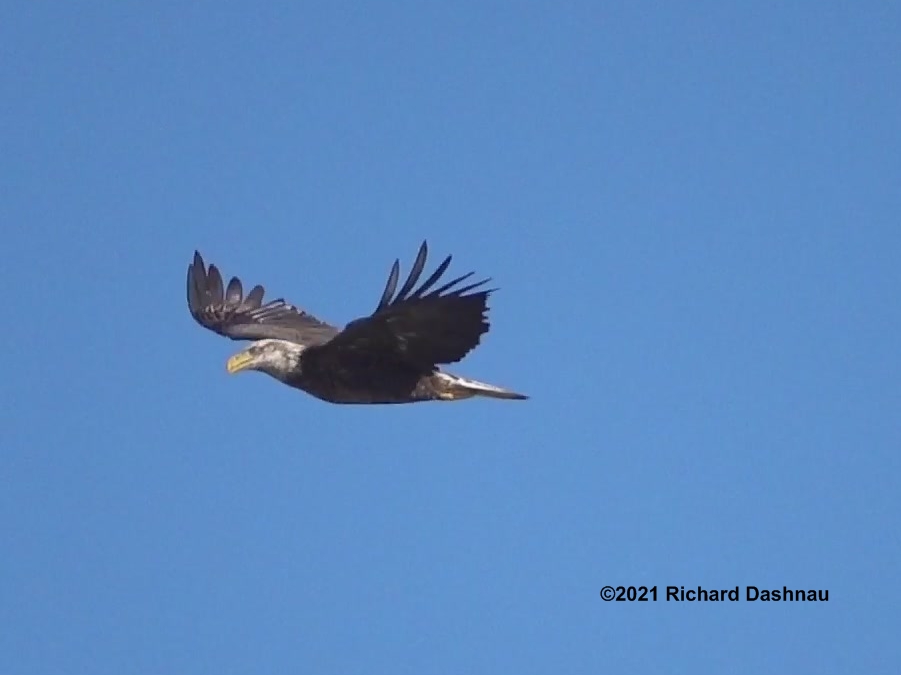
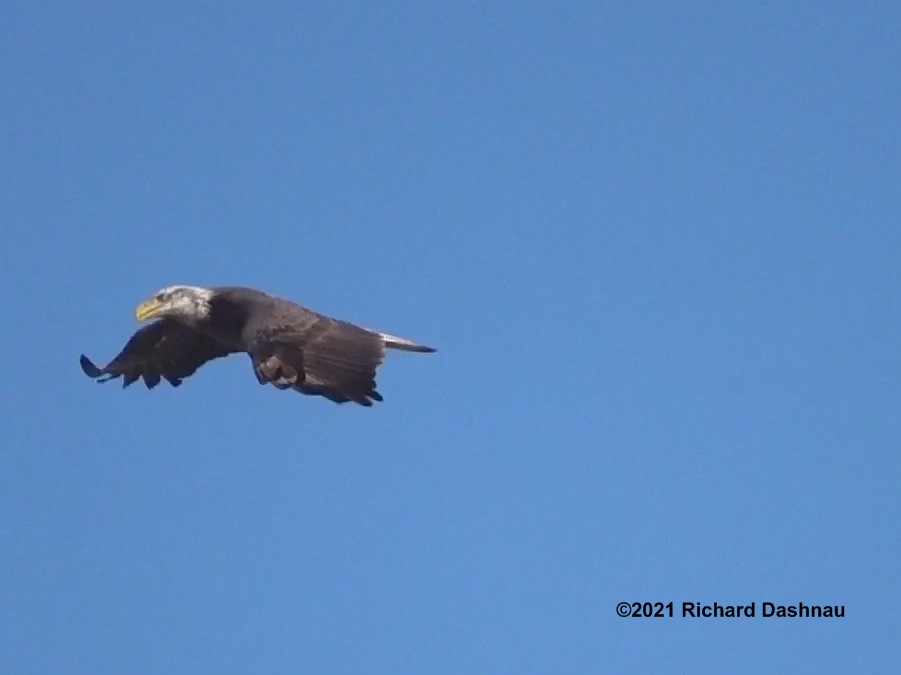
Top of Up stroke 1 (wings
straighten)
Down stroke 2
Down stroke 3
Down stroke 4
That
was really great, but the morning had one more surprise for me. I had
had to work on my phone a bit from inside my car. I finished,
and
I looked out to the South, and saw
an
Osprey flying over the South
section of the lake. I hurried out, and tried to capture
that
one on film, too. I caught some video, but it wasn't very good...but I
did capture the
two
images below! What a great morning. I shot
a slow burst of photos as the Osprey flew by to my South, going West to
East. The timing of the burst caused my to catch two photos
of
the Osprey's wings on the down stroke of two different beats.
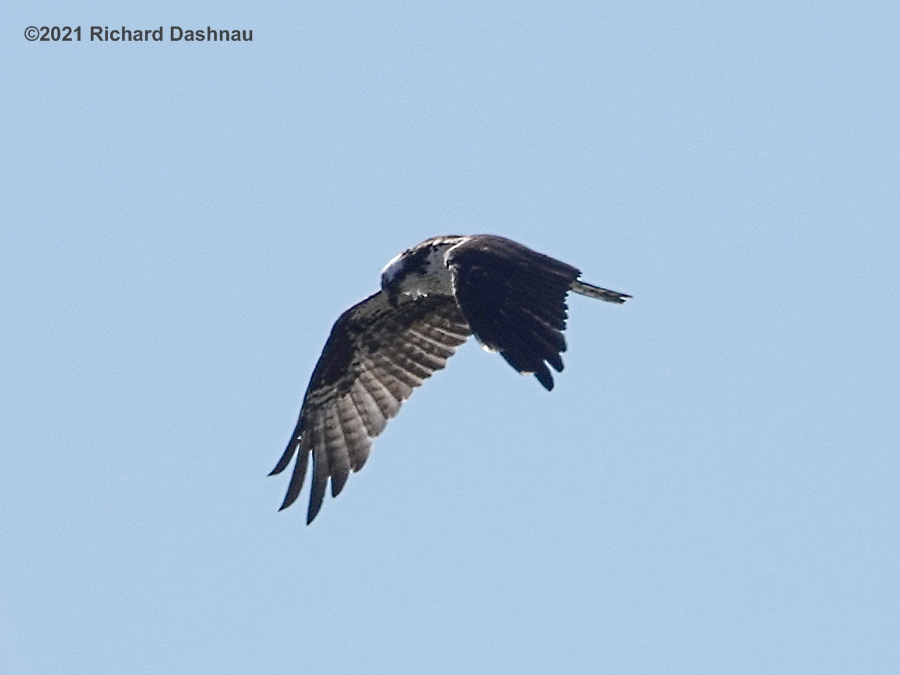
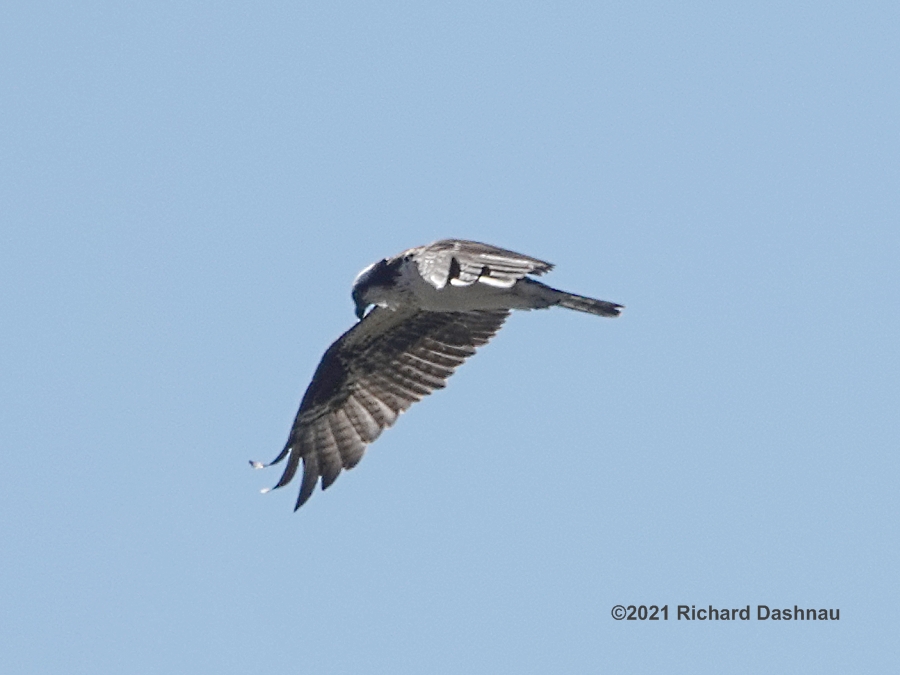
Top of Up
stroke 1 (wings straighten)
Down stroke 2
11/17/2019 A
park visitor told that he'd seen two Bald
Eagles in BBSP. I was happy to hear that eagles were visiting
the park. A little later
I
was walking with one of the bird hike groups that I'd just met.
They got word that the eagles had reappeared. We
weren't
far away, so
we
walked over...and there they were! All of us started taking
pictures. The images below are some of mine.
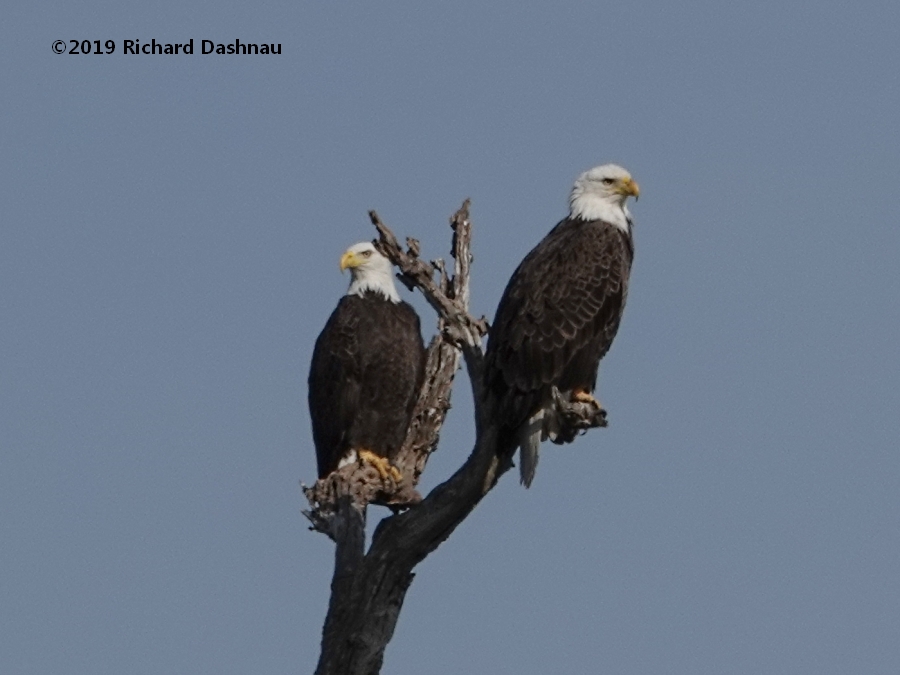
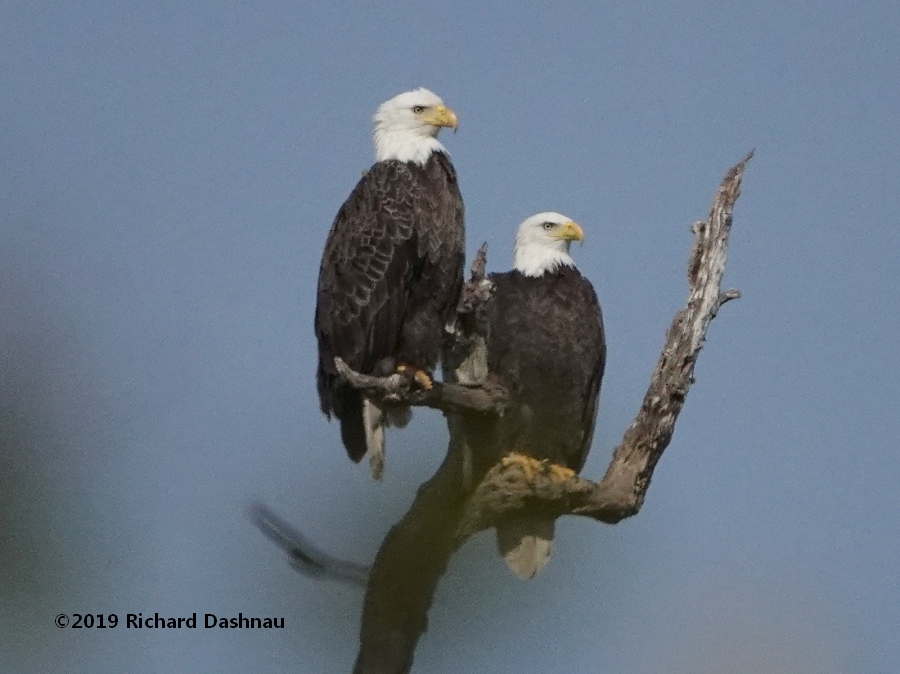
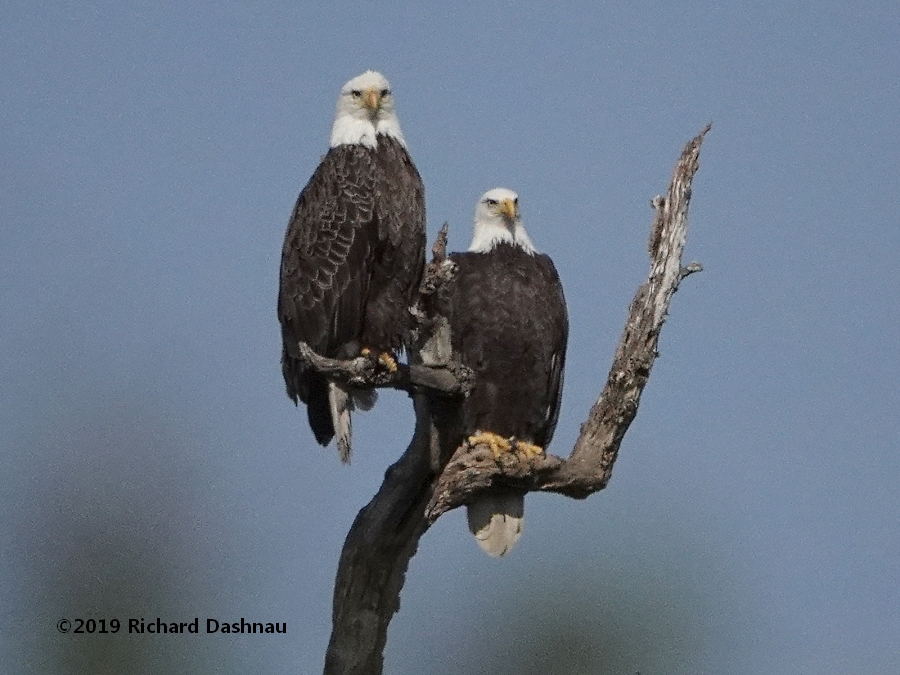
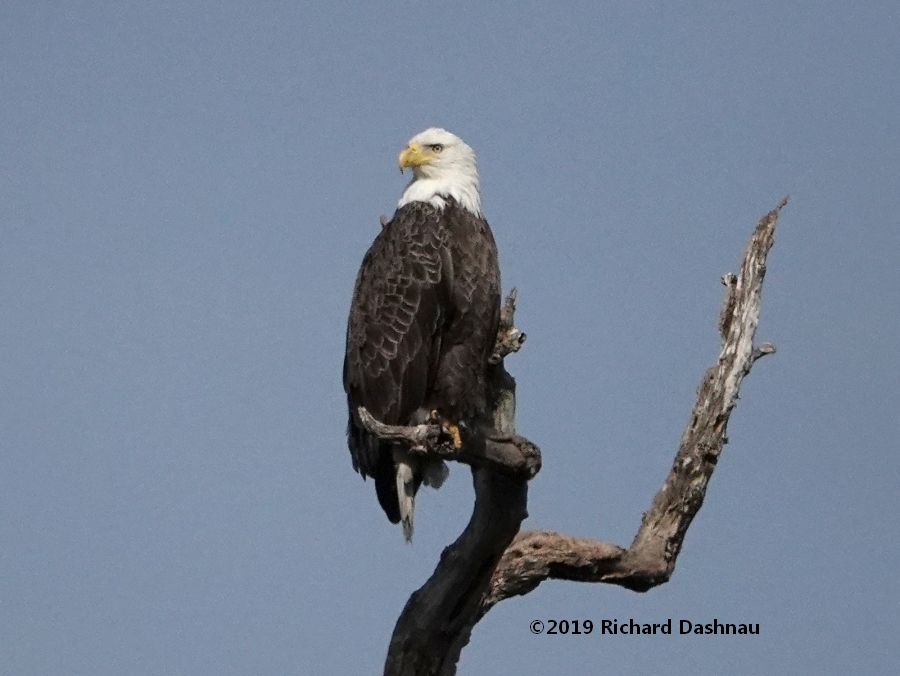
I
have seen an eagle at the top of this same tree just last spring.
Pictures from that time are on this page. I was
able to
stay near the eagles for about 15 minutes,
before
I had to leave to do some work in the Nature Center. Before I
left, I tried to catch video of the eagle as it flew. This
requires a constant recording of 480 fps,
and this stops when I
want to save. The eagle didn't fly, but I did catch the
arrival
of another raptor. The visitor was an American Kestrel (Falco
sparverius). I've
edited that with these images into a short video clip. You
can see that video here(mp4).
03/17/2019
I was walking on the South loop of the Elm Lake Loop trail. I was near
the head of the Pilant Slough trail, and as I looked North over the
lake, I noticed a flock of
Whistling
Ducks (Dendrocygna autumnalis) take wing from the Northwest (to my
left). I looked up and a bit to the right (East), and there
was a
Bald Eagle (Haliaeetus leucocephalus)
flying by. It circled around
and I tried to get the camera to focus on it. When it flew over some
trees and was blocked from my sight, I lost the eagle. I had just
turned West to tell
a park visitor down the trail about the eagle
when it reappeared overhead. This time, it flew Northwest over Elm
Lake. I started walking West to try to keep the eagle in sight.
When I saw
it again, it was perched at the top of a tall dead tree, somewhere
North of me.
I
couldn't tell if the tree was in Elm Lake, or across the trail to the
West. So I walked rapidly around the bend and moved
Northwest. I found the Eagle was in a tree just
West of Elm Lake, close to where the Elm Lake Loop meets the Horseshoe
Lake Loop. (Looking later at Google
Maps, I could see that the tree was about 2000 feet straight
from
my original position, but I'd walked about 3500 feet to get there).
I looked through the trees lining the trail to see the Eagle.
I shot a few pictures and video clips,
before the Eagle took
off. But, it circled over me a few times before moving away.
The images below are cropped from larger photos I shot of
the
Eagle.
My video
clips showing the Eagle can be seen
here(mp4).
Bale Eagles nest in Texas during the winter, but many return
North after the new hatchlings can fly. While they are here,
they
hunt a varied group of prey. I've found two studies that
describe
what has been found in Eagles' nests in Texas and in
Louisicana.
These links should bring you to them:
Prey
of Nesting Bald Eagles in Texas
; Foods
of Nesting Bald Eagles in Louisiana



01/07/2018. One
of those
days, at Brazos Bend State Park. On Saturday, January 6, volunteer
Chuck D. showed me that he'd gotten some great pictures of a juvenile
Bald Eagle at 40 Acre Lake.
On Sunday morning the next day
(01\07) , I was out at 40 Acre Lake (where I usually start
anyway). I was near the Observation Tower, and watching the
sky,
and also looking and listening for signs of
disturbance from the
many wading birds and waterfowl in the area. American Coots
occasionally bickered out in the water and chased each other. Once, the
coots sounded a bit different, so I looked
to my left (North)
until I saw movement in the water near the coots. I wasted a second or
two as I went through what normally moves
out there. Anhinga? No. Cormorant? No. Diving Coot?
No. Grebe?
No. Otter!? YES!! It was an OTTER!! I quickly
brought the camera up and started shooting video. I tried not to move
as the otter came closer. It swam to the edge of the floating hyacinth,
then it dove.
It
was about 10 yards from me when it went under. The pictures below are
frame grabs from the video. And the video is here(wmv).
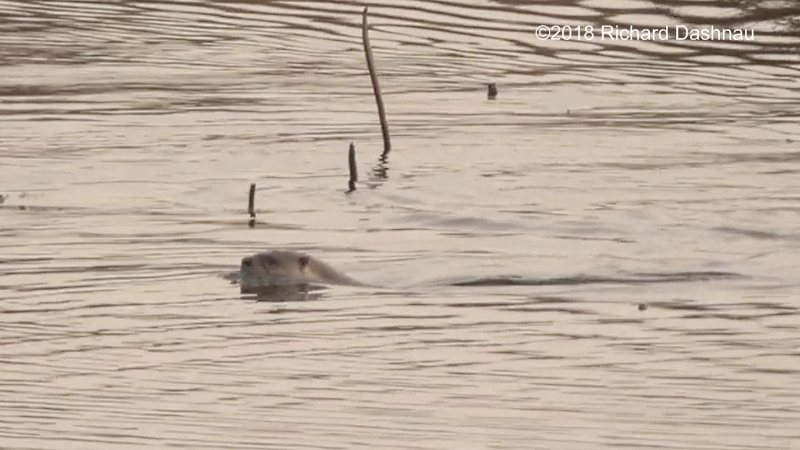
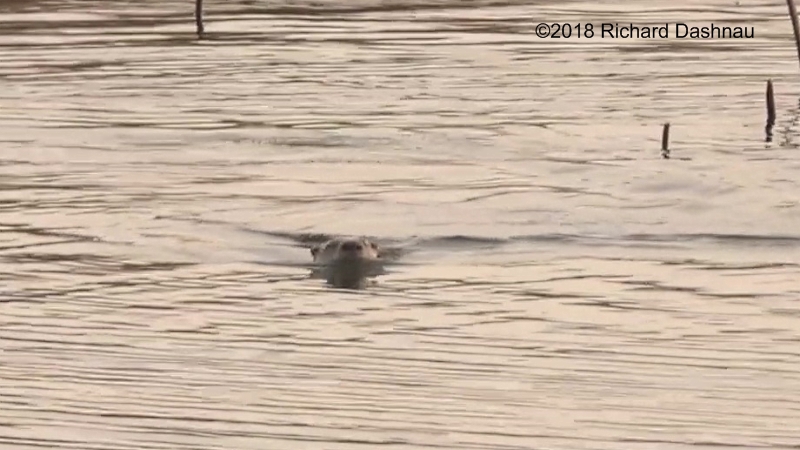
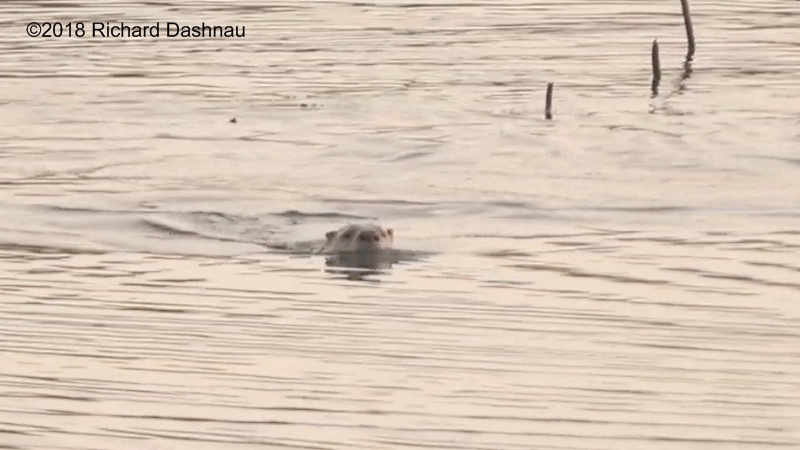
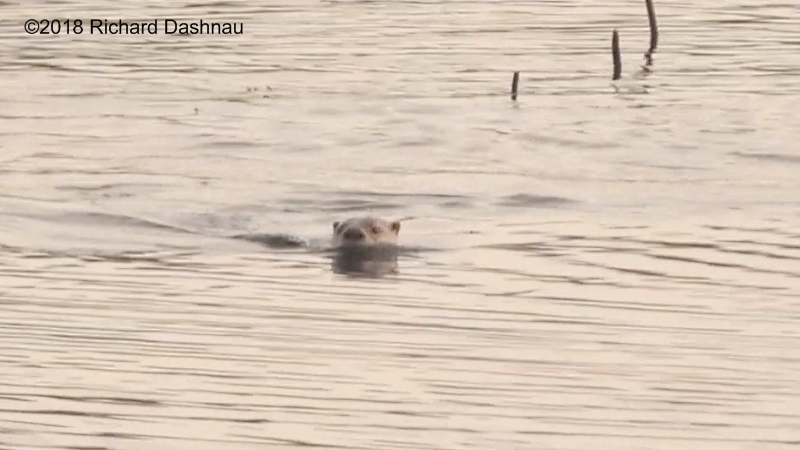
It
seemed to me that it might want to cross the trail (probably close to
the concrete around the culverts). So, following my own advice, I
backed away from the tower about ten steps. This was to allow
room
for the otter to cross. And...nothing else happened. I looked all
around for a sign that the otter was moving. I looked behind me in case
the otter passed me. I looked down and to the right (South) in
case
the otter crossed and went into the lake leaving a wake. I spent a
few more minutes looking back and forth. I didn't see the otter again.
It might have crossed in front of me after that. But I could have missed
it; because I was distracted. Because...when
I was waiting for a sign of the otter I happened to look right again
(South), but this time I looked *up*....
And
the juvenile Bald Eagle was circling in the air above the lake. I
caught some video of the eagle as it circled around (it was near the
Southeast corner of the lake) and it made an aborted talon-strike
at
the
surface of the water, then landed in a tree. So, while I was watching
that, the otter could have crossed to the East. What a
choice!
Should I watch for the otter to reappear...or for the eagle to
move?
I watched the eagle, and it took off again, but moved away from me,
then looped around and went West. The images
below are frame grabs from the video. The video does look a bit better.
And that video is here(wmv).
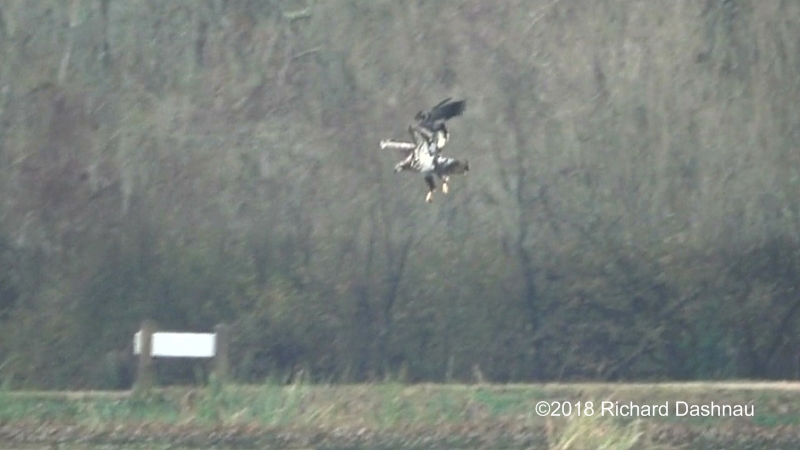
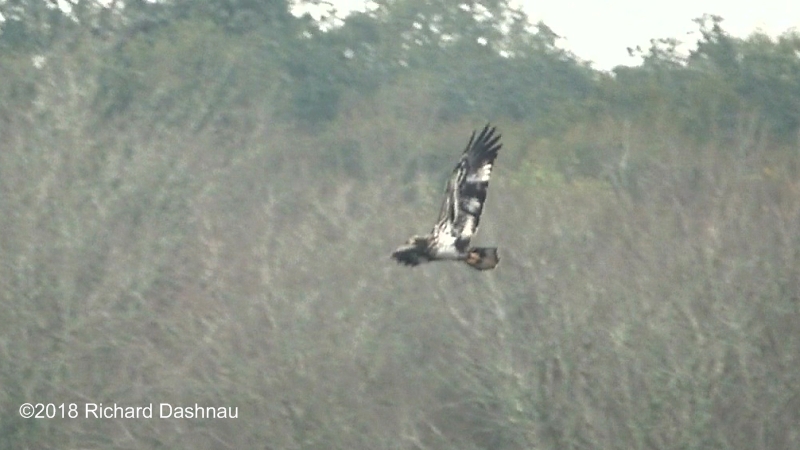
Those
of us who have been able to see otters are often confounded by their
ability to move quickly and with stealth. I found some
information in this document:
North
American River Otter Husbandry Notebook, 3rd Edition
Edited by Janice Reed-Smith 2008
The
aerobic dive limit for an otter (how long it can stay under holding its
breath) is 50 seconds. (Page 27) But average dive
time is
21 seconds ( page 28). Top speed of an
otter in water is 7 miles
per hour. (That's about 10 feet per second) (page
28) If we
cut that in half (considering we usually see otters relatively at ease)
that's 5 feet per second. In a 21 second dive, at 5 feet per
second,
an otter could move 105 feet (35 yards) or maybe as far as 210 feet (70
yards) if it's in a hurry. There are some good online
sources for collected information about otters. Some day I'll be able
to examine all that's there.
Here are two:
river otter
alliance
otter
specialist group
As
for the young eagle. Sources on the TPWD website say that Bald Eagles
lay eggs in December, and eggs incubate about 35 days, to hatch
sometime in January. The chicks leave the nest in about 12 weeks,
but
the
parents still feed the young for another 4 to 6 weeks while they
learn to hunt. So eagles hatched this season should still be in the
nest (not flying around). The feather markings change as the
young eagle
ages, with the
prominent white head and tail and dark body appearing
only in mature adults (about 5 years old). This one might be close to 2
years old. I'm guessing by comparing with my Sibley's field guide
and my National Geographic
field guide--which show more white patches
on the wings during 2nd year. I'm sure the birders out there can
correct me.
03/25/2017
After
the
morning rain, the sun brightened the day, so I visited Fiorenza Park
(the Phase 2 section). The park looked great, and I hadn't been there
very long when a Bald Eagle landed in a tree about 50 yards above me!
While
it stood on a branch and preened itself, I shot a number of pictures
and a a few video clips. Even though the eagle didn't "cooperate" by
standing clear of all obstructive branches, I was still very happy to
see it. I stood ready
to
film the eagle's take off, and even
so, I missed the launch. The eagle flew into the trees, then back out
and over to the cormorant nest island.



I
saw the eagle apparently land behind the trees on the island. I waited
and kept watching the island, since I'd hoped that the eagle had
descended to catch something. Meanwhile, I watched the various
cormorants, grebes, spoonbills
and other birds. Then I
noticed a
mixed flock of birds fly left--out of the trees on the island. Amongst
the pink of the airborne spoonbills and the black of the flapping
cormorants I saw the eagle! It flew free of the other birds
and
landed
on a far bank. It had been carrying
something, but I couldn't tell what it was. The three images below are
from a burst I filmed as it flew.

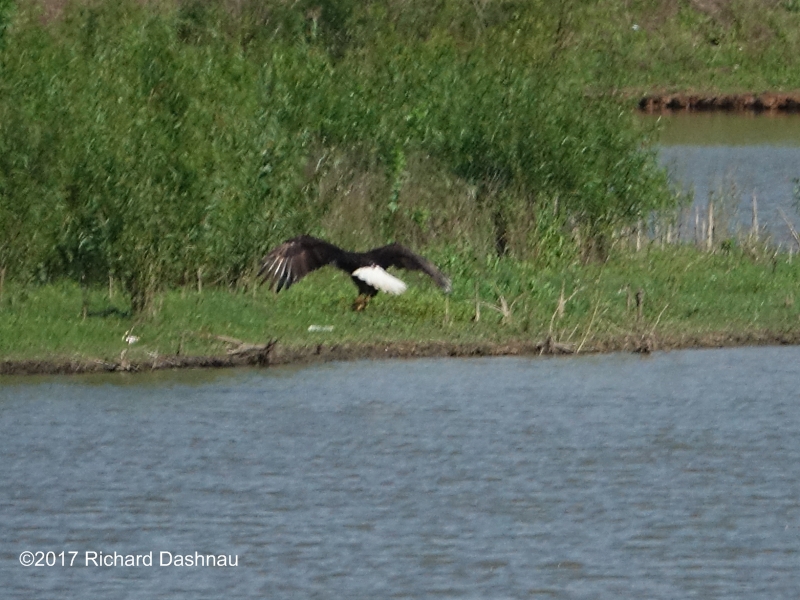

I
watched anyway through binoculars and camera as the eagle ate, then
seemed to wade into the water and either drink or wash its beak.
Finally, the eagle took off and I lost sight of it as it flew behind
the trees of the cormorant island
again. I've edited some of the video clips together. That video can be
found by
following this link(wmv).
The two images below are of one of the flocks of Roseate
Spoonbills that flew by. I think it's great that this wonderful park is
only
15 miles from midtown Houston!


03/20/2016 I
was interpreting baby alligators at Creekfield Lake for some visitors
when I became aware of the sounds of
disturbed birds behind me. I turned around and saw Whistling Ducks and
other birds flocking and making short,
panicked flights in the
center of the lake. Then I looked a bit higher...and saw a Bald Eagle
above them!
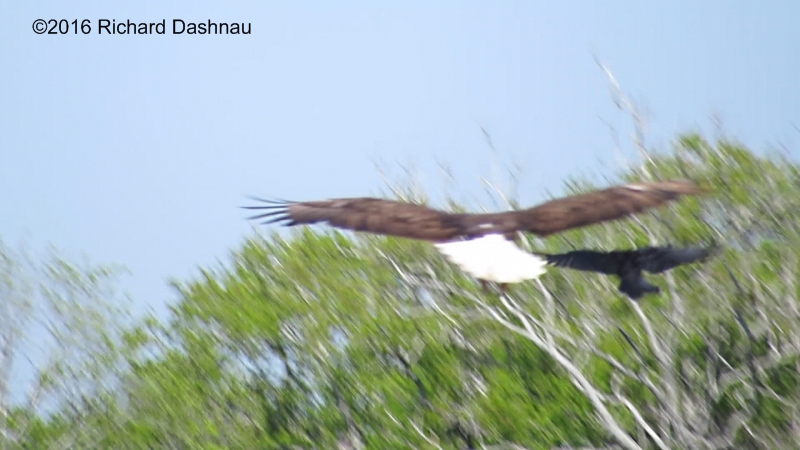
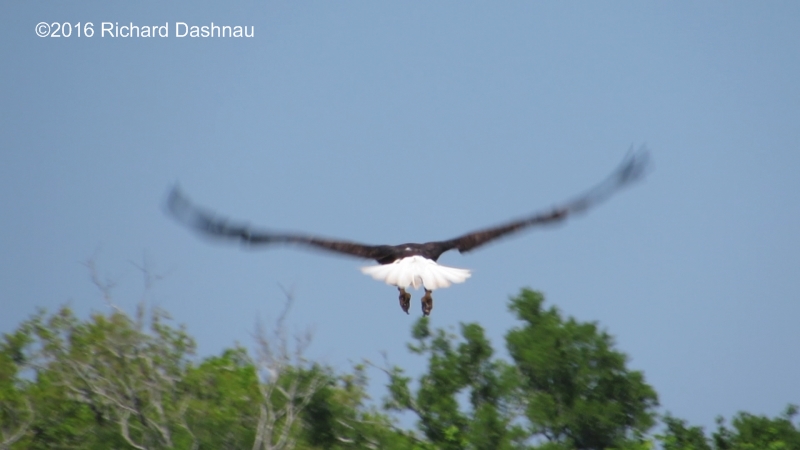
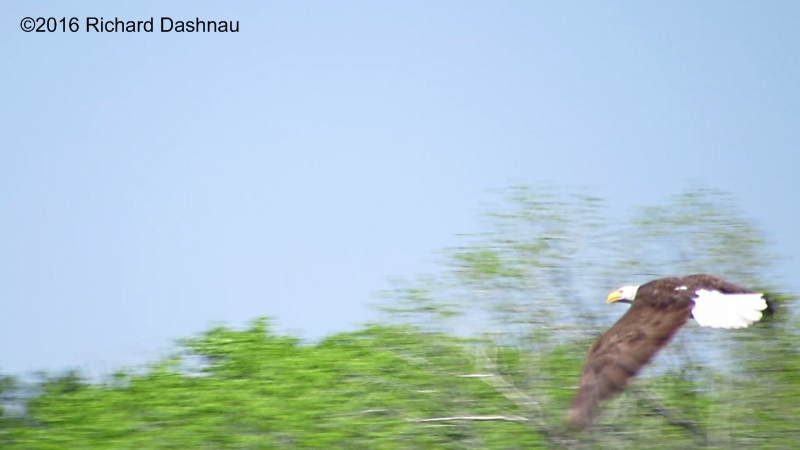
It
circled and attempted to dive at the ducks. I shouted to the group
around me and pointed out the Eagle as it circled and tried again. I
brought my camera up and tried to track the eagle and shoot
pictures. I'd been focused on the gator
babies, and couldn't change
settings on the camera without losing the eagle...so I shot what I
could. It moved too quickly to easily focus, and all the while I
kept repeating "LOOK! Look at the EAGLE!!"-and describing the action to
the
crowd of visitors. Waterfowl in the area were flying around, and a
crow harassed the eagle. The pictures above are frame grabs from the
short video I got. That video can be seen
here(wmv).The eagle flew to one of the large trees on the
West side of the lake...where black vultures were perched.
The vultures all took off, and then the air around us was filled with
ducks, coots,at least one crow, and vultures. There was the panicky
flapping and calling of the various waterfowl
all around; while the
vultures quietly flew in multiple paths above them,showing their
discomfiture in a self-possessed manner. It was an amazing sight! I
called the eagle a"T. Rex in the sky, on the hunt."
The sky
eventually cleared, and the Eagle took off from the tree,but it flew
North, and didn't go over the lake again. While talking to the
visitors, I guessed that the eagle we saw might have been an
inexperienced juvenile, possiblyfrom the
nest at Oyster Creek. Although
it was chilly and windy, it turned out to be an outstanding day!
March 09,
2014 I'd
missed the previous weekend at the park because I moved to a new
apartment. This was the first weekend in almost 2 months that I was
able to relax (no more packing/unpacking/moving), and BBSP gave me a
couple
of treats. I was
walking on the North side of the 40 Acre
Lake Trail at about 8:45, when I noticed a pair of Red Shouldered Hawks
in a tree over the trail. I noticed them just before they took off
(this happens to me often). But, they only flew
a few yards, and landed
on the trail, near a pile of dark material that was in the center of
the path. I moved slowly towards the pile, and the Hawks. One took off,
and flew past me on my left, and went West. The other one flew up into
a tree
near the trail, and stayed there. I got a little closer,
when,
the Hawk flew back down *towards me* and landed on the trial near the
pile. By then, I could see that it was a pile of water hyacinth. I took
one more step, then watched the hawk
through the camera. The hawked
hopped into the grass, where it stared intently at something there. I
started shooting high-speed video. The hawk seemed to be grabbing at
something with its talon. Finally, it grabbed, then took off
and
landed
in a tree directly above the trail. There, it started eating whatever
it had caught. I shot through the camera, hoping to be able to identify
the prey. The hawk finally took off and flew West at about 8:54, going
the same way that the
other hawk had. Some of the attached images are
screengrabs from the video. Review of the video revealed that the hawk
had pulled a live crawfish from the grass!
The pictures
below are
all screengrabs from the video clips I shot. Since I was using full
digital zoom for the Eagle, the still images are very "fuzzy". But the
video isn't bad. I've edited
the clips into a single file.
The edited video is here: mp4
format
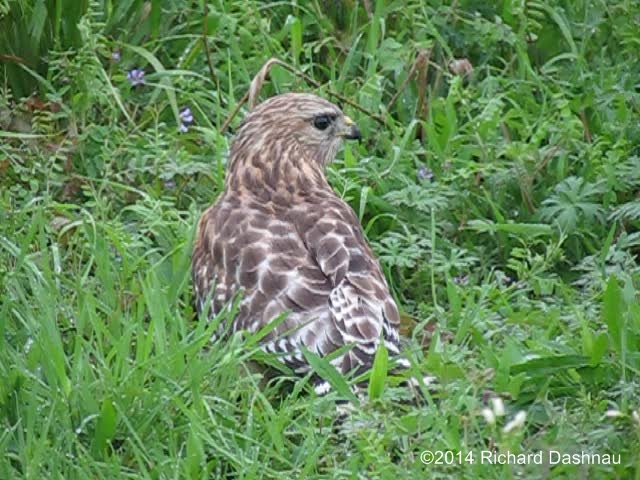
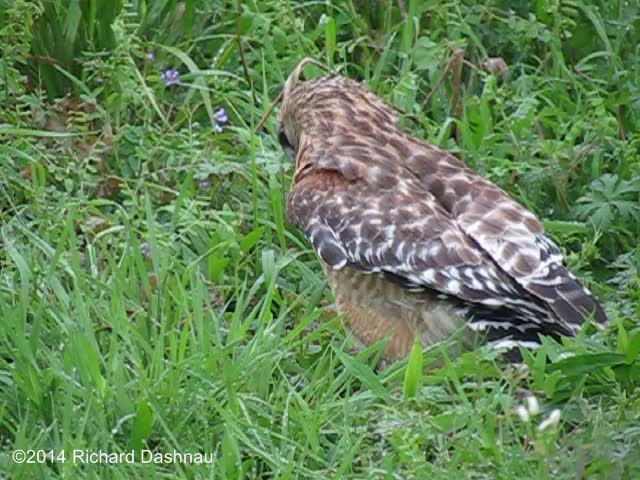
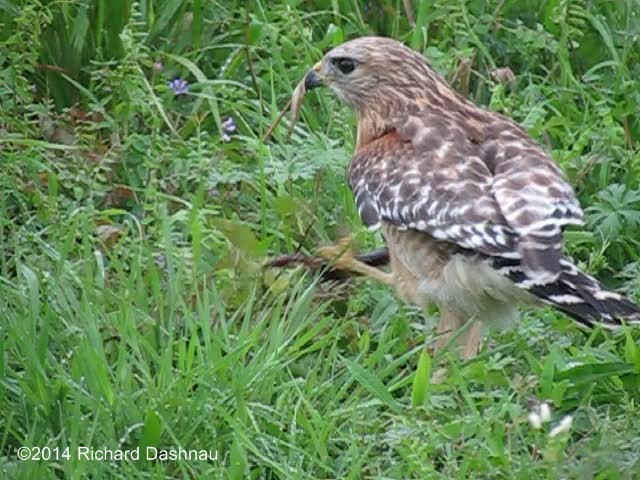
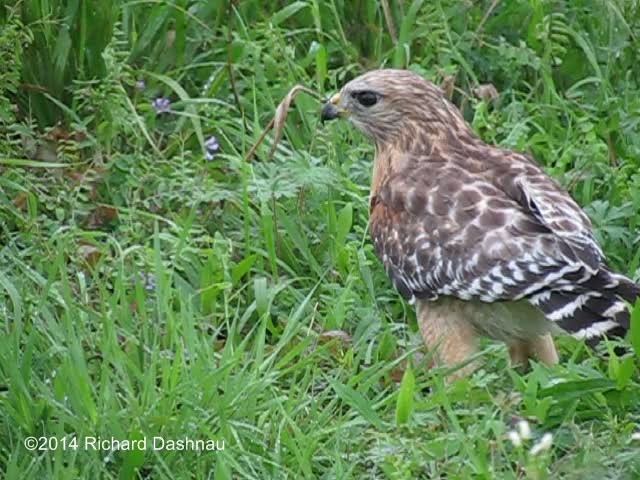
I
continued walking on the North side of the 40 Acre Lake trail, heading
East, towards the Observation Tower. At about 8:57am (just a few
minutes after the hawk had flown away), I noticed a large bird on top
of a broken tree near the
Observation Tower. The tree was on the East
side of the Trail, South of the tower. I was about 200 yards away from
the bird in the tree. When I looked through my binoculars, I could see
that it was a Bald Eagle! I quickly changed the
settings on my camera,
and used full zoom to look closer at the Eagle. I started shooting
video. The Eagle was eating...something, but there was no way I could
tell what it was. I stopped filming, and walked about 20 steps down
the
trail, hoping that I'd get be able to eventually get closer. When I
filmed again, the Eagle had stopped eating, but I shot some video
anyway--along with a zoom shot to give some sense of how far away I was.
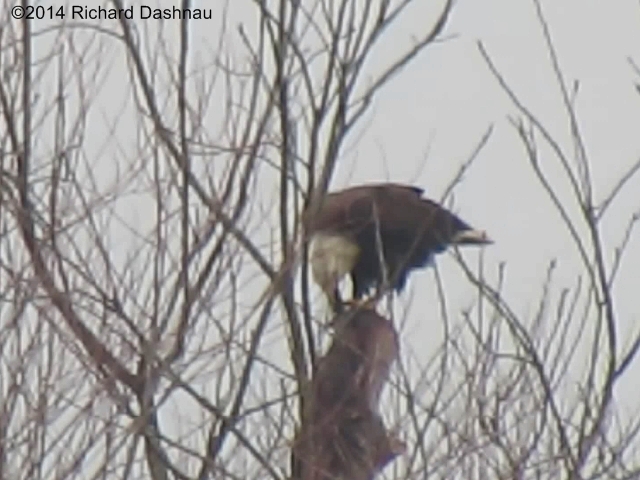
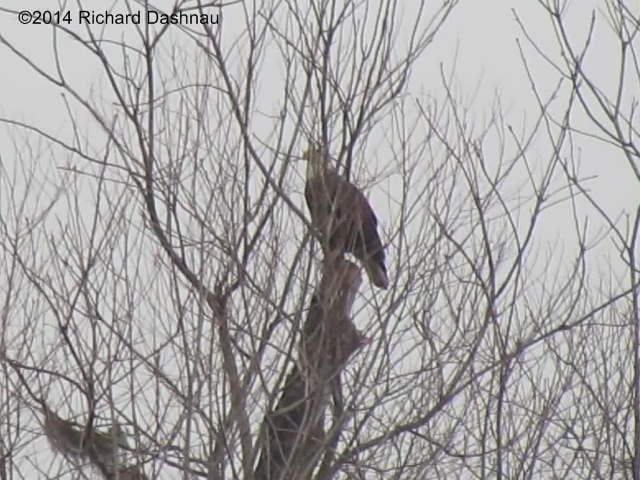
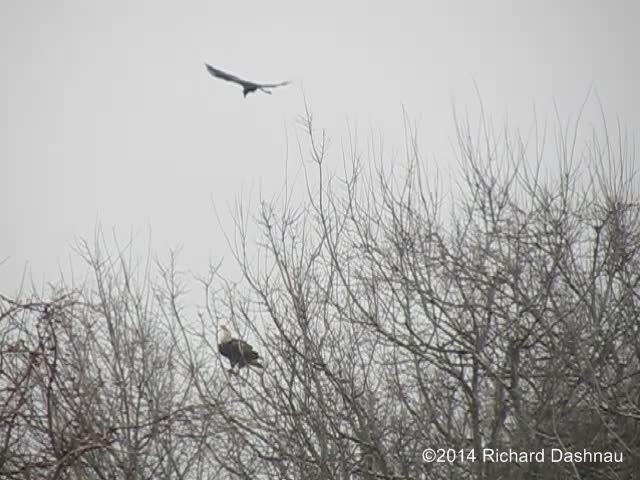
I
took a few more steps, and the Eagle took off--still over 100 yards
away. However, it looked like it flew further East on the Spillway
Trail, so I hurried over to the Observation Tower. When I got there, I
could see that the Eagle had landed
in a tree about 100 yards East of
the tower, right near the trail. So I quietly climbed to the
top of
the tower, and watched the Eagle. It was just below the top of the
tree, so my view of it was partially obscured by branches, but I took
some
pictures and video clips anyway. During time that I watched, crows
(or maybe the same crow) made some half-hearted attempts to harass the
eagle-but it was only one crow at a time. At about 9:30, the
Eagle
took off, and I tried, but failed,
to get good shots of it as it flew.
The Eagle flew West into the misty air until it flew out of sight.
January
13, 2013 Today
was rainy and cold. While some people in Houston were running around in
this nasty weather doing a marathon, or half of one; other people were
walking around the trails at Brazos Bend State Park in this
nasty
weather hoping to see a River Otter or a Bald Eagle. Both
predators have appeared at this time of year, especially during cold
weather and Otters have often shown themselves during or after rain.
Ok...maybe
not "other people". Maybe it was just *me* out there. And
there
were a couple fishermen at 40 Acre Lake. Anyway, after a couple hours
walking, at about 10 o'clock AM I was on the Elm Lake Trail between
piers 2 and 3.
I'd noticed that some of the groups of American
Coots were clumping on the banks. I'd seen a large hawk watching over
some of them, but that was at about 9 on the other end of the
lake. Vultures were kettling in small groups, circling
over head here and there. I
was facing North, when I looked up and towards the East at one of the
large circling birds. It had caught my eye. Flat wing
profile. A
quick look through binoculars--EAGLE!! But it was circling high. I was
able
to snap two shots at full optical zoom--having to focus between
shots. Then it was over the trees, circling West. I think I
only
had a few seconds of viewing time. But, I was
able to crop the pictures, and it was a Bald Eagle. This little
entry
is not because the pictures are great--but they do show that
it was a Bald Eagle. And that's
good enough for me.
-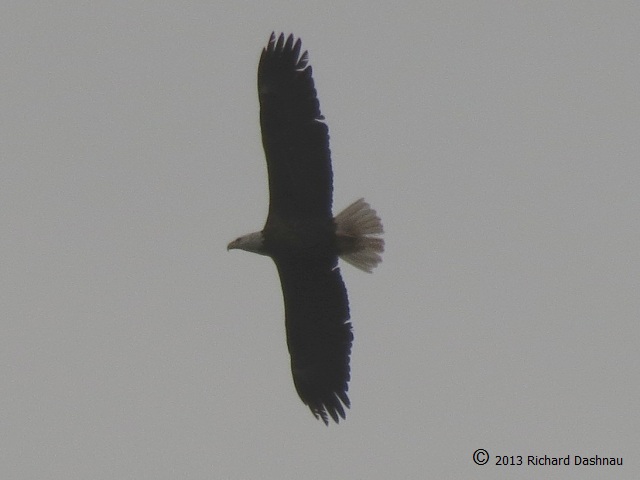
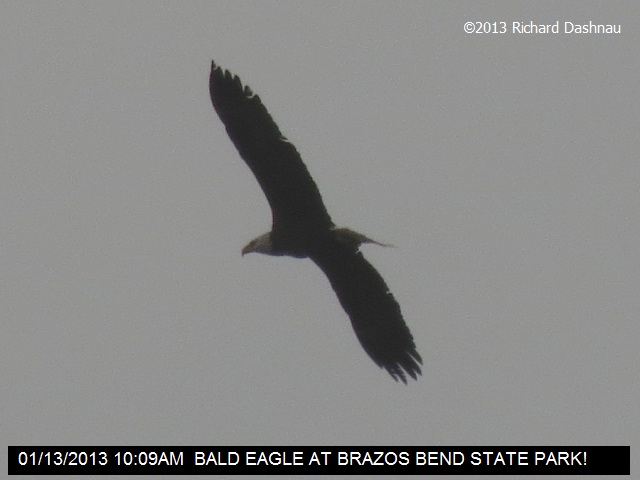
January
28, 2012--Eagle Update!! I
went out to Baytown again, this time with a different camera, and high
hopes. When I got there, there was one person already
watching
the nest, and he told me that he'd seen an Eagle fly off
earlier.
I
didn't wait too long (it was great weather, anyway), but I saw an Eagle
circling towards us. It circled closer, and closer...and CLOSER. I shot
a few photos as it passed overhead, but only one came out well. That's
the image below left.
I figured that the Eagle would land on the
nest, so I focused on the nest.--just in time. I started shooting
high-speed video (120fps) and caught the Eagle landing above the nest.
Then, to my great suprise, another Eagle landed next to it!!
The
edited video clip is here
(mp4).
Then, I shot a few more pictures, changing setting on the camera and
trying again, and was able to get a few good images. The two below
middle and right are a couple of these. Then, one Eagle
took
off
(which I missed), and then the other one took off. I left, too.
-- --
-- --
--
December
27, 2011; January 1,2, 14 2012 Ending one
year and beginning the next with Bald Eagles.
I
had some extra time off over the holidays, so I went to Baytown to see
if I could see the Bald Eagles around the nest I can find there. I got
there around 9:00 am. At about 11:00, I heard the cry of an Eagle, and
an answer from the nest.
And then, an Eagle appeared and landed on the
nest. I watched for some time, alternating through my camera
and
my binoculars, hoping that the Eagle would take off and fly my way. It
finally did! And, of course, my camera got hopelessly
entangled, and I
couldn't catch the Eagle when it first left. But, it came around and
circled above me, so I filmed it then. The middle image below
is
from the video clip, which is here(wmv).
-- --
-- --
--
I went back
the next day, but had no luck.
On
January 1, 2012, I was at Brazos Bend State Park. While I was near the
tower, looking for Otters and Eagles, and whatever else, Chuck pointed
across the lake, and there was an Eagle! I was able to shoot a few
pictures (altough far off)
before it dropped down into the rice. I
watched for a long time, and it finally reappeared, but flew off into
the west. The image above right is that Eagle. As I said, it was pretty
far off. One of these days I'll get a good photo or video of
an
Eagle
at BBSP. On the next
day, January 2nd, I went out to the
Baytown nest again. And I got to see an Eagle, but it stayed on the
nest. The image below left is of the Eagle that day.
-- --
-- --
--
Finally,
I went out to Baytown again on January 14, and got to see an Eagle
again. This time, it finally flew from then nest while I could film it.
It was pretty far off, but at least I got to try to shoot
video
of it flying. The image above right is a frame
from the video clip,
which is here(wmv).
Here are some Eagle facts, according to the the Texas Parks and
Wildlife web page. Here is the link;
and another link to a TPWD
pdf with a bit more information.
The
Bald Eagle (Haliaeetus leucocephalus) males are 3 feet long, head to
tail, weigh 7-10 lb, and have a wingspan of 6-7 feet. Females can be 14
lb with a wingspan up to 8 feet.
Bald Eagles will eat whatever is
available. They eat fish, waterfowl and other birds, small mammals, and
turtles. They will also eat carrion.
In Texas, Bald Eagles nest from
October to July. Peak egg-laying happens in December, with most
hatching in January. Females can lay 1-3 eggs, but usually 2.
A
second batch may be laid if the first batch is lost. Incubation begins
when the
first egg is laid, and lasts 34 - 36 days. The young fly from
the nest in 11 - 12 weeks, but the adults will feed them for another 4
-6 weeks while they learn how to hunt. When they finally fly off on
their own, young Eagles migrate north out of Texas,
but return by
September or October. In Texas, the Bald Eagle population is
split
into 2 types--breeding birds and non-breeding (wintering) birds.
Breeding populations are usually found in the Eastern half of Texas and
along coastal counties.
Non-breeding populations can be found in the
Panhandle, Centraland East Texas and other suitable habitats throughout
the state.
A bit more detail can be found in this study: PREY
OF NESTING BALD EAGLES
IN TEXAS
1995, David W. Mabie; M. Todd Merendino and David H. Reid(pdf) .
Here are some notes from that study:
From
February through May of 1985 - 1991, food remains were collected from
within and under nests representing 27 territories in Texas. 661 prey
items representing 46 species of vertebrates were found. The types of
prey were split almost
evenly into 3 types--Birds (33.7%), reptiles
(30.7%) and fish (30.1%). Mammals made up the last 5.5%. Bird
prey
remains were found in 92% of the nests. American Coots were by far the
most common (132) followed by Snow Geese (26) then
Northern Shovelers
(12) and Black-Bellied Whistling Ducks (10); followed by much smaller
numbers of other birds including Cattle Egrets (7) American Bitterns
(2), White Ibis (1) and Northern Harrier (1).
Reptile traces were
found in 41% of the nests. Surprising (to me) is that these were all
turtles. Most common were Softshell Turtles (182), followed by
MIssissippi Map turtles (6) and Razorback Musk turtles (6), Red-Eared
sliders (6), Common
Musk turtles (3) and finally (1) Ornate Box turtle.
Turtles were consistently found in nests associated with the Colorado,
Brazos, and Trinity rivers.
Fish Prey was found in 83% of the
nests. Various species of catfish were the most common (129), followed
by Carp (40), Crappie (16), Largemouth Bass (6), Gar (3), Gizzard shad
(3) and Striped bass (1). It has been mentioned that bottom-feeding
fish are more vulnerable to attack from above because their attention
is focused below, and that conditions that make these fish (such as
catfish) accessible to surface attack (like shallow water over
sandbars) would make them more likely to being
attacked by eagles.
Similar conditions that would allow for shallow water or basking
surfaces might make for more availability of basking turtles (like
Softshell turtles) in some areas.
Mammal remains were found in 33%
if the nests with Eastern Cottontails and swamp rabbits the most common
(23), followed by Eastern Fox Squirrels (3); Opossums (3), Nine-banded
Armadillos (2), and (1) each Striped Skunk, Plains Pocket
Gopher, Feral
Hog, Hispid cotton rat, and Black-tailed jackrabbit.
That's quite an
interesting array of food items. I was surprised by the number of
turtles. I also notice that there were no nutria, alligators, or snakes
found.
I'd hoped to get a hint of what to watch for while the
Eagles visit Brazos Bend State Park, but most of the prey items listed
in this study can be found at the park--many during nesting season. As
I write this (January) American Coots are the most
common noticeable
birds in the park (huge groups of them), but there are ducks many other
birds as well. When the winter weather is mild, many of the turtles
come out to bask. Swamp rabbits, cottontails, squirrels, armadillos
also live there.
I once heard a park visitor say the Bald Eagles
live in the park. This isn't exactly the case. Eagles *forage* in the
park. Or, Bald Eagles live in the park like you or I "live" in a
supermarket. Judging from that study, Brazos Bend State Park is
a
supermarket for Eagles.
11/29--11/30/2008--
Eagle, Osprey, and Ibis. On 11/29/2008, I decided to drive to the
Northwest
part of the Houston area, near Waller, Texas. I wanted to try out a new
camera, and I was hoping to find some Crested Caracaras. As I drove
around,
somewhat aimlessly, I found myself near the highway again. I
looked across
a field, and a small pond, and I noticed a car parked on the feeder
road,
and people near the car looking down into the field. I made drove until
I got near where the car
had been. I stopped and got out of the car. And
there, down on the grass near the water, was a Bald Eagle! It was
apparently
eating something, but was too far away to see what it was. I took some
pictures (and there were also a couple of Caracaras
in the field, too)
and then reached into my car for the video camera. I saw the eagle
flying
away. A truck had pulled in behind me, and that probably chased off the
eagle. I was still lucky to see it.
The
images below are two views of the same photo,
just cropped for clarity.
I also shot a short video clip of the eagle, which you can see here
(wmv 2.6 mb).
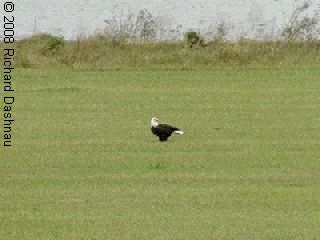 -
-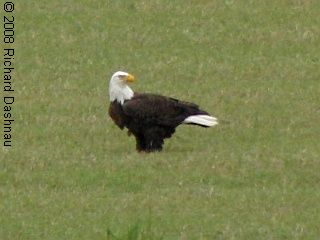
February
5, 12, 19, 26 and, March 5, 2006--
This
is how it started for me. On the morning of February 5, I walked down
the
40 Acre Lake trail at BBSP. I passed Hoot's Hollow and continued
towards
the observation tower. On the way I met the Bird Hike group
where
I spoke with David Heinicke
and John Bradford. David and John and
the
bird hikers got to see a Bald Eagle from 40-acre lake pier. They were
telling
me about it--still during their hike--when the eagle made another
appearance,
and we all got to watch it hovering at height of
the rice, and scaring
the bejabbers out of various waterfowl. I was able to film a
little
of this, but it was pretty far away. Still, I was excited about seeing
the eagle. You can see this short
clip (wmv 3850kb) of the eagle in the morning.
The
image below
is a frame from that clip.
------------------------------------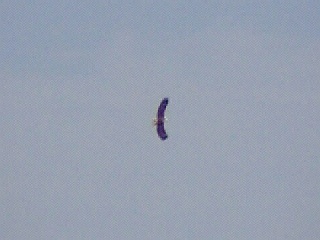
EAGLE
02/20/06
The
birders went on, and I moved to the tower, where Greg, a photographer
who
frequently visits the park, came up. Then, for no particular
reason,
Greg and I talked and just looked out over Pilant Lake and the general
area of the Observation tower.
We stayed there for about 5 hours.
There
was no need to go anywhere else, since a lot of things happened right
there.
During
the day, the eagle came back, about 5 or 6 times. I actually lost
count.
It seemed to always appear from the direction of the
far
treeline
on Pilant Lake (North of the our position), and would fly up towards
the
Mile Stretch (South). HOW COOL IS THAT?
Throughout
the day, Northern Harriers could be seen skimming above the tips of the
rice fields. Twice, we got to watch
as one,
then another of the Great Blue Herons picked up a large siren and ate
it.
On
one
of the eagle flybys, another raptor, an Osprey, began to
harrass
the eagle, flying above it and dropping down at the eagle.
Finally,
the eagle had enough,
and flew up towards the Harrier. They finally went
out of sight to the North over the far treeline.
A
King
Rail sauntered by.
At
another
time (remember this is ALL DURING THE SAME DAY), some park visitors
were
talking to us, and one of them expressed disappointment
at
not
seeing an American Bittern. Not long after this comment (maybe 5
minutes??)
Greg looked
to the left, and an American Bittern was doing
the
"ninja step" across the trail, going from 40 Acre Lake to Pilant Lake,
and not more than 20 yards away. So, the no-longer disappointed visitors
rushed
over to see it.
On
another
one of the eagle flyovers,
it passed over us, quite high, and then
when it was over the corner of 40 Acre Lake, it turned back towards
us
and
began diving towards the lake, looking like it might be targeting
something
in the water just a little south west of the wooden bridge. This
put
the eagle right where I was almost looking into the sun--so a
camera
was useless. Still, I could see its talons extended as it briefly
descended.
But,
it broke off, still far above the highest tree, and flew up
and continued
south.
Finally,
I guess around 3 o'clock, Greg decided to go look at Horseshoe Lake,
and
I decided to head back to the VC. I saw him stop at the culvert
(yes,
the one right by the tower)and squat down and start shooting (turns out
he was trying to get a snipe),
and I decided to try to shoot photos of
the
Bittern that had passed by before. I found the Bittern, and
as I
was moving around a tree to get a better angle, I had a feeling, and I
looked
up.
The Eagle was making another pass, and was flying straight towards
me;
but still out at the edge of the clearing in the rice. I wanted to move
back,
and looked down to be sure of my footing. I looked up, and I'd lost
sight
of the eagle. I got back up on the trail quickly, and looked just in
time
to see the eagle flying over the trail
on just the other side of the Observation
Tower. I watched it go by, let my eyes track down, and there
was
Greg pointing his camera up. He GOT it!
What
a cool day! You can see some of Greg's pictures from that day
here.
There
are 7 pictures on that page. I'm pretty sure the first 6 were taken
Feb.
5. There's a flock of waterfowl panicked by the approach of
the
eagle
from the above background; 2 shots of the Osprey and Eagle;
and 3 shots
of the eagle on that last approach
as it flew over Greg. Earlier
on Feb. 19th,
I was treated to a long sighting of a Bald Eagle hunting.
I didn't see a successful hunt, but watching the eagle work in the cold
and windy solitude of the park was a wonderful experience. The four
images
below
are taken from this video
clip. (wmv 20 mb). I haven't broken up the clip, so it's
about 3 minutes
long, and pretty big. But I love watching the Eagle for those 3 minutes
or so; and I think you will, too.
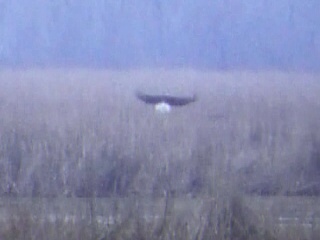 -
-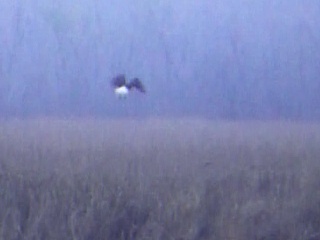 -
-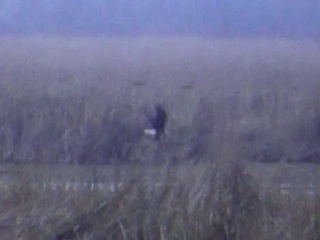 -
-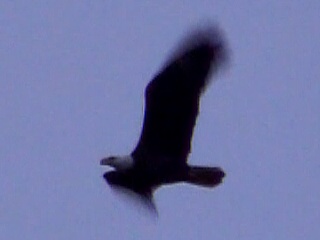 ----
----
EAGLE
SLOW
SWOOP
EAGLE HOVER
EAGLE
DROP
EAGLE PASSES BY
January
04, 2004Today's
weather was not bad for a winter's day. Although overcast, it was near
70 degrees. After arriving at the park, I was invited to join a short
expedition
(a few hours). The objective was to view a Bald Eagle's nest, hopefully
with adult
eagles in or near it. After arriving at the site,
we looked
around (I'd never seen a nest before). With my binoculars, I saw, off
in
a tree (hundreds of yards away), a dark spot with a white spot over it.
How I was able to pick this out is a mystery. Anyway, the
spotting scope
was brought over, and we took turns looking though it.
Let
me tell you how it felt when I peered into the eyepiece. There, up near
a break in the tree, was a Bald Eagle. Seeing this great bird through
the
glass, as it surveyed the field, was quite moving. Actually, most
raptors
have this effect on me. Their keen
scrutiny, the strength and beauty of
their forms...these things always make me pause. Once, at Brazos Bend
State
Park, I stood there gaping like an idiot as a Red-Tailed Hawk (I think)
flew down parallel to the islands, and moving up the pier
numbers,
came
right towards me (at the water station), and then turned over my head
and
flew down the Spillway Trail.
Watching
this eagle at rest, though vigilant, was a fine
experience.
Why? Maybe because we rarely see that which we hold in awe acting like
*we* might. "Taking it easy", so to speak. Also, I was fairly sure that
it could see us from all those hundreds of
yards away.
In any
case, I took my turns looking through the spotting scope, and watched
this
silent hunter as the wind ruffled its feathers from time to time. The
nest,
by the way, was about 3 trees over from this one. The image below
(FARAWAY
EAGLE)
was the best I could do for a photo. I borrowed Dylan's telephoto
attachment and got this (thanks, Dylan!). Unfortunately, "digiscoping"
is still beyond my abilities with my camera.
After
returning to the park, I was able to get out on the trails for a
while.
Alligators were out basking, although there was no sun, and some of
them
seemed to be exactly where I saw them last week.
Nice
way to start a year!
------------------------------------------------------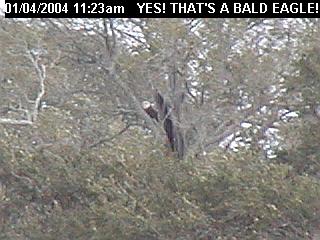
FARAWAY EAGLE
If
you'd like to know more about the park
follow these links:
Brazos
Bend State Park
The main page.
Brazos
Bend State Park Volunteer's Page The
volunteer's main page.
Go back to my home page, Welcome
to rickubis.com
Go
back to the RICKUBISCAM
page.
Go
back to the See
the World
page.





























































































































































 --
--








